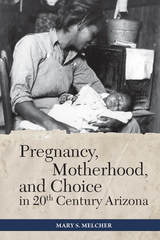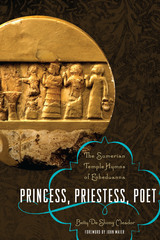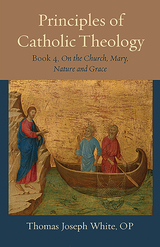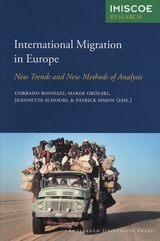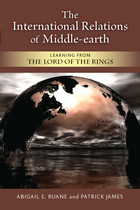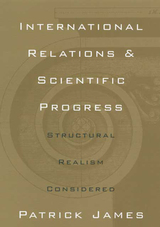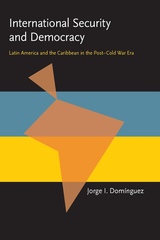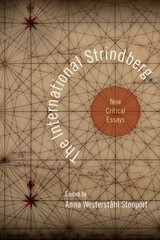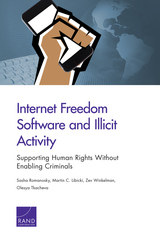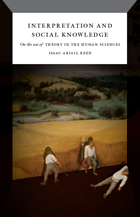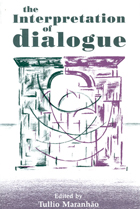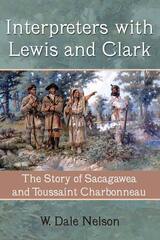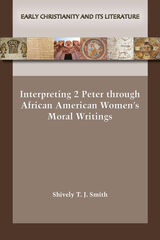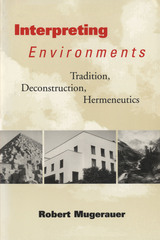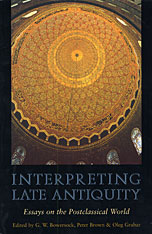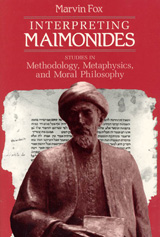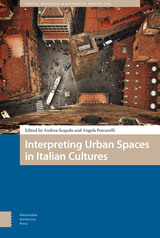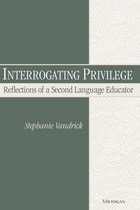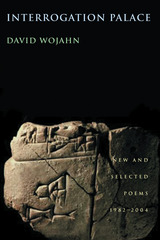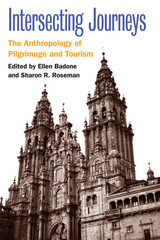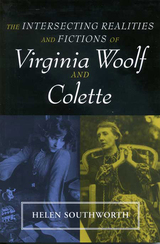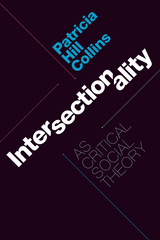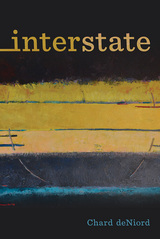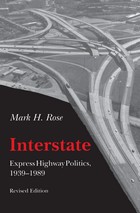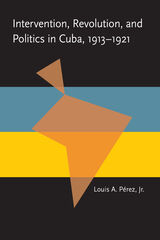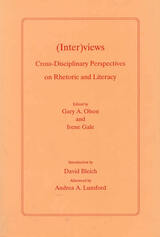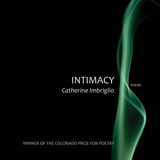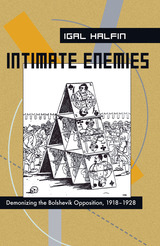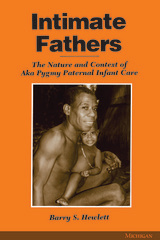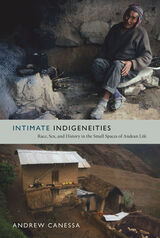International Migration in Europe: New Trends and New Methods of Analysis
Edited by Corrado Bonifazi, Marek Okólski, Jeanette Schoorl and Patrick Simon
Amsterdam University Press, 2008
Over the past twenty years, international migration issues become inescapably prominent in European public debate. Issues about the arrival of new immigrants and the problems of integration processes are rooted in the deep and vast changes that have characterized the recent history of European international migration. This volume addresses aspects of this migration through a variety of disciplinary perspectives, devoting particular attention to new forms of migration, the evolution of regional patterns, and the intergenerational process of migrant integration.
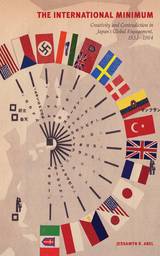 The International Minimum: Creativity and Contradiction in Japan’s Global Engagement, 1933-1964
Jessamyn R. Abel
University of Hawaii Press, 2015 The International Minimum is a history of internationalism, imperialism, and the performance of diplomacy in Japan at a time when new global norms required a minimum level of international engagement. Jessamyn Abel illuminates deep and nuanced connections between modes of diplomacy across periods of aggressive imperial expansion and times of peace from the 1930s to 1960s. Dispelling common assumptions of discordance between imperialism and internationalism, she convincingly demonstrates ways in which these worldviews complement each other. She offers innovative perspectives on the standard narrative of Japan’s approach to multilateral cooperation in three ways: by seriously considering those international activities conducted outside of formal statelevel relations, by exploring cultural forms of international engagement, and by asserting the importance of rhetoric in cultivating what was then referred to as an “international mind.” In clear and polished prose, Abel identifies a continuous evolution of internationalist thought and activity in Japan that extends across the dark valley of war and the historiographical schism of defeat, bringing new modes of multilateral cooperation. Her book traces the practice and rhetoric of internationalism through epochal moments of Japan’s twentieth-century international history, examining its withdrawal from the League of Nations and admission to the United Nations, the failed and successful attempts to host a Tokyo Olympiad, and wartime and postwar regional conferences in Tokyo and Bandung, Indonesia. Unpublished documents in government and private archives, together with the public discourse found in popular journals, books, newspapers, advertisements, poems, and songs, reveal historical layers of thought that helped delineate the realm of the possible in imperial and postwar Japanese foreign policy. By bringing together materials of high diplomacy and mass culture, Abel offers a new view of internationalism and Japanese diplomacy since the early twentieth century.
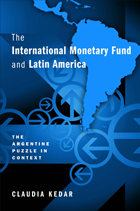 The International Monetary Fund and Latin America: The Argentine Puzzle in Context
Claudia Kedar
Temple University Press, 2013 The International Monetary Fund (IMF) has played a critical role in the global economy since the postwar era. But, claims Claudia Kedar, behind the strictly economic aspects of the IMF’s intervention, there are influential interactions between IMF technocrats and local economists—even when countries are not borrowing money. In The International Monetary Fund and Latin America, Kedar seeks to expose the motivations and constraints of the operations of both the IMF and borrowers. With access to never-before-seen archive materials, Kedar reveals both the routine and behind-the-scenes practices that have depicted International Monetary Fund–Latin American relations in general and the asymmetrical IMF-Argentina relations in particular. Kedar also analyzes the “routine of dependency” that characterizes IMF-borrower relations with several Latin American countries such as Chile, Peru, and Brazil. The International Monetary Fund and Latin America shows how debtor countries have adopted IMF’s policies during past decades and why Latin American leaders today largely refrain from knocking at the IMF’s doors again.
 The International Movie Industry
Edited by Gorham Kindem
Southern Illinois University Press, 2000 Movies are both art and commerce, creative expressions of national/cultural interests and preoccupations and part of a global entertainment market. The past century has witnessed a transformation of the movies from popular novelties into highly valued cultural icons and commodities that have promoted national identity and specific political agendas, while also affecting international trade. This comprehensive history of the international movie industry from its inception in 1895 to the present features nineteen original essays by international scholars who examine the film industries of nineteen countries and six continents. Each chapter in The International Movie Industry focuses on a specific national movie industry’s economic and related social, aesthetic, technological, and political/ideological development within an international context during the last century. The result is a global history of the movie industry over the last one hundred years.
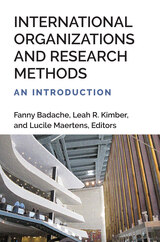 International Organizations and Research Methods: An Introduction
Fanny Badache, Leah R. Kimber and Lucile Maertens, Editors
University of Michigan Press, 2023 Scholars have studied international organizations (IOs) in many disciplines, thus generating important theoretical developments. Yet a proper assessment and a broad discussion of the methods used to research these organizations are lacking. Which methods are being used to study IOs and in what ways? Do we need a specific methodology applied to the case of IOs? What are the concrete methodological challenges when doing research on IOs? International Organizations and Research Methods: An Introduction compiles an inventory of the methods developed in the study of IOs under the five headings of Observing, Interviewing, Documenting, Measuring, and Combining. It does not reconcile diverging views on the purpose and meaning of IO scholarship, but creates a space for scholars and students embedded in different academic traditions to reflect on methodological choices and the way they impact knowledge production on IOs.
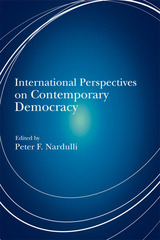 International Perspectives on Contemporary Democracy
Edited by Peter F. Nardulli
University of Illinois Press, 2007 Democracy enjoys unparalleled prestige at the beginning of the twenty-first century as a form of government. Some of the world's most prosperous nations are democracies, and an array of nations in Europe, Africa, and South America have adopted the system. This globalization has also met resistance and provoked concerns about international power exerted by institutions and elites that are beyond the control of existing democratic institutions. In this volume, leading scholars of democracy engage the key questions about how far and how fast democracy can spread, and how international agencies and international cooperation uneasily affect national democracies. At first glance, the efforts of intergovernmental organizations to intervene in a nation's governance seem anything but democratic to that nation. The contributors demonstrate why democracy has been so attractive and so successful, but are also candid about what limits it may reach, and why. Contributors are Lisa Anderson, Larry Diamond, Zachary Elkins, John R. Freeman, Brian J. Gaines, James H. Kuklinski, Peter F. Nardulli, Melissa A. Orlie, Buddy Peyton, Paul J. Quirk, Wendy Rahn, Bruce Russett, and Beth Simmons.
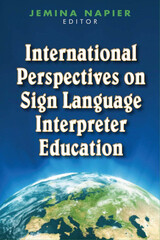 International Perspectives on Sign Language Interpreter Education
Jemina Napier
Gallaudet University Press, 2009 The Fourth Volume in the Interpreter Education Series
From the moment the World Association of Sign Language Interpreters (WASLI) was established in 2005, an overwhelming wave of requests from around the world arrived seeking information and resources for educating and training interpreters. This new collection provides those answers with an international overview on interpreter training from experts in Austria, Australia, Brazil, Canada, Fiji, Finland, Ireland, Japan, Kenya, Kosovo, the Netherlands, New Zealand, Scotland, Sweden, and the United States. Whether from income-rich or income-poor countries, the 31 contributors presented here provide insights on how sign language interpreter training has developed in each nation, and also how trainers have dealt with the difficulties that they encountered.
Many of the contributors relate the movement away from ad hoc short courses sponsored by Deaf communities. They mark the transition from the early struggles of trainers against the stigmatization of sign languages to full-time degree programs in institutions of higher education funded by their governments. Others investigate how culture, religion, politics, and legislation affect the nurturing of professional sign language interpreters, and they address the challenges of extending training opportunities nationally through the use of new technology. Together, these diverse perspectives offer a deeper understanding and comparison of interpreter training issues that could benefit the programs in every nation.
 International Perspectives on Sign Language Translator and Interpreter Education
Jemina Napier
Gallaudet University Press, 2024 The field of sign language translator and interpreter (SLTI) education gets a global treatment in this new volume helmed by editors Jemina Napier, Stacey Webb, and Robert Adam. This second edition updates the information from the 2009 volume and adds new contributions that expand the scope of the work to include additional countries and topic areas. SLTI scholars and educators will benefit from these international perspectives and gain an improved understanding of this rapidly evolving discipline.
Each chapter, authored collaboratively by deaf and hearing educators, surveys general interpreter education and training, examines the status of the profession for both deaf and hearing practitioners, and addresses specific challenges faced within the different national frameworks. Contributors also discuss ongoing and future trends, including the impact of the Covid-19 pandemic on educational practices.
This volume disseminates extensive knowledge on sign language translator and interpreter education, covering established programs as well as ad hoc training, and highlighting effective teaching pedagogies and structured classroom strategies. Contributors emphasize a holistic approach to the field, integrating SLTI education, the current profession, future practitioners, and deaf communities. Although the state of the field varies widely around the world depending on the national context, this volume reveals a shared goal of advancing professional standards and improving the provision of service to deaf people worldwide.
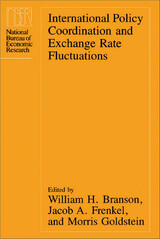 International Policy Coordination and Exchange Rate Fluctuations
Edited by William H. Branson, Jacob A. Frenkel, and Morris Goldstein
University of Chicago Press, 1990 Since the five largest industrial democracies concluded the Plaza Agreement in 1985, the theory and practice of international economic policy coordination has become the subject of spirited academic and public-policy debate. While some view policy coordination as crucial for the construction of an improved international monetary system, others fear that it risks delaying or weakening the implementation of macroeconomic and structural policies.
In these papers and comments, prominent international economists consider past and present interpretations of the meaning of international policy coordination; conditions necessary for coordination to be beneficial both to the direct participants and the global economy; influential factors for the quantitative impact of coordination; obstacles to coordination; the most—and least—effective methods of coordination; and future directions of the coordination process, including processes associated with greater fixity of exchange rates.
These studies will be readily accessible to policymakers, while offering sophisticated analyses to interested scholars of the global economy.
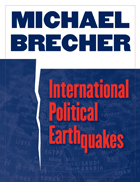 International Political Earthquakes
Michael Brecher
University of Michigan Press, 2008 International Political Earthquakes is the masterwork of the preeminent scholar Michael Brecher. Brecher, who came of age before World War II, has witnessed more than seven decades of conflict and has spent his career studying the dynamics of relations among nations throughout the world. When terrorism, ethnic conflict, military buildup, or other local tensions spark an international crisis, Brecher argues that the structure of global politics determines its potential to develop into open conflict. That conflict, in turn, may then generate worldwide political upheaval. Comparing international crises to earthquakes, Brecher proposes a scale analogous to the Richter scale to measure the severity and scope of the impact of a crisis on the landscape of international politics. Brecher's conclusions about the causes of international conflict and its consequences for global stability make a convincing case for gradual, nonviolent approaches to crisis resolution. Michael Brecher is R. B. Angus Professor of Political Science at McGill University.
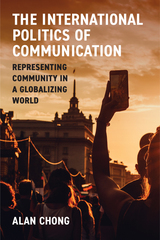 The International Politics of Communication: Representing Community in a Globalizing World
Alan Chong
University of Michigan Press, 2025 In an era of globalization, international communication constantly takes place across borders, defying sovereign control as it influences opinion. While diplomacy between states is the visible face of international relations, this “informal diplomacy” is usually less visible but no less powerful. Information politics can be found in propaganda, Internet politics, educational exchanges, tourism, and even popular film.
The International Politics of Communication examines this informational dimension of international politics, investigating how information is generated, conveyed through channels, and directed specifically at audiences. While citizens are often portrayed as faithfully loyal supporters and beneficiaries of the modern nation-state—a fiction supported by passports, identification papers, and other notarized credentials—they are subject to the pulls of loyalty from transnational tribal affiliations, mythological and historical narratives of ethnicity, as well as the transcendental claims of religion and philosophy. Increasingly, social media also enchants non-state individuals, providing new virtual communities as the center of loyalties rather than national affiliations. By reinterpreting taken-for-granted concepts in journalism, media, political economy, nationalism, development, and propaganda as information politics, this book prepares serious-minded scholars, citizens, politicians, and social activists everywhere to understand the power plays in international communication and use alternatives to begin transforming power relations.
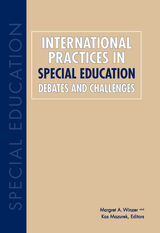 International Practices in Special Education: Debates and Challenges
Margret A. Winzer
Gallaudet University Press, 2011 Margret A. Winzer and Kas Mazurek combine two disciplines in this collection, comparative and international studies and special education, to explore the ways that diverse nations respond to persons who are exceptional. Their learned contributors also explore the changing parameters of special education, employing comparative studies theories and methods to document, explore, discuss, and analyze social and educational inclusion. International Practices in Special Education: Debates and Challenges travels the world to examine the progress of special education, from inclusive reform in Canada, “education for all” in the United Kingdom, the reform-restructure-renew movement in Poland to the journey from awareness to action in the United States. Chapters describe the challenges and opportunities in the United Arab Emirates; conflicts regarding educational welfare in South Korea; new perspectives on special needs and inclusive education in Japan; facing inclusion in India; making the invisibles visible in Pakistan; problems and prospects in Nigeria; special needs education in Ethiopia; and the developments, prospects, and demands of special education in a rising China. “One step forward, two steps backward” describes Israel’s special education issues. Germany’s special education receives an international perspective; and education policy and pedagogy for students with disabilities in Australia, completes the analyses in this remarkable, comprehensive work of scholarship.
International Propaganda: Its Legal and Diplomatic Control
L. John Martin
University of Minnesota Press, 1958 International Propaganda was first published in 1958. Minnesota Archive Editions uses digital technology to make long-unavailable books once again accessible, and are published unaltered from the original University of Minnesota Press editions. As the principal weapon of the cold war, international propaganda is a matter of grave importance to anyone concerned with international relations. Here, in the first study of its kind, Dr. Martin analyzes the efforts and trends toward the control of such propaganda by means of international law, domestic law, and diplomacy. As a background for his study, he traces the development of international propaganda, discusses its definitions, and describes the propaganda activities of the three giants in the field - the United States, Great Britain, and the Soviet Union.
The International Protection of Industrial Property
Stephen P. Ladas
Harvard University Press This study presents to the English-speaking legal profession a synthetic picture of the international regime of industrial property, by a method which combines the common-law and the civil-law technique. The first part considers the international regime of industrial property before the constitution of the Industrial Property Union in 1883, as it was governed by the municipal law of various countries and bipartite agreements. The second, and main, part surveys the protection and relation of industrial property at the present time in the Industrial Property Union. In a separate section of this part, the inter-American regime of industrial property under the Pan-American conventions is described. The last part deals with the future development of industrial property and the efforts for the protection of scientific property.
The International Relations of Middle-earth: Learning from The Lord of the Rings
Abigail E. Ruane and Patrick James
University of Michigan Press, 2012 Based on their successful undergraduate course at the University of Southern California, Abigail E. Ruane and Patrick James provide an introduction to International Relations using J. R. R. Tolkien's fantastically popular trilogy The Lord of the Rings. Because Tolkien's major themes---such as good versus evil and human agency versus determinism---are perennially relevant to International Relations, The Lord of the Rings is well suited for application to the study of politics in our own world. This innovative combination of social science and humanities approaches to illustrate key concepts engages students and stimulates critical thinking in new and exciting ways.
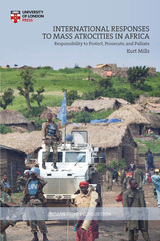 International Responses to Mass Atrocities in Africa: Responsibility to Protect, Prosecute, and Palliate
Kurt Mills
University of London Press, 2015 Since the end of World War II and the founding of the United Nations, genocide, crimes against humanity, and other mass atrocities have been explicitly illegal. When such crimes are committed, the international community has an obligation to respond, which has come to be known as “the responsibility to protect.”
Parallel to this responsibility, two related responsibilities have developed: to prosecute those responsible for the crimes, and to provide humanitarian relief to the victims—what Kurt Mills in this book calls the “responsibility to palliate.” While this rhetoric of protection is well used by the international community, its application in practice has been erratic at best. In International Responses to Mass Atrocities in Africa, Mills develops a typology of responses to mass atrocities, considering four cases in Rwanda, the Democratic Republic of the Congo, Uganda, and Darfur. Putting the cases into historical context and analyzing them according to this typology, Mills investigates the limitations of these responses and calls for such responses to be implemented in a more timely and thoughtful manner. Mills provides critical analysis of the possibilities for the international community to respond to humanitarian crises in the future.
 The International Rule of Law Movement: A Crisis of Legitimacy and the Way Forward
David Marshall
Harvard University Press Promoting the rule of law at the national and international levels is at the heart of the United Nations’ mission and is a principle embedded throughout the Charter of the United Nations and most constitutions of nation-states. The 2012 “Declaration on the Rule of Law at the National and International Levels” adopted by the General Assembly reaffirmed that human rights, the rule of law, and democracy were interlinked and mutually reinforcing, and that they belonged to the universal and indivisible core values and principles of the United Nations. To some, the “Rule of Law” has become nothing more than empty rhetoric of individual Western states and intergovernmental bodies such as the UN, The World Bank, and the EU. In addition to conceptual uncertainty and perceived hidden agendas, there is mounting skepticism, particularly among donors, regarding rule of law promotion and its effectiveness in fragile states.
The International Rule of Law Movement critically evaluates rule of law initiatives from a contemporary global perspective. It seeks to fill the gap in knowledge among actors and to explain what has and has not been effective and why. It also proposes better models for promoting justice and the rule of law in fragile states.
International Security and Democracy: Latin America and the Caribbean in the Post-Cold War Era
Jorge I. Dominguez
University of Pittsburgh Press, 1998 Domínguez has drawn together fifteen leading scholars on international relations and comparative politics from Latin America, the Caribbean, and the United States, thus bringing to bear varying national perspectives from several corners of the hemisphere to analyze the intersection between regional security issues and the democracy building process in Latin America.
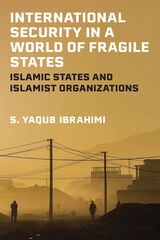 International Security in a World of Fragile States: Islamic States and Islamist Organizations
S. Yaqub Ibrahimi
University of Michigan Press, 2022 Following the 9/11 attacks on New York and Washington, DC, there has been an increasing interest among scholars, students, and the interested public to study and learn about the Islamist-oriented terrorist organizations called Jihadi Salafi Groups (JSGs). Considering that these organizations emerged in highly fragile states, S. Yaqub Ibrahimi asks: how and why is state fragility linked to the emergence of JSGs?
Ibrahimi bases his study on three events: the establishment of al-Qaeda in Afghanistan in 1998, the rise of Islamic State in the post-Saddam Hussein Iraq, and the failed al-Qaeda effort to establish a base in Saudi Arabia in 2003. These case studies contain major aspects and features of the rise of JSGs and, together, explain the contribution of state fragility to the process of the formation and expansion of these terrorist organizations.
International Security in a World of Fragile States stands out as a pivotal work on the interconnection between the root causes of JSGs and state fragility conditions and their amalgamated role in the formation and evolution of these organizations. It contributes to IR and international security debates by developing a comprehensive but readily understandable narrative of the rise of JSGs in Islamic countries, and examining them in an analytical framework in which their root causes are categorized on individual, group, and international levels.
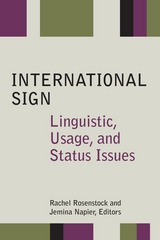 International Sign: Linguistic, Usage, and Status Issues
Rachel Rosenstock
Gallaudet University Press, 2015 International Sign (IS) is widely used among deaf people and interpreters at international events, but what exactly is it, what are its linguistic features, where does its lexicon come from, and how is it used at interpreted events? This groundbreaking collection is the first volume to provide answers to these questions.
Editors Rachel Rosenstock and Jemina Napier have assembled an international group of renowned linguists and interpreters to examine various aspects of International Sign. Their contributions are divided into three parts: International Sign as a Linguistic System; International Sign in Action—Interpreting, Translation, and Teaching; and International Sign Policy and Language Planning. The chapters cover a range of topics, including the morphosyntactic and discursive structures of interpreted IS, the interplay between conventional linguistic elements and nonconventional gestural elements in IS discourse, how deaf signers who use different signed languages establish communication, Deaf/hearing IS interpreting teams and how they sign depicting verbs, how best to teach foundation-level IS skills, strategies used by IS interpreters when interpreting from IS into English, and explorations of the best ways to prepare interpreters for international events.
The work of the editors and contributors in this volume makes International Sign the most comprehensive, research-based analysis of a young but growing field in linguistics and interpretation.
International Socialism and the World War
Merle Fainsod
Harvard University Press Although the World War served to accentuate the sharp differences in ideology and tactics which already existed among the various branches of the socialist movement, it emphasized the official continuity between socialist theory and the application of that theory under stress of war. From the beginning, however, the growth of the Left School, which was committed to efforts towards transforming the war between nations into a war between classes, had most significance. Their prestige was immeasurably increased by the triumph of the Bolsheviks in Russia, and at length the meeting of the Communist International at Moscow in March 1919 completed the disintegration of the Second International. Mr Fainsod, who has made a thorough study of the sources, presents an illuminating account of events both within and without the socialist party.
The International Strindberg: New Critical Essays
Anna Westerståhl Stenport
Northwestern University Press, 2012 This fine collection of essays offers a wide range of new and original perspectives on Strindberg and his relation to modern and contemporary literature. By using Strindberg as a fulcrum or spring board, the volume opens a unique and unusual historical perspective on Europe and European literature. One of the important values of The International Strindberg is that it will appeal to a variety of readers, since the essays cover such a diverse range of approaches. The introduction is particularly impressive because it both sets up the value of looking at Strindberg from a twenty-first century perspective and suggests how that can and should be done. The volume demonstrates the variety of ways in which Strindberg’s work can be seen and discussed in light of twentieth and even twenty-first century literature.
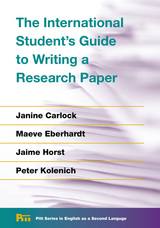 The International Student's Guide to Writing a Research Paper
Janine Carlock, Maeve Eberhardt, Jaime Horst, Peter Kolenich
University of Michigan Press, 2017 The International Student’s Guide to Writing a Research Paper is a reference text for undergraduate students and those in ESL or bridge courses who are writing a research paper for the first time. This book is partly an update of Writing a Research Paper (by Lionel Menasche, 1998) and partly a companion to The ESL Writer’s Handbook. Each section of the book includes a discrete task called a Building Block, which requires students to apply the skills learned toward the development of their own paper. This step-by-step approach allows students to construct knowledge as they become more familiar with the process, making writing a research paper a less intimidating task. Special features: - This guide uses simple direct language for those for whom writing a research paper is new.
- Most example writing is from international students in an ESL program or first-year writing class, including two sample papers—one in APA and one in MLA.
- A section on responding to instructor feedback to provide students with the tools to read and understand comments and use them to improve the first draft.
- A subsection dedicated to constructing clear and cohesive paragraphs and sentences.
- The guide includes citation and style examples in MLA 8th edition.
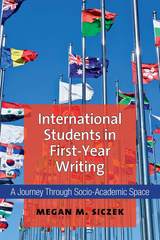 International Students in First-Year Writing: A Journey Through Socio-Academic Space
Megan M. Siczek
University of Michigan Press, 2018 The book explores the journey of 10 international students to better understand their experiences at a U.S. educational institution and how they constructed and revealed these experiences in this particular socio-academic space. The study features a series of three interviews during the semester that the participants were enrolled in a mainstream first-year writing course; their stories not only capture their experiences but reveal inspiring stories that “give voice” to students outside the dominant cultural and linguistic community. This study raises questions about how to support international students: - In what ways can it inform our practices and policies relative to the internationalization of education and the development of global perspectives and competencies?
- What does it reveal that could impact daily instruction of L2 writing, particularly when it comes to international students’ need to meet the expectations of “university-level writing” in U.S. institutions of higher education?
- On an individual level, what can we learn from these students and about ourselves as a result of our interactions?
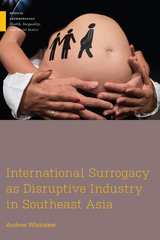 International Surrogacy as Disruptive Industry in Southeast Asia
Whittaker, Andrea
Rutgers University Press, 2019 During the last two decades, a new form of trade in commercial surrogacy grew across Asia. Starting in India, a “disruptive” model of surrogacy offered mass availability, rapid accessibility, and created new demands for surrogacy services from people who could not afford or access surrogacy elsewhere.
In International Surrogacy as Disruptive Industry in Southeast Asia, Andrea Whittaker traces the development of this industry and its movement across Southeast Asia following a sequence of governmental bans in India, Nepal, Thailand, and Cambodia. Through a case study of the industry in Thailand, the book offers a nuanced and sympathetic examination of the industry from the perspectives of the people involved in it: surrogates, intended parents, and facilitators. The industry offers intended parents the opportunity to form much desired families, but also creates vulnerabilities for all people involved. These vulnerabilities became evident in cases of trafficking, exploitation, and criminality that emerged in southeast Asia, leading to greater scrutiny on the industry as a whole. Yet the trade continues in new flexible hybrid forms, involving the circulation of reproductive gametes, embryos, surrogates, and ova donors across international borders to circumvent regulations. The book demonstrates the need for new forms of regulation to protect those involved in international surrogacy arrangements.
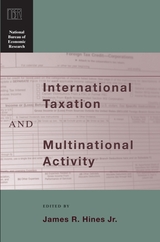 International Taxation and Multinational Activity
Edited by James R. Hines Jr.
University of Chicago Press, 2001 Because the actions of multinational corporations have a clear and direct effect on the flow of capital throughout the world, how and why these firms behave the way they do is a major issue for national governments and their policymakers. With an unprecedented ability to adjust the scale, character, and location of their global operations, international corporations have become increasingly sensitive to the kind and degree of tax obligations imposed on them by both host and home countries. Tax rules affect the volume of foreign direct investment, corporate borrowing, transfer pricing, dividend and royalty payments, and research and development. National governments that tax the profits of international firms face important challenges in designing tax policies to attract them. This collection examines the global ramifications of tax policies, offering up-to-date, theoretically innovative, and empirically sound perspectives on a problem of immense significance to future economic growth around the globe.
 International Trade and Human Rights: Foundations and Conceptual Issues (World Trade Forum, Volume 5)
Frederick M. Abbott, Christine Breining-Kaufmann and Thomas Cottier, Editors
University of Michigan Press, 2005 The World Trade Forum 2001 on Trade and Human Rights addressed some of the most controversial and challenging issues in the ongoing public debate on globalization: the relationship between institutions and norms regulating global economic activity and institutions and norms promoting and protecting human rights. Presenting a selection of the papers discussed at the Forum, this volume focuses on a significant, developing area of international law certain to become increasingly important in the years to come, as both scholarship and jurisprudence continue to explore the boundaries of the intersection of the two fields. With a diverse array of contributors, International Trade and Human Rights addresses the relationship between human rights and international trade from a unique and important interdisciplinary perspective.
The missing link between the international trade regime and human rights has become one of the key concerns of critics of the WTO. The World Trade Forum 2001 at the World Trade Institute in Berne provided a unique framework for considering the manifold issues relevant to this topic. This book goes beyond listing the different arguments in favor of or against globalization and offers recommendations to the international community for possible reforms so as to better account for the human rights interests affected by the process of globalization.
Frederick M. Abbott is the Edward Ball Eminent Scholar Professor of International Law at Florida State University College of Law. He is the editor of China in the World Trading System: Defining the Principles of Engagement (1998) and author of The International Intellectual Property System: Commentary and Materials (with Thomas Cottier and Francis Gurry, 1999).
Christine Breining-Kaufmann is Professor of Law at the University of Zurich and Senior Research Fellow as well as a member of the Board of the World Trade Institute in Berne. Her publications include Hunger als Rechtsproblem: Völkerrechtliche Aspekte eines Rechtes auf Nahrung (1991) and Globalization and Labour Rights: The Conflicting Relationship between Core Labour Rights and International Economic Institutions (2006).
Thomas Cottier is Managing Director of the World Trade Institute and Professor of Law at the University of Berne. He has co-edited the previous four volumes of the World Trade Forum series.
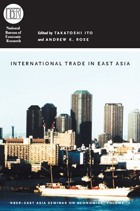 International Trade in East Asia
Edited by Takatoshi Ito and Andrew K. Rose
University of Chicago Press, 2005 The practice of trading across international borders has undergone a series of changes with great consequences for the world trading community, the result of new trade agreements, a number of financial crises, the emergence of the World Trade Organization, and countless other less obvious developments. In International Trade in East Asia, a group of esteemed contributors provides a summary of empirical factors of international trade specifically as they pertain to East Asian countries such as China, Japan, Korea, and Taiwan.
Comprised of twelve fascinating studies, International Trade in East Asia highlights many of the trading practices between countries within the region as well as outside of it. The contributors bring into focus some of the region's endemic and external barriers to international trade and discuss strategies for improving productivity and fostering trade relationships. Studies on some of the factors that drive exports, the influence of research and development, the effects of foreign investment, and the ramifications of different types of protectionism will particularly resonate with the financial and economic communities who are trying to keep pace with this dramatically altered landscape.
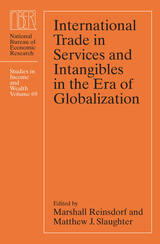 International Trade in Services and Intangibles in the Era of Globalization
Edited by Marshall B. Reinsdorf and Matthew J. Slaughter
University of Chicago Press, 2009 Quantitative measures of international exchange have historically focused on trade in tangible products or capital. However, services have recently become a larger portion of developed economies and international trade, and will only increase in the future. In International Trade in Services and Intangibles in the Era of Globalization, Marshall Reinsdorf and Matthew J. Slaughter examine new and emerging patterns of trade, especially the growing importance of transactions involving services or intangible assets such as intellectual property. A distinguished team of contributors analyzes the challenges involved in measuring trade in intangibles, the comparative advantages enjoyed by United States service industries, and the heightened international competition for jobs, capital investment, economic growth, and tax revenue that results from trade in services. This comprehensive volume will be necessary reading for scholars seeking to understand the rapidly changing global economy.
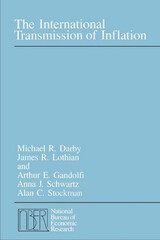 The International Transmission of Inflation
Michael R. Darby, James R. Lothian, Arthur E. Gandolfi, Anna J. Schwartz, and Al
University of Chicago Press, 1984 Inflation became the dominant economic, social, and political problem of the industrialized West during the 1970s. This book is about how the inflation came to pass and what can be done about it. Certain to provoke controversy, it is a major source of new empirical information and theoretical conclusions concerning the causes of international inflation.
The authors construct a consistent data base of information for eight countries and design a theoretically sound model to test and evaluate competing hypotheses incorporating the most recent theoretical developments. Additional chapters address an impressive variety of issues that complement and corroborate the core of the study. They answer such questions as these: Can countries conduct an independent monetary policy under fixed exchange rates? How closely tied are product prices across countries? How are disturbances transmitted across countries?
The International Transmission of Inflation is an important contribution to international monetary economics in furnishing an invaluable empirical foundation for future investigation and discussion.
 International Trotskyism, 1929-1985: A Documented Analysis of the Movement
Robert J. Alexander
Duke University Press, 1991 In a work of encyclopedic scope, International Trotskyism, 1929–1985 is sure to become the definitive reference work on a movement that has had a significant impact on the political culture of countries in every part of the world for more than half a century.
Renowned scholar Robert J. Alexander has amassed, from disparate sources, an unprecedented amount of primary and secondary material to provide a documentary history of the origins, development, and nature of the Trotskyist movement around the world. Drawing on interviews and correspondence with Trotskyists, newspaper reports and pamphlets, historical writings including the annotated writings of Trotsky in both English and French, historical memoirs of Trotskyist leaders, and documents of the Fourth International, Alexander recounts the history of the movement since Trotsky’s exile from the Soviet Union in 1929.
Organized alphabetically in a double-column, country-by-country format this book charts the formation and growth of Trotskyism in more than sixty-five countries, providing biographic information about its most influential leaders, detailed accounts of Trotsky’s personal involvement in the development of the movement in each country, and thorough reports of its various factions and splits. Multiple chapters are reserved for countries where the movement was more active or fully developed and various chapters are organized around crucial thematic issues, such as the Fourth International. The chapters are followed by extensive name, organization, publication, and subject indexes, which provide optimal access to the wealth of information contained in the main body of the work.
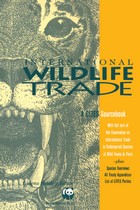 International Wildlife Trade: A Cites Sourcebook
Edited by Ginette Hemley; Foreword by Kathryn S. Fuller
Island Press, 1994 For more than two decades, the Convention on International Trade in Endangered Species of Wild Fauna and Flora, known as CITES, has been one of the largest and most effective conservation agreements in the world. By regulating international commerce in certain species -- from African elephants and exotic birds to hardwoods and bulbs -- the treaty limits trade in species that are in genuine need of protection while allowing controlled trade in species that can withstand some level of exploitation. In addition to explaining how CITES operates, this definitive reference includes: - the full text of the CITES treaty
- CITES Appendices I, II, and III
- a list of Parties as of March 1994
- a list of reservations by Parties as of October 1993
Chapters address the status of highly threatened species such as elephants, rhinos, and tigers as well as other heavily exploited species including parrots, primates, and bears. International Wildlife Trade provides a valuable overview of wildlife trade issues, and of the strengths and weaknesses of the current treaty.
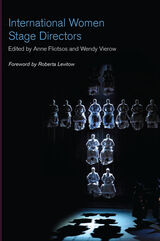 International Women Stage Directors
Edited by Anne Fliotsos and Wendy Vierow
University of Illinois Press, 2013 A fascinating study of women in the arts, International Women Stage Directors is a comprehensive examination of women directors in twenty-four diverse countries. Organized by country, chapters provide historical context and emphasize how social, political, religious, and economic factors have impacted women's rise in the theatre, particularly in terms of gender equity. Contributors tell the stories of their home country's pioneering women directors and profile the most influential women directors practicing today, examining their career paths, artistry, and major achievements. Contributors are Ileana Azor, Dalia Basiouny, Kate Bredeson, Mirenka Cechová, Marié-Heleen Coetzee, May Farnsworth, Anne Fliotsos, Laura Ginters, Iris Hsin-chun Tuan, Maria Ignatieva, Adam J. Ledger, Roberta Levitow, Jiangyue Li, Lliane Loots, Diana Manole, Karin Maresh, Gordon McCall, Erin B. Mee, Ursula Neuerburg-Denzer, Claire Pamment, Magda Romanska, Avra Sidiropoulou, Margaretta Swigert-Gacheru, Alessandra Vannucci, Wendy Vierow, Vessela S. Warner, and Brenda Werth.
 Internationalism and Its Betrayal
Micheline R. IshayForeword by Craig Calhoun
University of Minnesota Press, 1995 Internationalism and Its Betrayal was first published in 1995. Minnesota Archive Editions uses digital technology to make long-unavailable books once again accessible, and are published unaltered from the original University of Minnesota Press editions. A new world order, proclaimed Western leaders after the cold war, could extend liberal democracy and human rights around the globe. Yet the specter of nationalism once again haunts the world, threatening to extinguish the spirit of internationalism. Although internationalism is typically understood to be diametrically opposed to nationalism, Micheline Ishay argues to the contrary, maintaining that internationalism often incorporates an individualist element that manifests itself as nationalism during critical periods such as war. For example, the new liberal internationalism invoked after the cold war is now revealing its limits-as reflected by the UN's inability to interfere promptly to stop ethnic and nationalist conflicts in Bosnia, Rwanda, and elsewhere. Internationalism and Its Betrayal explores the tensions and contradictions between ideas of nationalism and internationalism, focusing on the major political thinkers from the early modern period into the nineteenth century. Ishay examines the writings of Vico, Grotius, Rousseau, Kant, Paine, Robespierre, Burke, Fichte, de Maistre, and Hegel. She speaks to an audience of individuals interested in the spread of democracy, students of human rights and international relations, historians of the French Revolution, and political theorists.
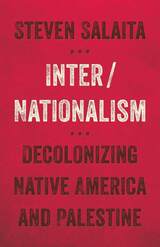 Inter/Nationalism: Decolonizing Native America and Palestine
Steven Salaita
University of Minnesota Press, 2016 “The age of transnational humanities has arrived.” According to Steven Salaita, the seemingly disparate fields of Palestinian Studses and American Indian studies have more in common than one may think. In Inter/Nationalism, Salaita argues that American Indian and Indigenous studies must be more central to the scholarship and activism focusing on Palestine. Salaita offers a fascinating inside account of the Boycott, Divestment, and Sanctions (BDS) movement—which, among other things, aims to end Israel’s occupation of Palestinian land. In doing so, he emphasizes BDS’s significant potential as an organizing entity as well as its importance in the creation of intellectual and political communities that put Natives and other colonized peoples such as Palestinians into conversation. His discussion includes readings of a wide range of Native poetry that invokes Palestine as a theme or symbol; the speeches of U.S. President Andrew Jackson and early Zionist thinker Ze’ev Jabotinsky; and the discourses of “shared values” between the United States and Israel. Inter/Nationalism seeks to lay conceptual ground between American Indian and Indigenous studies and Palestinian studies through concepts of settler colonialism, indigeneity, and state violence. By establishing Palestine as an indigenous nation under colonial occupation, this book draws crucial connections between the scholarship and activism of Indigenous America and Palestine.
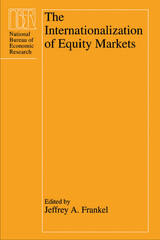 The Internationalization of Equity Markets
Edited by Jeffrey A. Frankel
University of Chicago Press, 1994 This timely volume addresses three important recent trends in the internationalization of United States equity markets: extensive market integration through foreign investment and links among stock prices around the world; increasing securitization as countries such as Japan come to rely more than ever before on markets in equities and bonds at the expense of banks; and the opening of national financial systems of newly industrializing countries to international financial flows and institutions, as governments remove capital controls and other barriers.
Eight essays examine such issues as the current extent of international market integration, gains to U.S. investors through international diversification, home-country bias in investing, the role of time and location around the world in stock trading, and the behavior of country funds. Other, long-standing questions about equity markets are also addressed, including market efficiency and the accuracy of models of expected returns, with a particular focus on variances, covariances, and the price of risk according to the Capital Asset Pricing Model.
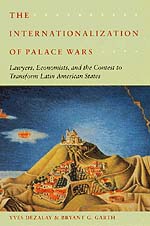 The Internationalization of Palace Wars: Lawyers, Economists, and the Contest to Transform Latin American States
Yves Dezalay and Bryant G. Garth
University of Chicago Press, 2002 How does globalization work? Focusing on Latin America, Yves Dezalay and Bryant G. Garth show that exports of expertise and ideals from the United States to Argentina, Brazil, Chile, and Mexico have played a crucial role in transforming their state forms and economies since World War II.
Based on more than 300 extensive interviews with major players in governments, foundations, law firms, universities, and think tanks, Dezalay and Garth examine both the production of northern exports such as neoliberal economics and international human rights law and the ways they are received south of the United States. They find that the content of what is exported and how it fares are profoundly shaped by domestic struggles for power and influence—"palace wars"—in the nations involved. For instance, challenges to the eastern intellectual establishment influenced the Reagan-era export of University of Chicago-style neoliberal economics to Chile, where it enjoyed a warm reception from Pinochet and his allies because they could use it to discredit the previous regime.
Innovative and sophisticated, The Internationalization of Palace Wars offers much needed concrete information about the transnational processes that shape our world.
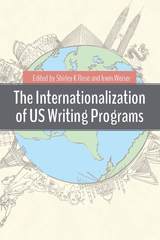 The Internationalization of US Writing Programs
Shirley K Rose
Utah State University Press, 2018 The Internationalization of US Writing Programs illuminates the role writing programs and WPAs play in defining goals, curriculum, placement, assessment, faculty development, and instruction for international student populations. The volume offers multiple theoretical approaches to the work of writing programs and illustrates a wide range of well-planned writing program–based empirical research projects. As of 2016, over 425,000 international students were enrolled as undergraduates in US colleges and universities, part of a decade-long trend of increasing numbers of international students coming to the United States for both undergraduate and graduate degrees. Writing program administrators and writing teachers across the country are beginning to recognize this changing demographic as a useful catalyst for change in writing programs, which are tasked with preparing all students, regardless of initial level of English proficiency, for academic and professional writing. The Internationalization of US Writing Programs is the first collection to focus specifically on this crucial aspect of the roles and responsibilities of WPAs, who are leading efforts to provide all students on their campuses, regardless of nationality or first language, with competencies in writing that will serve them in the academy and beyond. Contributors: Jonathan Benda, Michael Dedek, Christiane Donahue, Chris W. Gallagher, Kristi Girdharry, Tarez Samra Graban, Jennifer E. Haan, Paula Harrington, Yu-Kyung Kang, Neal Lerner, David S. Martins, Paul Kei Matsuda, Heidi A. McKee, Libby Miles, Susan Miller-Cochran, Matt Noonan, Katherine Daily O’Meara, Carolina Pelaez-Morales, Stacey Sheriff, Gail Shuck, Christine M. Tardy, Stanley Van Horn, Daniel Wilber, Margaret Willard-Traub
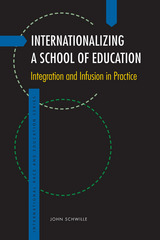 Internationalizing a School of Education: Integration and Infusion in Practice
John Schwille
Michigan State University Press, 2016 Internationalizing a School of Education examines how Michigan State University has pursued internationalization and globalization through an integration-infusion approach to research, teaching, and outreach. The integration-infusion approach was introduced in MSU’s College of Education in the early 1980s as a replacement for the more disconnected comparative education program. This approach offers a vision where all faculty members and students are knowledgeable about education in all its international diversity, where their conceptions and aspirations are influenced by international research and experience, and where they reach out to other countries in collaborative efforts to do research, inform policy, and improve practice. Featuring profiles of faculty members and students who were leaders of this integration-infusion approach, this text provides a survey of the landscape of comparative education in the United States while examining channels of internationalization specific to MSU, highlighting the success of integration-infusion at an institutional level.
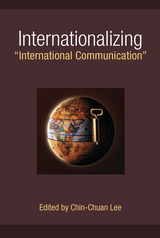 Internationalizing "International Communication"
Chin-Chuan Lee, editor
University of Michigan Press, 2015 International communication as a field of inquiry is, in fact, not very “internationalized.” Rather, it has been taken as a conceptual extension or empirical application of U.S. communication, and much of the world outside the West has been socialized to adopt truncated versions of Pax Americana’s notion of international communication. At stake is the “subject position” of academic and cultural inquirers: Who gets to ask what kind of questions? It is important to note that the quest to establish universally valid “laws” of human society with little regard for cultural values and variations seems to be running out of steam. Many lines of intellectual development are reckoning with the important dimensions of empathetic understanding and subjective consciousness. In Internationalizing "International Communication," Lee and others argue that we must reject both America-writ-large views of the world and self-defeating mirror images that reject anything American or Western on the grounds of cultural incompatibility or even cultural superiority. The point of departure for internationalizing “international communication” must be precisely the opposite of parochialism – namely, a spirit of cosmopolitanism. Scholars worldwide have a moral responsibility to foster global visions and mutual understanding, which forms, metaphorically, symphonic harmony made of cacophonic sounds.
 The Internet and Society
O'Reilly & Associates and H. T. Kung
Harvard University Press In the Spring of 1996, hundreds of international leaders in business, law, government, and education gathered at Harvard University to discuss the growing and future impact of the Internet: one of the most potent technological innovations of this century. This volume, which includes the writings, discussion transcripts, and computer demonstrations from this ground-breaking forum, provides an expert assessment of the impact of this rapidly changing technology on business, government, media, and education for the next decade and into the new millennium.
CEOs and leaders of Microsoft, Apple Computer, Sun Microsystems, and Digital Equipment Corporation join dozens of business leaders in providing both first-hand accounts of current revolutionary changes in the computer industry, as well as their attending influence on the future of the organization, its workers, its customer relations, and the creation and ownership of products themselves. While these pieces serve as an excellent source for understanding today's hottest Internet technologies, they also explore the important issues regarding precisely what is at stake for a society with greater and growing ties to cyberspace.
Topics in this timely collection include privacy and security, property rights, censorship, telecommunications regulation, and the global impact of emerging Internet technologies.
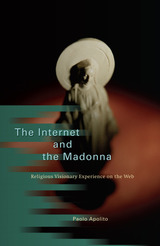 The Internet and the Madonna: Religious Visionary Experience on the Web
Paolo Apolito
University of Chicago Press, 2005 In 1994, a devout Catholic woman from Vermont began having religious visions and hearing the voice of the Virgin Mary. To spread word about her mystical experiences, she turned to the Internet. As Paolo Apolito records here, she is only one of many people who use the Web as a tool of religious devotion. Every day, thousands of Catholics—from Italy and Latin America to the United States and Bosnia—use the Internet to describe and celebrate apparitions of Mary, to exchange relics and advice in chat rooms, to make pilgrimages to religious Web sites, and to practice the rites of their faith online.
But how has this potent new mix of technology and religiosity changed the way Catholics view their faith? And what challenges do the autonomous qualities of the Internet pose to the broader authority of Catholicism? Does the democratic nature of access to digital technologies constitute a return to a more archaic and mystical form of Catholicism that predates the modernizing reforms of the Second Vatican Council?
In working through these questions, Apolito considers visions of Mary on the Web over the past two decades, revealing a great deal about religion as it is now experienced through new information technologies. The Internet, he explains, has made possible a decentralized community of the devoted, even as it has absorbed God into the shifts and complexities of electronic circuitry. And this profound development in religious life will only accelerate as use of the Internet spreads around the world.
An indispensable guide to the future of Catholicism, The Internet and the Madonna offers a compelling glimpse into the spiritual life of the connected soul.
Internet and Wireless Security
Robert Temple
The Institution of Engineering and Technology, 2002 Many organisations are transforming their businesses through the development of information and communications technologies. The security of this e-commerce is now a key enabler for businesses, and this book presents an overview of current and future infrastructures for e-business security.
 The Internet Challenge to Television
Bruce M. Owen
Harvard University Press, 1999 After a half-century of glacial creep, television technology has begun to change at the same dizzying pace as computer software. What this will mean--for television, for computers, and for the popular culture where these video media reign supreme--is the subject of this timely book. A noted communications economist, Bruce Owen supplies the essential background: a grasp of the economic history of the television industry and of the effects of technology and government regulation on its organization. He also explores recent developments associated with the growth of the Internet. With this history as a basis, his book allows readers to peer into the future--at the likely effects of television and the Internet on each other, for instance, and at the possibility of a convergence of the TV set, computer, and telephone.
The digital world that Owen shows us is one in which communication titans jockey to survive what Joseph Schumpeter called the "gales of creative destruction." While the rest of us simply struggle to follow the new moves, believing that technology will settle the outcome, Owen warns us that this is a game in which Washington regulators and media hyperbole figure as broadly as innovation and investment. His book explains the game as one involving interactions among all the players, including consumers and advertisers, each with a particular goal. And he discusses the economic principles that govern this game and that can serve as powerful predictive tools.
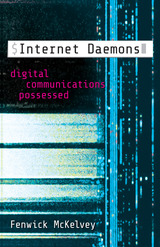 Internet Daemons: Digital Communications Possessed
Fenwick McKelvey
University of Minnesota Press, 2018 A complete history and theory of internet daemons brings these little-known—but very consequential—programs into the spotlight
We’re used to talking about how tech giants like Google, Facebook, and Amazon rule the internet, but what about daemons? Ubiquitous programs that have colonized the Net’s infrastructure—as well as the devices we use to access it—daemons are little known. Fenwick McKelvey weaves together history, theory, and policy to give a full account of where daemons come from and how they influence our lives—including their role in hot-button issues like network neutrality.
Going back to Victorian times and the popular thought experiment Maxwell’s Demon, McKelvey charts how daemons evolved from concept to reality, eventually blossoming into the pandaemonium of code-based creatures that today orchestrates our internet. Digging into real-life examples like sluggish connection speeds, Comcast’s efforts to control peer-to-peer networking, and Pirate Bay’s attempts to elude daemonic control (and skirt copyright), McKelvey shows how daemons have been central to the internet, greatly influencing everyday users. Internet Daemons asks important questions about how much control is being handed over to these automated, autonomous programs, and the consequences for transparency and oversight.
 The Internet Is for Cats: How Animal Images Shape Our Digital Lives
Jessica Maddox
Rutgers University Press, 2023 LOL cats. Grumpy Cat. Dog-rating Twitter. Pet Instagram accounts. It’s generally understood the internet is for pictures of cute cats (and dogs, and otters, and pandas). But what motivates people to make and share these images, and how do they relate to other online social practices?
The Internet is for Cats examines how animal images are employed to create a lighter, more playful mood, uniting users within online spaces that can otherwise easily become fractious and toxic. Placing today’s pet videos, photos, and memes within a longer history of mediated animal images, communication scholar Jessica Maddox also considers the factors that make them unique. She explores the roles that animals play within online economies of cuteness and attention, as well as the ways that animal memes and videos respond to common experiences of life under neoliberalism.
Conducting a rich digital ethnography, Maddox combines observations and textual analysis with extensive interviews of the people who create, post and share animal media, including TikTok influencers seeking to make their pets famous, activists tweeting about wildlife conservation, and Redditors upvoting every cute cat photo. The Internet is for Cats will leave you with a new appreciation for the human social practices behind the animal images you encounter online.
 The Internet Myth: From the Internet Imaginary to Network Ideologies
Paolo Bory
University of Westminster Press, 2020 ‘The Internet is broken and Paolo Bory knows how we got here. In a powerful book based on original research, Bory carefully documents the myths, imaginaries, and ideologies that shaped the material and cultural history of the Internet. As important as this book is to understand our shattered digital world, it is essential for those who would fix it.’ — Vincent Mosco, author of The Smart City in a Digital World The Internet Myth retraces and challenges the myth laying at the foundations of the network ideologies – the idea that networks, by themselves, are the main agents of social, economic, political and cultural change. By comparing and integrating different sources related to network histories, this book emphasizes how a dominant narrative has extensively contributed to the construction of the Internet myth while other visions of the networked society have been erased from the collective imaginary. The book decodes, analyzes and challenges the foundations of the network ideologies looking at how networks have been imagined, designed and promoted during the crucial phase of the 1990s. Three case studies are scrutinized so as to reveal the complexity of network imaginaries in this decade: the birth of the Web and the mythopoesis of its inventor; and the histories of two Italian networking projects, the infrastructural plan Socrate and the civic network Iperbole, the first to give free Internet access to citizens. The Internet Myth thereby provides a compelling and hidden sociohistorical narrative in order to challenge one of the most powerful myths of our time. This title has been published with the financial assistance of the Fondazione Hilda e Felice Vitali, Lugano, Switzerland.
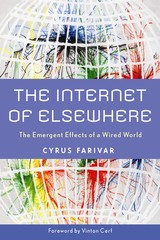 The Internet of Elsewhere: The Emergent Effects of a Wired World
Farivar, Cyrus
Rutgers University Press, 2011 Through the lens of culture, The Internet of Elsewhere looks at the role of the Internet as a catalyst in transforming communications, politics, and economics. Cyrus Farivar explores the Internet's history and effects in four distinct and, to some, surprising societies—Iran, Estonia, South Korea, and Senegal. He profiles Web pioneers in these countries and, at the same time, surveys the environments in which they each work. After all, contends Farivar, despite California's great success in creating the Internet and spawning companies like Apple and Google, in some areas the United States is still years behind other nations. Surprised? You won't be for long as Farivar proves there are reasons that: - Skype was invented in Estonia—the same country that developed a digital ID system and e-voting;
- Iran was the first country in the world to arrest a blogger, in 2003;
- South Korea is the most wired country on the planet, with faster and less expensive broadband than anywhere in the United States;
- Senegal may be one of sub-Saharan Africa's best chances for greater Internet access.
The Internet of Elsewhere brings forth a new complex and modern understanding of how the Internet spreads globally, with both good and bad effects.
The Internet of Medical Things: Enabling technologies and emerging applications
Subhendu Kumar Pani
The Institution of Engineering and Technology, 2022 The Internet of Medical Things (IoMT) allows clinicians to monitor patients remotely via a network of wearable or implantable devices. The devices are embedded with software or sensors to enable them to send and receive data via the internet so that healthcare professionals can monitor health data such as vital statistics, metabolic rates or drug delivery regimens, and can provide advice or treatment plans based on this real-world, real-time data. This edited book discusses key IoT technologies that facilitate and enhance this process, such as computer algorithms, network architecture, wireless communications, and network security.
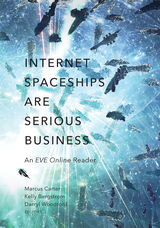 Internet Spaceships Are Serious Business: An EVE Online Reader
Marcus Carter
University of Minnesota Press, 2016 EVE Online is a socially complex, science-fiction-themed universe simulation and massively multiplayer online game (MMOG) first released in 2003. Notorious for its colossal battles and ruthless player culture, it has hundreds of thousands of players today. In this fascinating book, scholars, players, and EVE’s developer (CCP Games) examine the intricate world of EVEOnline--providing authentic accounts of lived experience within a game with more than a decade of history and millions of “real” dollars behind it. Internet Spaceships Are Serious Business features contributions from outstanding EVE Online players, such as The Mittani, an infamous member of the game’s community, as well as academics from around the globe. They cover a wide range of subjects: the game’s technicalities and its difficulty; its projection of humanity’s future in space; the configuration of its unique, single-server game world; the global nature of warfare in its “nullsec” territory (and how EVE players have formed a global concept of time); stereotypes of Russian players; espionage play; in-game memorials to Vile Rat (aka U.S. State Department official Sean Smith, murdered in the 2012 Benghazi attack); its gendered playing experience; and CCP Games’ relationship with players; and its history and legacy. Internet Spaceships Are Serious Business is a must for EVE Online players interested in a broad perspective on their all-consuming game. It is also accessible to scholars, game designers seeking to understand and replicate the successful aspects unique to EVE Online, and even those who have never played this notoriously complex game. Contributors: William Sims Bainbridge, National Science Foundation; Chribba; Jedrzej Czarnota; Kjartan Pierre Emilsson; Dan Erdman; Rebecca Fraimow; Martin R. Gibbs, U of Melbourne; Catherine Goodfellow; Kathryn Gronsbell; Keith Harrison; Kristin MacDonough; Mantou (Zhang Yuzhou); Oskar Milik; The Mittani (Alexander Gianturco); Joji Mori; Richard Page; Christopher Paul, Seattle U; Erica Titkemeyer, U of North Carolina at Chapel Hill; Nick Webber, Birmingham City U.
 Internships in the Private Sector: How You Can Find, Prepare for, and Thrive in Them
Charles A. Fishkin
University of Chicago Press A practical, start-to-finish guide to securing an internship in the private sector and making the most of the transition from student to professional.
Every year, college students across the country seek internships to build experience in their chosen fields. In this highly competitive job market, students and recent graduates need to seek out every possible opportunity to differentiate themselves and demonstrate that they are ready to roll up their sleeves and get to work. One important way to do so is an internship in the private sector, which can lead to a full-time job with a well-regarded organization. Yet the process of finding an internship can appear challenging. This book can make it easier.
For more than a decade, finance professional Charles Fishkin has been preparing students to thrive in internship programs. In this book, he shares his advice for those who are seeking a private-sector internship. With insights relevant to a variety of fields—from finance to the tech sector—he covers the process from start to finish, beginning with exploring the range of internship opportunities available. Several chapters offer advice on best practices for crafting effective resumes, networking, and interviewing to get the position. Fishkin offers checklists, action items, real-life scenarios, and practical suggestions, each arising from the experiences of former interns and hiring managers. The heart of the book focuses on the nine to twelve weeks of the internship itself, with tips on how to interact with supervisors and colleagues, how to learn and apply new skills, and how to solve problems and address challenges that arise.
Internships in the Private Sector is the first full-length guide to securing and making the most of an internship. This book will help level the playing field, providing students with the tools and support they need to perform to the fullest extent of their abilities and lay the foundation for a strong start to their careers.
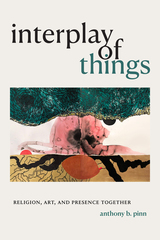 Interplay of Things: Religion, Art, and Presence Together
Anthony B. Pinn
Duke University Press, 2021 In Interplay of Things Anthony B. Pinn theorizes religion as a technology for interrogating human experiences and the boundaries between people and other things. Rather than considering religion in terms of institutions, doctrines, and creeds, Pinn shows how religion exposes the openness and porousness of all things and how they are always involved in processes of exchange and interplay. Pinn examines work by Nella Larsen and Richard Wright that illustrates an openness between things, and he traces how pop art and readymades point to the multidirectional nature of influence. He also shows how Ron Athey's and Clifford Owens's performance art draws out inherent interconnectedness to various cultural codes in ways that reveal the symbiotic relationship between art and religion as a technology. Theorizing that antiblack racism and gender- and class-based hostility constitute efforts to close off the porous nature of certain bodies, Pinn shows how many artists have rebelled against these attempts to counter openness. His analyses offer a means by which to understand the porous, unbounded, and open nature of humans and things.
 Interpretation and Social Criticism
Michael Walzer
Harvard University Press, 1987 What do social critics do? I How do they go about doing it? Where do their principles come from? How do critics establish their distance from the people and institutions they criticize?
Michael Walzer addresses these problems in succinct and engaging fashion, providing a philosophical framework for understanding social criticism as a social practice. Walzer maintains that social criticism is an ordinary activity—less the offspring of scientific knowledge than the “educated cousin of common complaint”—and does not depend for its force or accuracy upon any sort of high theory. In his view, the social critic is not someone radically detached and disinterested, who looks at society as a total stranger and applies objective and universal principles. The true social critic must stand only a little to the side of his society—unlike Jean-Paul Sartre during the Algerian war, for example, who described himself as an enemy of his own people. And unlike Lenin, who judged Russian society against a standard worked out with reference to other places far away.
The “connected” critic is the model Walzer offers, one whose distance is measured in inches but who is highly critical nevertheless. John Locke is one example of the connected critic who argued for religious toleration not as a universal right ordained by reason but as a practical consequence of Protestant theology. The biblical prophets, such as Amos, were also men of their own day, with a particular quarrel to conduct with their fellows; the universalism of that quarrel is our own extrapolation. Walzer explains where critical principles come from, how much distance is “critical distance,” and what the historical practice of criticism has actually been like in the work of social philosophers such as Marx, Gramsci, Koestler, Lenin, Habermas, and Rawls.
Walzer posits a moral world already in existence, a historical product, that gives structure to our lives but whose ordinances are always uncertain and in need of scrutiny, argument, and commentary. The social critic need bring to his task only the ordinary tools of interpretation. Philosophers, political theorists, and all readers seriously interested in the possibility of a moral life will find sustenance and inspiration in this book.
Interpretation and Social Knowledge: On the Use of Theory in the Human Sciences
Isaac Ariail Reed
University of Chicago Press, 2011 For the past fifty years anxiety over naturalism has driven debates in social theory. One side sees social science as another kind of natural science, while the other rejects the possibility of objective and explanatory knowledge. Interpretation and Social Knowledge suggests a different route, offering a way forward for an antinaturalist sociology that overcomes the opposition between interpretation and explanation and uses theory to build concrete, historically specific causal explanations of social phenomena.
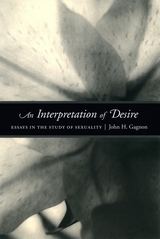 An Interpretation of Desire: Essays in the Study of Sexuality
John Gagnon
University of Chicago Press, 2003 An Interpretation of Desire offers a bracing collection of major essays by John Gagnon, one of the leading and most inspiring figures in sexual research. Spanning his work from the 1970s, when he explored the idea that sexuality is mediated through social processes and categories—thus paving the way for Foucault—and then extending through his turn to issues of desire during the 1990s, these essays constitute an essential entrée to the study of sexuality in the twentieth century.
Gagnon may be best known as the coauthor of Sexual Conduct—a book that introduced the seminal concept of sexual scripting—and as one of the coauthors of The Social Organization of Sexuality, a foundational work that is widely considered to be the most important study of human sexual behavior since the Kinsey report. The essays collected here first trace the influence of scripting theory on Gagnon, outlining the radical departure he took from the dominant biological and psychiatric models of sex research. The volume then turns to more recent essays that consider such vexed issues as homosexuality, the theories of Sigmund Freud, HIV, hazardous sex, and the social aspects of sexually transmitted diseases.
The Interpretation of Dialogue
Edited by Tulio Maranhão
University of Chicago Press, 1990 This superb collection offers an array of rich variations on a theme central to a multitude of disciplines: the nature of dialogue. Drawing on literary, philosophical, and linguistic concepts, the essays range from broad questions of the representation of knowledge and interpretation of meaning to case studies of dialogue's function in specific fields.
The Interpretation of Frege's Philosophy
Michael Dummett
Harvard University Press, 1981 The philosophy of Gottlob Frege is the starting point for the entire modern analytical movement; it profoundly influenced Russell, Wittgenstein, and Quine. Michael Dummett here expands upon his interpretation of Frege, and answers criticisms and objections that have been raised.
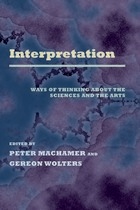 Interpretation: Ways of Thinking about the Sciences and the Arts
Peter Machamer
University of Pittsburgh Press, 2010 The act of interpretation occurs in nearly every area of the arts and sciences. That ubiquity serves as the inspiration for the fourteen essays of this volume, covering many of the domains in which interpretive practices are found. Individual topics include: the general nature of interpretation and its forms; comparing and contrasting interpretation and hermeneutics; culture as interpretation seen through Hegel’s aesthetics; interpreting philosophical texts; methodologies for interpreting human action; interpretation in medical practice focusing on manifestations as indicators of disease; the brain and its interpretative, structured, learning and storage processes; interpreting hybrid wines and cognitive preconceptions of novel objects; and the importance of sensory perception as means of interpreting in the case of dry German Rieslings.
In an interesting turn, Nicholas Rescher writes on the interpretation of philosophical texts. Then Catherine Wilson and Andreas Blank explicate and critique Rescher’s theories through analysis of the mill passage from Leibniz’s Monadology.
 Interpretations of American History
Francis G. Couvares
University of Massachusetts Press, 2025 Without a doubt, the teaching of American history has changed since George Billias and Gerald Grob first issued Interpretations of American History, a comprehensive introduction to the major debates and schools of thought within the field of American history. For this ninth edition, Francis G. Couvares has thoroughly updated the text to include both developments in scholarly debate and changes in the format. He has consolidated two chapters on the revolutionary era into one, and he has also merged formerly separate chapters on profit and commerce in the trading of human beings and the complex and resilient culture that enslaved people sustained. Additionally, he has written a completely new chapter on environmental history and updated the final chapters of the text to include recent scholarship that connects the history of the Civil Rights Movement to the Black Lives Matter Movement; scholarship that discusses intersectionality within feminism, and recent work on political realignment and fragmentation.
In a major revision to the format, Couvares has omitted excerpts of scholarly articles. However, for curious students or research assignments, he includes ample current references. Further, this updated edition anticipates electronic reading of discrete chapters rather than the entire book, and each chapter stands alone well enough to be assigned individually.
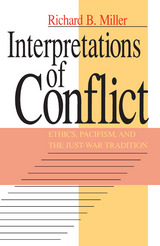 Interpretations of Conflict: Ethics, Pacifism, and the Just-War Tradition
Richard B. Miller
University of Chicago Press, 1991 With today's world torn by violence and conflict, Richard B.
Miller's study of the ethics of war could not be more timely.
Miller brings together the opposed traditions of pacifism and
just-war theory and puts them into a much-needed dialogue
on the ethics of war.
Beginning with the duty of nonviolence as a point of
convergence between the two rival traditions, Miller provides
an opportunity for pacifists and just-war theorists to refine
their views in a dialectical exchange over a set of ethical
and social questions. From the interface of these two long-
standing and seemingly incompatible traditions emerges a
surprisingly fruitful discussion over a common set of values,
problems, and interests: the presumption against harm, the
relation of justice and order, the ethics of civil
disobedience, the problem of self-righteousness in moral
discourse about war, the ethics of nuclear deterrence, and
the need for practical reasoning about the morality of war.
Miller pays critical attention to thinkers such as Augustine
and Thomas Aquinas, as well as to modern thinkers like H.
Richard Niebuhr, Paul Ramsey, Martin Luther King, Jr., James
Douglass, the Berrigans, William O'Brien, Michael Walzer, and
James Childress. He demonstrates how pacifism and just-war
tenets can be joined around both theoretical and practical
issues.
Interpretations of Conflict is a work of massive
scholarship and careful reasoning that should interest
philosophers, theologians, and religious ethicists alike. It
enhances our moral literacy about injury, suffering, and
killing, and offers a compelling dialectical approach to
ethics in a pluralistic society.
Richard B. Miller is assistant professor of religious
studies at Indiana University.
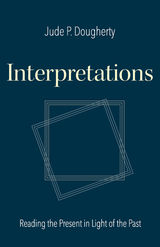 Interpretations: Reading the Present in Light of the Past
Jude P. Dougherty
Catholic University of America Press, 2018 Interpretations is a collection of essays produced by the distinguished philosopher Jude Dougherty over the past decade, written to inform or to provide commentary on contemporary issues. In probing the past to interpret the present they draw upon a perspective that one may call classical, the perspective of Plato, Aristotle, the Stoics, and their followers across the ages, notably Thomas Aquinas, and his modern disciples, such as Etienne Gilson and Jacques Maritain.
The first part of Interpretations is an attempt to understand modernity’s break with the past, the repudiation of Scholasticism and the classical tradition. Dougherty does this by referencing the dominant preoccupations of the Middle Ages, of the Renaissance, of the Reformation, of eighteenth-century British empiricism, and of nineteenth-century German philosophy, drawing upon the readings of Remi Brague, Pierre Manent, and others. What unifies these reflections is the role of religion (both in Christianity and Islam) in society and its impact on the culture, as well as looking at what is called “modernity” where this role becomes reduced or absent.
The second part of the volume examines selected addresses by Pope Emeritus Benedict XVI from a philosophical point of view. Benedict, like others through the course of history, has recognized the role of religion in producing cultural unity. These essays are an appreciation primarily of the subtlety of the former pontiff’s thought.
The third part of Interpretations collects essays and addresses on the practice and nature of philosophy that Dean Dougherty has given throughout his career at The Catholic University of America, and reflects the trajectory of his career and the development of his thought.
 Interpretazioni: Italian Language and Culture through Film
Cristina Pausini and Carmen Merolla
Georgetown University Press, 2019 Interpretazioni is an intermediate- to advanced-level Italian textbook that aims to teach language through film, focusing on Italian movies from 2010 to 2017. Teaching language through cinema is a widespread and proven practice that engages all four main language skills (speaking, listening, reading, writing), and Interpretazioni utilizes the proven format and pedagogy of Pausini and Antonello Borra's previous book, Italian Through Film (Yale UP, 2003), which is regarded highly among teachers. Films featured in Interpretazioni span genres, address a wide range of themes, and are set in various parts of Italy, encouraging students and teachers to more fully engage with the complexity of Italian cinema. As in Italian through Film, the activities based on the films are divided into three main categories (before, during, and after viewing the film) with a natural progression from warm-up questions to closed and controlled exercises to open-ended and creative tasks–both oral and written–including grammar practice, all within the context of each single film. An instructor's manual with answer keys and suggestions on using apps for teaching is available on the www.press.georgetown.edu website.
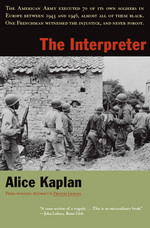 The Interpreter
Alice Kaplan
University of Chicago Press, 2007 No story of World War II is more triumphant than the liberation of France, made famous in countless photos of Parisians waving American flags and kissing GIs as columns of troops paraded down the Champs Élysées. But one of the least-known stories from that era is also one of the ugliest chapters in the history of Jim Crow. In The Interpreter, celebrated author Alice Kaplan recovers this story both as eyewitnesses first saw it, and as it still haunts us today.
The American Army executed 70 of its own soldiers between 1943 and 1946—almost all of them black, in an army that was overwhelmingly white. Through the French interpreter Louis Guilloux’s eyes, Kaplan narrates two different trials: one of a white officer, one of a black soldier, both accused of murder. Both were court-martialed in the same room, yet the outcomes could not have been more different.
Kaplan’s insight into character and setting creates an indelible portrait of war, race relations, and the dangers of capital punishment.
“A nuanced historical account that resonates with today’s controversies over race and capital punishment.” Publishers Weekly
“American racism could become deadly for black soldiers on the front. The Interpreter reminds us of this sad component of a heroic chapter in American military history.” Los Angeles Times
“With elegance and lucidity, Kaplan revisits these two trials and reveals an appallingly separate and unequal wartime U.S. military justice system.” Minneapolis Star Tribune
“Kaplan has produced a compelling look at the racial disparities as they were played out…She explores both cases in considerable and vivid detail.” Sacramento Bee
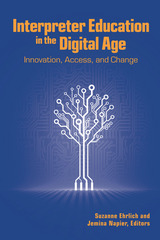 Interpreter Education in the Digital Age: Innovation, Access, and Change
Suzanne Ehrlich
Gallaudet University Press, 2015 This collection brings together innovative research and approaches for blended learning using digital technology in interpreter education for signed and spoken languages. Volume editors Suzanne Ehrlich and Jemina Napier call upon the expertise of 21 experts, including themselves, to report on the current technology used to provide digital enhancements to interpreter education in Australia, New Zealand, Brazil, Belgium, the United Kingdom, and the United States. Divided into three parts, Innovation, Change, and Community Engagement, this study focuses on the technology itself, rather than how technology enhances curriculum, delivery, or resources.
Initiatives described in this collection range from the implementation of on-demand interpreting using iPad technology to create personalized, small-group, multidimensional models suited to digital media for 160 languages; introducing students to interpreting in a 3D world through an IVY virtual environment; applying gaming principles to interpreter education; assessing the amenability of the digital pen in the hybrid mode of interpreting; developing multimedia content for both open access and structured interpreter education environments; to preparing interpreting students for interactions in social media forums, and more. Interpreter Education in the Digital Age provides a context for the application of technologies in interpreter education from an international viewpoint across languages and modalities.
Interpreting 2 Peter through African American Women’s Moral Writings
Shively T. J. Smith
SBL Press, 2023 Shively T. J. Smith reconsiders what is most distinct, troubling, and potentially thrilling about the often overlooked and dismissed book of 2 Peter. Using the rhetorical strategies of nineteenth-century African American women, including Ida B. Wells, Jarena Lee, Anna Julia Cooper, and others, Smith redefines the use of biblical citations, the language of justice and righteousness, and even the matter of pseudonymity in 2 Peter. She approaches 2 Peter as an instance of Christian cultural rhetoric that forges a particular kind of community identity and behavior. This pioneering study considers how 2 Peter cultivates the kind of human relations and attitudes that speak to the values of moral people seeking justice in the past as well as today.
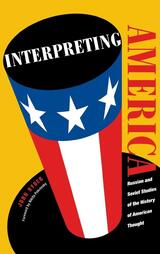 Interpreting America: Russian and Soviet Studies of the History of American Thought
John Ryder
Vanderbilt University Press, 1999 More scholarly works on the history of American philosophy have been completed in Russian than in any other language outside of our own; yet most of that body of work has not been translated or studied comprehensively. Consequently, Soviet-era efforts to understand American thought have remained almost entirely unknown to Western scholars. In his pioneering new book Interpreting America John Ryder makes available for the first time to English-speaking readers Russian views of the full range of American philosophical thought: from seventeenth-century Puritanism through the colonial and revolutionary periods, nineteenth- century idealism, pragmatism, naturalism, and other twentieth-century movements and figures. Using his own accurate translations, he clearly reconstructs a chain of core ideas, emphasizes the most essential concepts of each writer's work, and gives a multidimensional reconstruction of the arguments of each author. By taking mainstream Soviet philosophical commentators like Baskin, Bogomolov, Karimsky, Melvil, Pokrovsky, Sidorov, and Yulina seriously and letting them speak for themselves, Ryder shows not only what Soviet philosophers and scholars thought of American philosophy (and why they were so interested in the first place) but also the nuances of the internal disagreements among Soviet thinkers about what American philosophers were saying. He also reveals a strong continuity between contemporary, post-Soviet Russian philosophy and earlier Soviet work. Perhaps no other book has ever explored in such a systematic manner the ways in which one philosophical system has regarded another. Ryder's revealing study of how others have viewed us helps to clarify the depth, richness, and complexity of our own American philosophical heritage.
 Interpreting and Experiencing Disney: Mediating the Mouse
Edited by Priscilla Hobbs
Intellect Books, 2022 A collection of essays exploring the wide-ranging influence of the Walt Disney Company.
It would be difficult to go through life without ever encountering a Disney product. Since the first Mickey Mouse cartoon premiered in 1928, Disney has played a central role in shaping American popular culture, and it has expanded to the global market. The company positioned itself as a titan of family entertainment, and many of its offerings, from films to consumable products, have become embedded in the minds of children and adults, woven into many of our life experiences. Fans of Disney build connections with their favorite characters and franchises, fueled by Disney’s marketing practices. Others have developed a near-cult-like relationship with the brand, equating its products with religious icons and theme park visits with pilgrimages.
This edited volume looks beyond the movies and merchandise to peer into the very heart of the Disney phenomenon: how the fan response drives the corporation’s massive marketing machine and how the corporate response, in turn, shapes the fan experience.
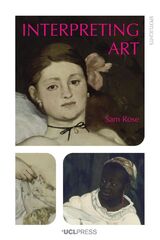 Interpreting Art
Sam Rose
University College London, 2022 Art interpretation in practice, not theory.
How do people make sense of works of art? And how do they write to make others see the same way? There are many guides to looking at art, histories of art history and art criticism, and accounts of various theories and methods, but this book offers something very unlike the normal search for difference and division: it examines the general and largely unspoken norms shared by interpreters of many kinds.
Interpreting Art highlights the norms, premises, and patterns that tend to guide interpretation along the way. Why, for example, is the concept of artistic intention at once so reviled and so hard to let go of? What is involved when an interpretation appeals to an artwork’s reception? How can context be used by some to keep things under control and by others to make the interpretation of art seem limitless? And how is it that artworks only seem to grow in complexity over time?
This volume reveals subtle features of art writing central to the often unnoticed interpretative practices through which we understand works of art. In doing so, the book also sheds light on possible alternatives, pointing to how writers on art might choose to operate differently in the future.
 Interpreting Cézanne
Sidney Geist
Harvard University Press, 1988 In this remarkable book the sculptor and writer Sidney Geist presents a revolutionary interpretation of the art of Cézanne. Geist argues that Cézanne's paintings are fertile with reflections of the artist's private world and passionate concerns. Looking at more than two hundred works, all reproduced in the book, he identifies the symbolism that gives form to a hidden significance in the paintings—concealed allusions to Cézanne himself and to his relations with his wife and mother, his father, his son, and his friend Zola, as well as a circle of colleagues including Pissarro, Frederic Bazille, and Ambroise Vollard. It is a complex pattern of symbols expressed in both secondary visual images and in verbal connections, including rebuses and puns. In reading these paintings for symbolic meaning Geist opens the way to a fuller understanding of Cézanne as well as to new ways of looking at pictures. Interpretation of this kind in its turn explains formal aspects of the paintings with a richness not possible in abstract analysis.
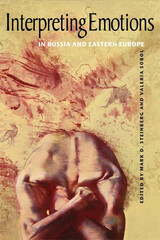 Interpreting Emotions in Russia and Eastern Europe
Mark D. Steinberg and Valeria Sobol
Northern Illinois University Press, 2011
Bringing together important new work by an international and interdisciplinary group of leading scholars, Interpreting Emotions in Russia and Eastern Europe approaches emotions as a phenomenon complexly intertwined with society, culture, politics, and history. The stories in this book involve sensitive aristocrats, committed revolutionaries, aggressive nationalists, political leaders, female victims of sexual violence, perpetrators and victims of Stalinist terror, citizens in the former Yugoslavia in the wake of war, workers in post-socialist Romania, Balkan Romani (“Gypsy”) musicians, and veterans of the Afghan and Chechen wars.
These essays explore emotional perception and expression not only as private, inward feeling but also as a way of interpreting and judging a troubled world, acting in it, and perhaps changing it. Essential reading for those interested in new perspectives on the study of Russia and Eastern Europe, past and present, this volume will appeal to scholars across the social sciences and humanities who are seeking new and deeper approaches to understanding human experience, thought, and feeling.
Interpreting Environments: Tradition, Deconstruction, Hermeneutics
By Robert Mugerauer
University of Texas Press, 1995 In this pioneering book, Robert Mugerauer seeks to make deconstruction and hermeneutics accessible to people in the environmental disciplines, including architecture, planning, urban studies, environmental studies, and cultural geography. Mugerauer demonstrates each methodology through a case study. The first study uses the traditional approach to recover the meaning of Jung's and Wittgenstein's houses by analyzing their historical, intentional contexts. The second case study utilizes deconstruction to explore Egyptian, French neoclassical, and postmodern attempts to use pyramids to constitute a sense of lasting presence. And the third case study employs hermeneutics to reveal how the American understanding of the natural landscape has evolved from religious to secular to ecological since the nineteenth century.
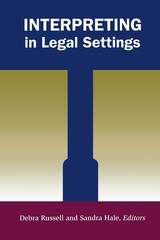 Interpreting in Legal Settings
Debra Russell
Gallaudet University Press, 2009 The Fourth Volume in the Studies in Interpretation Series The work of interpreters in legal settings, whether they are spoken or signed language interpreters, is filled with enormous complexity and challenges. This engrossing volume presents six, data-based studies from both signed and spoken language interpreter researchers on a diverse range of topics, theoretical underpinnings, and research methodologies. In the first chapter, Ruth Morris analyzes the 1987 trial of Ivan (John) Demjanjuk in Jerusalem, and reveals that what might appear to be ethical breaches often were no more than courtroom dynamics, such as noise and overlapping conversation. Waltraud Kolb and Franz Pöchhacker studied 14 asylum appeals in Austria and found that interpreters frequently aligned themselves with the adjudicators. Bente Jacobsen presents a case study of a Danish-English interpreter whose discourse practices expose her attempts to maintain, mitigate, or enhance face among the participants. In the fourth chapter, Jemina Napier and David Spencer investigate the effectiveness of interpreting in an Australian courtroom to determine if deaf citizens should participate as jurors. Debra Russell analyzed the effectiveness of preparing sign language interpreter teams for trials in Canada and found mixed results. The final chapter presents Zubaidah Ibrahim-Bell’s research on the inadequate legal services in Malaysia due to the fact that only seven sign interpreters are available. Taken together, these studies point to a “coming of age” of the field of legal interpreting as a research discipline, making Interpreting in Legal Settings an invaluable, one-of-a-kind acquisition.
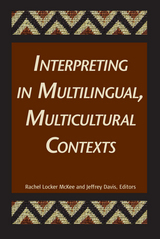 Interpreting in Multilingual, Multicultural Contexts
Rachel Locker McKee
Gallaudet University Press, 2010 The Seventh Volume in the Studies in Interpretation Series Nineteen international authorities contribute their research and findings to Interpreting in Multilingual, Multicultural Contexts, probing the complex nature of interpreted interaction involving Deaf and hearing people of diverse linguistic and cultural backgrounds. They also analyze the contextualized interpreting practices and considerations that transpire from this diversity. In three parts, this trenchant collection shows how Deaf and hearing people use language in fluctuating ways to connect with each other. The chapters in Part 1 — Expanding Frontiers: ASL-English-Spanish Interpreting in the United States — consider sign language interpreting at the border between Baja California and the state; trilingual video relay service (VRS) interpreting; and constructing a valid, reliable trilingual interpreting testing instrument. Part 2 — Mediating Indigenous Voices — explores how to construct roles in a Maori Deaf trilingual context; considerations for interpreting signed languages of American Indian Communities; and interpreting for indigenous Deaf clients in far north Queensland, Australia. In the final section, Part 3 — Globalizing: Interpreting in International Contexts — protocols for interpreting in multilingual international conferences are analyzed. The last chapter describes the arduousness of sign language interpreting in multilingual, international settings. It acts as a fitting conclusion to this examination of the challenges to the sociolinguistic repertoire of interpreters mediating across multiplex combinations of culture and language.
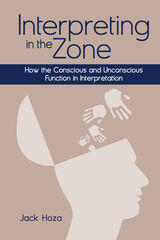 Interpreting in the Zone: How the Conscious and Unconscious Function in Interpretation
Jack Hoza
Gallaudet University Press, 2016 Successful interpretation can feel seamless, an intuitive and efficient translation of meaning from one signed or spoken language to another. Yet the process of interpretation is actually quite complex and relies upon myriad components ranging from preparation to experience to honed judgment. Interpreting in the zone, instinctively and confidently, is an energizing, encompassing experience that results in great satisfaction and top performance—but what does it take to get there?
Jack Hoza’s newest research examines the components that enable interpreters to perform successfully, looking at literature in interpretation, cognitive science, education, psychology, and neuroscience, as well as reviewing the results of two qualitative studies he conducted. He seeks to uncover what it means to interpret in the zone by understanding exactly how the brain works in interpretation scenarios. He explores a range of dichotomies that influence interpretation outcomes, such as:
- Intuition vs. rational thought
- Left brain vs. right brain
- Explicit vs. implicit learning
- Novice vs. master
- Spoken vs. signed languages
- Emotion vs. reasoning
Cognitive processes such as perception, short-term memory, and reflexivity are strong factors in driving successful interpretation and are explored along with habits, behaviors, and learned strategies that can help or hinder interpretation skills. Hoza also considers the importance of professional development and collaboration with other practitioners in order to continually hone expertise.
Interpreting in the Zone shows that cognitive research can help us better understand the intricacies of the interpreting process and has implications for how to approach the interpreting task. This resource will be of value to both the interpreter-in-training as well as the seasoned practitioner.
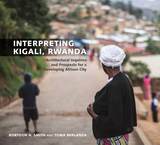 Interpreting Kigali, Rwanda: Architectural Inquiries and Prospects for a Developing African City
Korydon H. Smith
University of Arkansas Press, 2018 Rwanda, less than a generation removed from the 1994 Genocide, is experiencing a period of economic ascent and population growth. Its capital city, Kigali, is expected to triple in size within a generation, and positioned to become a premiere hub of commerce in central and eastern Africa. Amidst this optimism, however, is limited land and material resources. Food security is in tension with environmental concerns, and government aspirations are often in friction with daily, individual struggles for subsistence.
Interpreting Kigali, Rwanda explores the pressing challenges and opportunities to be found in planning, designing, and constructing a healthy, equitable, and sustainable city. Asking “what is an authentic-yet-modern, prosperous-yet-feasible African city, Rwandan city?” Smith, Berlanda, and colleagues conducted research on Rwandan activities of daily living and how these routines are connected to space-making practices and the Kinyarwanda terms that describe them.
Through a culturally informed view of urban and rural lifestyles and spaces, Interpreting Kigali, Rwanda presents principles and proposals for neighborhood development in the challenging context of Kigali’s informal settlements. With one billion people living in informal settlements worldwide, a number expected to double by 2030, the lessons learned in Rwanda provide a complex, fascinating, and urgent study for scholars and practitioners across disciplines and around the world.
Interpreting Late Antiquity: Essays on the Postclassical World
Edited by G. W. Bowersock, Peter Brown, and Oleg Grabar
Harvard University Press, 2001 The era of late antiquity—from the middle of the third century to the end of the eighth—was marked by the rise of two world religions, unprecedented political upheavals that remade the map of the known world, and the creation of art of enduring glory. In these eleven in-depth essays, drawn from the award-winning reference work Late Antiquity: A Guide to the Postclassical World, an international cast of experts provides essential information and fresh perspectives on this period's culture and history.
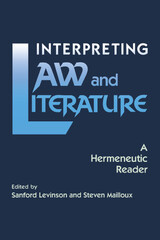 Interpreting Law and Literature: A Hermeneutic Reader
Sanford Levinson and Steven Mailloux
Northwestern University Press, 1988 From the Preface:
"Contemporary theory has usefully analyzed how alternative modes of interpretation produce different meanings, how reading itself is constituted by the variable perspectives of readers, and how these perspectives are in turn defined by prejudices, ideologies, interests, and so forth. Some theorists gave argued persuasively that textual meaning, in literature and in literary interpretation, is structured by repression and forgetting, by what the literary or critical text does not say as much as by what it does. All these claims are directly relevant to legal hermeneutics, and thus it is no surprise that legal theorists have recently been turning to literary theory for potential insight into the interpretation of law. This collection of essays is designed to represent the especially rich interactive that has taken place between legal and literary hermeneutics during the past ten years."
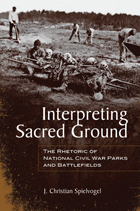 Interpreting Sacred Ground: The Rhetoric of National Civil War Parks and Battlefields
J. Christian Spielvogel
University of Alabama Press, 2013 Interpreting Sacred Ground is a rhetorical analysis of Civil War battlefields and parks, and the ways various commemorative traditions—and their ideologies of race, reconciliation, emancipation, and masculinity—compete for dominance. The National Park Service (NPS) is known for its role in the preservation of public sites deemed to have historic, cultural, and natural significance. In Interpreting Sacred Ground, J. Christian Spielvogel studies the NPS’s secondary role as an interpreter or creator of meaning at such sites, specifically Gettysburg National Military Park, Harpers Ferry National Historical Park, and Cold Harbor Visitor Center. Spielvogel studies in detail the museums, films, publications, tours, signage, and other media at these sites, and he studies and analyzes how they shape the meanings that visitors are invited to construct. Though the NPS began developing interpretive exhibits in the 1990s that highlighted slavery and emancipation as central facets to understanding the war, Spielvogel argues that the NPS in some instances preserves outmoded narratives of white reconciliation and heroic masculinity, obscuring the race-related causes and consequences of the war as well as the war’s savagery. The challenges the NPS faces in addressing these issues are many, from avoiding unbalanced criticism of either the Union or the Confederacy, to foregrounding race and violence as central issues, preserving clear and accurate renderingsof battlefield movements and strategies, and contending with the various public constituencies with their own interpretive stakes in the battle for public memory. Spielvogel concludes by arguing for the National Park Service’s crucial role as a critical voice in shaping twentieth-first-century Civil War public memory and highlights the issues the agency faces as it strives to maintain historical integrity while contending with antiquated renderings of the past.
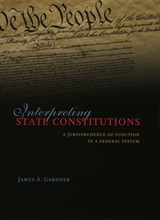 Interpreting State Constitutions: A Jurisprudence of Function in a Federal System
James A. Gardner
University of Chicago Press, 2005 Interpreting State Constitutions examines and proposes a solution to a problem central to contemporary debates over the enforcement of civil liberties: how courts, government officials, and lawyers should go about interpreting the constitutions of the American states.
With the Supreme Court's retreat from the aggressive protection of individual rights, state courts have begun to interpret state constitutions to provide broader protection of liberties. This development has reversed the polarity of constitutional politics, as liberals advocate unimpeded state power while conservatives lobby for state subordination to a constitutional law controlled centrally by the Supreme Court.
James A. Gardner here lays out the first fully developed theory of subnational constitutional interpretation. He argues that states are integral components of a national system of overlapping and mutually checking authority and that the purpose of this system is to protect liberty and defend against federal domination. The resulting account provides valuable prescriptive advice to state courts, showing them how to fulfill their responsibilities to the federal system in a way that strengthens American constitutional discourse.
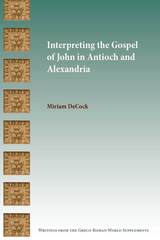 Interpreting the Gospel of John in Antioch and Alexandria
Miriam DeCock
SBL Press, 2020 A nuanced study of early Christian exegesis
Miriam DeCock analyzes four important early Christian treatments of the Gospel of John, including commentaries by Origen and Cyril from the Alexandrian tradition and the homilies of John Chrysostom and the commentary of Theodore of Mopsuestia, which represent Antiochian traditions. DeCock maintains that the traditional distinction between nonliteral and literal interpretations in these two early Christian centers remains helpful despite recent challenges to the paradigm. She argues that a major and abiding distinction between the two schools lies in the manner in which Alexandrian and Antiochian authors apply the gospel text to their respective communities. DeCock demonstrates that the Antiochenes find primarily literal moral examples and doctrinal teachings in John's Gospel, whereas the Alexandrians find both these and nonliteral teachings concerning the immediate situation of the church and of its individual members.
Features
- An examination of each author's interpretations of a selection of texts
- Focused explorations of John 2; 4; and 9-11 in early Christian exegesis
- A study of early literal non-literal interpretations of John's Gospel
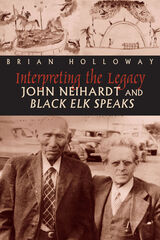 Interpreting the Legacy: John Neihardt and Black Elk Speaks
Brian Holloway
University Press of Colorado, 2020 Ambitious and provocative, Interpreting the Legacy: John Neihardt and Black Elk Speaks is a new study of the classic spiritual text that is sure to spark debate. Neihardt's work has recently been critiqued by scholars who maintain that the author filtered and corrupted Black Elk's teachings through a European spiritual and political lens. In this book, Brian Holloway offers a rather different view, making a convincing case that Neihardt quite consciously attempted to use his literary craftsmanship to provide the reader with direct and immediate access to the teachings of the Oglala elder. Using Neihardt's original handwritten notes and early manuscript drafts, Holloway demonstrates the poet's careful and deliberate re-creation of Black Elk's spiritual world in order to induce a transcendent experience in the reader. Through exhaustive research into Neihardt's biographical materials, published philosophical and metaphysical writings, and volumes of taped lectures, Holloway examines the sources of the book's production as well as the reactions to and the implications of his literary portrayal of the spiritual world of the Oglala. Restoring Neihardt's reputation as a faithful witness to Black Elk's sacred landscape, Interpreting the Legacy: John Neihardt and Black Elk Speaks will be of interest to Neihardt scholars and students of literature, religious studies, and Native American studies.
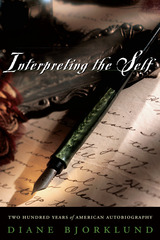 Interpreting the Self: Two Hundred Years of American Autobiography
Diane Bjorklund
University of Chicago Press, 1998 In this ambitious study, Diane Bjorklund explores the historical nature of self-narrative. Examining over 100 American autobiographers published in the last two centuries, she discusses not only well-known autobiographies such as Mark Twain and Andrew Carnegie but also many obscure ones such as a traveling book peddler, a minstrel, a hotel proprietress, an itinerant preacher, a West Point cadet, and a hoopskirt wire manufacturer. Bjorklund draws on the colorful stories of these autobiographers to show how their historical epoch shapes their understandings of self.
"A refreshingly welcome approach to this intriguing topic. . . . [Bjorklund's] extensive and systematic approach to her source material is impressive and enriches our understanding of this essential subject."—Virginia Quarterly Review
"Bjorklund studies both famous and obscure writers, and her clear prose style and copious quotations provide insight into the many aspects of the changing American self." —Library Journal
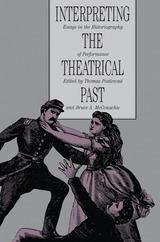 Interpreting The Theatrical Past: Historiography Of Performance
Thomas Postlewait
University of Iowa Press, 1989 The essays in this broadly based work examine the research procedures, practices, problems, and opportunities in the field of theatre history. No single methodology or theory dominates this anthology; instead it offers various approaches to the study of the theatrical past. It is the first of its kind in theatre historiography, useful for research as well as classroom adoption. Though these thirteen essays provide historical information on specific people, events, works, documents, institutions, and social conditions in the theatre, they aim primarily to explore theoretical and methodological issues, to review and analyze current research practices and presuppositions, and to identify and apply new theoretical orientations to theatre studies. Whatever their interpretive viewpoint and rhetorical tone, each of the essays calls for greater awareness of the problems and opportunities that face the discipline. Consequently, this collection will be valuable reading not only for theatre historians but for scholars in literary and popular studies and in all the performing arts.
Interpreting Urban Spaces in Italian Cultures
Andrea Scapolo
Amsterdam University Press, 2023 Made up of both material and symbolic elements, the urban space is always dynamic and transitional; it brings together or separates the past and the present, the public and the private, the center and the periphery. The present volume focuses on the interaction between the social processes and spatial forms that shape the identity of Italian cities. Using both canonical and less well-known texts along with cultural artifacts, the essays in the volume deprovincialize the Italian city, interpreting the material and symbolic practices that have made it into a unique entity whose enduring influence extends far outside Italy.
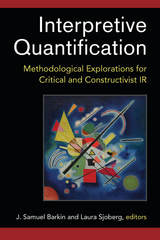 Interpretive Quantification: Methodological Explorations for Critical and Constructivist IR
J. Samuel Barkin and Laura Sjoberg, editors
University of Michigan Press, 2017 Countering the growing divide between positivists who embrace quantitative, numerical approaches and post-positivist scholars who favor qualitative, interpretive approaches, J. Samuel Barkin and Laura Sjoberg argue that both methods are more widely adaptable than is commonly assumed by either camp.
In Interpretive Quantification, ten highly regarded scholars in the field of International Relations apply quantitative methods and formal models to specific constructivist and critical research questions. In this way, each chapter serves not only as evidence that methods can productively be applied across paradigms, but also as a guide as to how this may be done. In sum, the contributors make a compelling case that when researchers cordon off particular methods for merely ideological reasons, they circumscribe their own paradigms and hinder their own research agenda.
 Interracial Housing: A Psychological Evaluation of a Social Experiment
Morton Deutsch and Mary Evans Collins
University of Minnesota Press, 1951 Interracial Housing was first published in 1951. Minnesota Archive Editions uses digital technology to make long-unavailable books once again accessible, and are published unaltered from the original University of Minnesota Press editions. One of the most crucial strains on democracy today is the practice of racial segregation. In the press, in local, state, and federal government agencies, in fact, wherever people thrash out the problems of democratic living, the question is being discussed. This book offers facts which throw new light on an important issue in the overall problem of racial segregation. Here are the results of a study comparing two kinds of public housing—segregated and non-segregated. Two low-rent, public housing projects in which Negroes and whites live as next door neighbors were compared with two similar housing developments in which Negroes and whites are assigned to separate buildings or areas. The study reveals how the people living in these contrasting ways differ in their social relations, community morale, racial attitudes, and other significant social aspects. The research procedures used are explained, and general conclusions about changing prejudices are offered. Social scientists, psychologists, housing officials, and community leaders concerned with the problems not only of housing but of race relations in general will find helpful guidance here. In addition to providing much-needed data on an important social problem, the book offers a valuable demonstration of research techniques in social science.
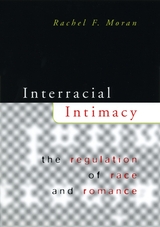 Interracial Intimacy: The Regulation of Race and Romance
Rachel F. Moran
University of Chicago Press, 2003 As late as the 1960s, states could legally punish minorities who either had sex with or married persons outside of their racial groups. In this first comprehensive study of the legal regulation of interracial relationships, Rachel Moran grapples with the consequences of that history, candidly confronting its profound effects on not only conceptions of race and identity, but on ideas about sex, marriage, and family.
"A good introduction to an issue too often overlooked. . . . The writing is clear and accessible, the evidence is evocative, and the ideas are challenging."—Beth Kiyoko Jamieson, Law and Politics Book Review
"U. S. government bodies have tried to regulate interracial intimacy from the day Pocahontas married John Rolfe up through Loving v. Virginia, which found antimiscegentation laws unconstitutional in 1967. . . . The weirder anecdotes from our racial history enliven this study, which is likely to become a classic in its field."—Publishers Weekly
"Moran examines the history of U. S. regulation of cross-racial romance, considering the impact of that regulation on the autonomy of individuals and families as well as on racial identity and equality. . . . She is attuned to the nuances of race in this polyglot nation, and supplies thoughtful analysis of these nuances."—Booklist
 Interregional Competition in Agriculture: With Special Reference to Dairy Farming in the Lake States and New England
Ronald L. Mighell and John D. Black
Harvard University Press Agricultural planning, individual or national, depends on an understanding of competition in farm products between one region of the United States and another. The agriculture of different parts of the United States competes constantly with that of other parts—as, for example, the early competition in cotton between the northern frontier and southern growers, later between the southwest frontier and the Old South, and recently between California and the South. There is equally strong competition between potato-growing regions. It is this inter-regional competition in a country with no trade barriers which two outstanding economists analyze in this book.
They present the results of a concrete study of one outstanding example: competition in dairy production between the Northeastern States and the Lake States of the central Midwest for the New England market for fluid milk and cream. Six selected sample areas were analyzed carefully in each region in 1935–36 and predictions were made about future production and marketing of dairy products in each of these areas. Ten years later these areas were surveyed and the production changes compared with the predictions.
The authors’ conclusions about the conditions under which New England will be able to continue to compete with the lake states for the New England market are significant in themselves. Even more important, however, is the development of a method of analysis which can be widely employed to furnish the information which is needed to guide future developments in the agriculture of the United States or in any other country. This study is therefore an important contribution to the theory of interregional and international trade.
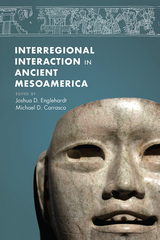 Interregional Interaction in Ancient Mesoamerica
Joshua Englehardt
University Press of Colorado, 2019 Interregional Interaction in Ancient Mesoamerica explores the role of interregional interaction in the dynamic sociocultural processes that shaped the pre-Columbian societies of Mesoamerica. Interdisciplinary contributions from leading scholars investigate linguistic exchange and borrowing, scribal practices, settlement patterns, ceramics, iconography, and trade systems, presenting a variety of case studies drawn from multiple spatial, temporal, and cultural contexts within Mesoamerica.
Archaeologists have long recognized the crucial role of interregional interaction in the development and cultural dynamics of ancient societies, particularly in terms of the evolution of sociocultural complexity and economic systems. Recent research has further expanded the archaeological, art historical, ethnographic, and epigraphic records in Mesoamerica, permitting a critical reassessment of the complex relationship between interaction and cultural dynamics. This volume builds on and amplifies earlier research to examine sociocultural phenomena—including movement, migration, symbolic exchange, and material interaction—in their role as catalysts for variability in cultural systems.
Interregional cultural exchange in pre-Columbian Mesoamerica played a key role in the creation of systems of shared ideologies, the production of regional or “international” artistic and architectural styles, shifting sociopolitical patterns, and changes in cultural practices and meanings. Interregional Interaction in Ancient Mesoamerica highlights, engages with, and provokes questions pertinent to understanding the complex relationship between interaction, sociocultural processes, and cultural innovation and change in the ancient societies and cultural histories of Mesoamerica and will be of interest to archaeologists, linguists, and art historians.
Contributors: Philip J. Arnold III, Lourdes Budar, José Luis Punzo Diaz, Gary Feinman, David Freidel, Elizabeth Jiménez Garcia, Guy David Hepp, Kerry M. Hull, Timothy J. Knab, Charles L. F. Knight, Blanca E. Maldonado, Joyce Marcus, Jesper Nielsen, John M. D. Pohl, Iván Rivera, D. Bryan Schaeffer, Niklas Schulze
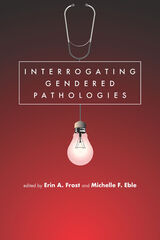 Interrogating Gendered Pathologies
Erin Clark
Utah State University Press, 2020 Interrogating Gendered Pathologies points out and critiques unjust patterns of pathology. Erin A. Frost and Michelle F. Eble assemble a transdisciplinary approach from/to technologies, rhetorics, philosophies, epistemologies, and biomedical data to consider the effects of biomedicine’s gendered norms on people’s lives. Using a range of complementary and intersectional theoretical approaches, contributors ask questions about rhetoric’s role in healthcare and how it differs depending on patient embodiment and the ways nonnormative bodies are pathologized.
These chapters engage common narratives about the ways in which gender in healthcare is secondary and highlights the stories of people who have battled to prioritize their own bodies through extraordinary difficulties. Employing a multiplicity of voices, the book represents a number of different perspectives on what it might look like to return health and medical data to embodied experience, to consider the effects of gendered and intersectional biomedical norms on lived realities, and to subvert the power of institutions in ways that move us toward biomedical justice.
This collection contributes to the burgeoning field of health and medical rhetorics by rhetorically and theoretically intervening in what are often seen as objective and neutral decisions related to the body and to scientific and medical data about bodies. Interrogating Gendered Pathologies will be of interest to feminist scholars in the field of rhetoric and writing studies, specifically those in the rhetorics of health and medicine, as well as scholars of technical communication, feminist studies, gender studies, technoscience studies, and bioethics.
Contributors: Leslie Anglesey, Mary Assad, Beth Boser, Lillian Campbell, Marleah Dean, Lori Beth De Hertogh, Leandra Hernandez, Elizabeth Horn-Walker, Caitlin Leach, Jordan Liz, Miriam Mara, Cathryn Molloy, Kerri Morris, Maria Novotny, Sage Perdue, Colleen Reilly
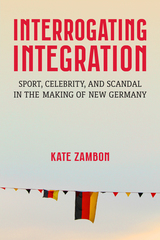 Interrogating Integration: Sport, Celebrity, and Scandal in the Making of New Germany
Kate Zambon
University of Michigan Press, 2025 Interrogating Integration explores how international sporting spectacles, media campaigns, and public debates construct racialized national identity in an era of rising right-wing nationalism. Across Europe, “integration” has emerged as a guiding concept to regulate cultural differences, particularly in Germany, where integration became a watchword after the introduction of birthright citizenship in 2000. The legal expansion of German citizenship threatened the homogeneous definition of the nation and spurred increased scrutiny of immigrants and Germans of color, primarily Muslim and Black Germans. This opened a new chapter in the long struggle over German identity. The celebrations, scandals, and debates analyzed here reveal how the admission of new citizens inspired an optimistic cosmopolitanism that claimed to differentiate the new Germany from its fascist past while simultaneously reinscribing racialized hierarchies and providing fuel for rising far-right politics.
Using touchstones of public memory, including events surrounding men’s World Cup soccer and the record-breaking success of a book blaming Muslims for Germany’s decline, Zambon examines persistent problems in European conceptions of race, where racializing projects take place under an “ideology of racelessness” and the atrocities of historical and transnational racisms are used to deny current local forms of racism.
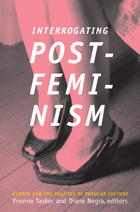 Interrogating Postfeminism: Gender and the Politics of Popular Culture
Yvonne Tasker and Diane Negra, eds.
Duke University Press, 2007 This timely collection brings feminist critique to bear on contemporary postfeminist mass media culture, analyzing phenomena ranging from action films featuring violent heroines to the “girling” of aging women in productions such as the movie Something’s Gotta Give and the British television series 10 Years Younger. Broadly defined, “postfeminism” encompasses a set of assumptions that feminism has accomplished its goals and is now a thing of the past. It presumes that women are unsatisfied with their (taken for granted) legal and social equality and can find fulfillment only through practices of transformation and empowerment. Postfeminism is defined by class, age, and racial exclusions; it is youth-obsessed and white and middle-class by default. Anchored in consumption as a strategy and leisure as a site for the production of the self, postfeminist mass media assumes that the pleasures and lifestyles with which it is associated are somehow universally shared and, perhaps more significantly, universally accessible. Essays by feminist film, media, and literature scholars based in the United States and United Kingdom provide an array of perspectives on the social and political implications of postfeminism. Examining magazines, mainstream and independent cinema, popular music, and broadcast genres from primetime drama to reality television, contributors consider how postfeminism informs self-fashioning through makeovers and cosmetic surgery, the “metrosexual” male, the “black chick flick,” and more. Interrogating Postfeminism demonstrates not only the viability of, but also the necessity for, a powerful feminist critique of contemporary popular culture. Contributors. Sarah Banet-Weiser, Steven Cohan, Lisa Coulthard, Anna Feigenbaum, Suzanne Leonard, Angela McRobbie, Diane Negra, Sarah Projansky, Martin Roberts, Hannah E. Sanders, Kimberly Springer, Yvonne Tasker, Sadie Wearing
Interrogating Privilege: Reflections of a Second Language Educator
Stephanie Vandrick
University of Michigan Press, 2013 Interrogating Privilege is a welcome combination of personal essays and academic research, blending theory, analysis, and narrative to explore the function and consequences of privilege in second language education. While teachers’ focus on the learning process and class goals are quite important, there is not enough attention paid to the types of privilege—or lack thereof—that individuals bring to the classroom. Through chapters that can either stand alone or be read together, with topics such as gender, age, and colonialism (the author is the daughter of missionary parents) in second language teaching, this book seeks to address the experiences of teachers, scholars, and students as “whole persons” and to observe the workings of identity and privilege in the educational setting.
 Interrogating the Future of Puerto Rican Studies
Aurora Santiago Ortiz and Jorell A. Meléndez-Badillo, editors
Duke University Press, 2026 Interrogating The Future of Puerto Rican Studies brings together emerging and established scholars from a wide range of disciplines to examine the disciplinary and epistemic transformations that have given way to new understandings of the field of Puerto Rican studies. Documenting the intellectual contours that have shaped the field of Puerto Rican Studies in the last decade, a diverse range of contributors survey the field with new lenses that are attentive to gender, queerness, disability, and Blackness among other things. A foreword by Yarimar Bonilla situates the volume in the context of the field’s shift, specifically in the aftermath of Hurricane Maria, while other sections, including “Queering Puerto Rican Studies,” “Centering Blackness,” and “Disaster Studies and Environmental Studies,” as well as “Puerto Rican Studies in Broader Fields of Knowledges,” “Prefigurative Politics and Social Movements,” and “Legal and Political Disruptions,” create a vibrant archive of conversations taking place within the field of Puerto Rican studies with the aim of interrogating its future.
Contributors. José Atiles, Bárbara Abadía Rexach, Yarimar Bonilla, daniela crespo-miró, Marie Cruz Soto, Yomaira Figueroa-Vásquez, Marcela Guerrero, Gustavo García López, Mónica Jiménez, Lawrence LaFountain Stokes, Marisol LeBrón, Pedro Lebrón Ortiz, Beatriz Llenín Figueroa, Jorell Meléndez-Badillo, Sarah Molinari, Marisel Moreno, Daniel Nevárez Araújo, Aurora Santiago Ortiz, Karrieann Soto Vega, Daniel Vázquez Sanabria, Roberto Vélez-Vélez, Joaquín Villanueva, Jacqueline Villarrubia-Mendoza
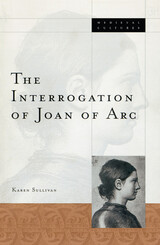 Interrogation Of Joan Of Arc
Karen Sullivan
University of Minnesota Press, 1999 A radical reassessment of the trial of Joan of Arc that gives a new sense of Joan in her time. The transcripts of Joan of Arc’s trial for heresy at Rouen in 1431 and the minutes of her interrogation have long been recognized as our best source of information about the Maid of Orleans. Historians generally view these legal texts as a precise account of Joan’s words and, by extension, her beliefs. Focusing on the minutes recorded by clerics, however, Karen Sullivan challenges the accuracy of the transcript. In The Interrogation of Joan of Arc, she re-reads the record not as a perfect reflection of a historical personality’s words, but as a literary text resulting from the collaboration between Joan and her interrogators. Sullivan provides an illuminating and innovative account of Joan’s trial and interrogation, placing them in historical, social, and religious context. In the fifteenth century, interrogation was a method of truth-gathering identified not with people like Joan, who was uneducated, but with clerics, like those who tried her. When these clerics questioned Joan, they did so as scholastics educated at the University of Paris, as judges and assistants to judges, and as pastors trained in hearing confessions. The Interrogation of Joan of Arc traces Joan’s conflicts with her interrogators not to differing political allegiances, but to fundamental differences between clerical and lay cultures. Sullivan demonstrates that the figure depicted in the transcripts as Joan of Arc is a complex, multifaceted persona that results largely from these cultural differences. Discerning and innovative, this study suggests a powerful new interpretive model and redefines our sense of Joan and her time.
Interrogation Palace: New and Selected Poems 1982-2004
David Wojahn
University of Pittsburgh Press, 2006 Interrogation Palace is a career-spanning selection of work from an important American poet, drawing upon each of David Wojahn’s six previous collections and a substantial gathering of new work. Moving fluently from personal history to public history, and from high culture to popular culture, Wojahn’s searching and restless poetry has been considerably acclaimed, both for the candor of its testimony and the authority of its formal invention. He is above all an elegiac poet, tender and ferocious by turns, whether mourning the loss of family and loved ones or the hopes and aspirations of the baby-boomer era. <I>Interrogation Palace</I> confirms David Wojahn’s status as one of the most inventive, passionate, and ambitious figures of his generation.
 Interrogations, Forced Feedings, and the Role of Health Professionals: New Perspectives on International Human Rights, Humanitarian Law, and Ethics
Ryan Goodman and Mindy Jane Roseman
Harvard University Press The involvement of health professionals in human rights and humanitarian law violations has again become a live issue as a consequence of the U.S. prosecution of conflicts with al Qaeda, the Taliban, and Iraq. Health professionals—including M.D.s trained in psychiatry and Ph.D.s trained in behavioral psychology—have reportedly advised and assisted in coercive interrogation. Health professionals have also been involved in forced feedings. Such practices would not be unique to the United States nor the most extreme forms of abuse in the world. The direct involvement of medical professionals in torture, covering up extrajudicial killings, and other extreme conduct is a phenomenon common to many societies and periods of national crisis. Indeed, the widespread and repeated nature of this problem has led to the development of important legal and ethical codes on the subject. Those codes, however, are notoriously insufficient in many cases. A reexamination of the international norms, as developed in human rights law, humanitarian law, and professional ethics can shed light on these issues. However, in addition to those instruments, the struggle to end such violations requires understanding human behavior and the role of formal and informal institutional pressures.
In this volume, a wide range of prominent practitioners and scholars explore these issues. Their insights provide significant potential for reforming institutions to assist health professionals maintain their legal and ethical obligations in times of national crisis.
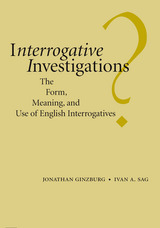 Interrogative Investigations: The Form, Meaning, and Use of English Interrogatives
Jonathan Ginzburg and Ivan A. Sag
CSLI, 2001 Interrogative constructions are the linguistic forms by which questions are expressed. Their analysis is of great interest to linguists, as well as to computer scientists, human-computer interface designers, and philosophers. Interrogative constructions have played a central role in the development of modern syntactic theory. Nonetheless, to date most syntactic work has taken place quite separately from formal semantic and pragmatic work on interrogatives. Although there has by now been a significant amount of work on interrogatives across a variety of languages, there exist few syntactic and semantic treatments that provide a comprehensive account of a wide range of interrogative constructions and uses in a single language.
This book closes the gap in research on this subject. By developing the frameworks of Head Driven Phrase Structure Grammar and Situation Semantics, the authors provide an account that rigorously integrates syntactic, semantic, and contextual dimensions of interrogatives. The challenge of providing exhaustive coverage of the interrogative constructions of English, including various constructions that occur solely in dialogue interaction, leads to new insights about a variety of contentious theoretical issues. These include matters of semantic ontology, the quantificational status of wh-phrases, the semantic effect of wh-fronting, the status of constructions in grammatical theory, the integration of illocutionary information in the grammar, and the nature of ellipsis resolution in dialogue. The account is stated with sufficient rigor to enable fairly direct computational implementation.
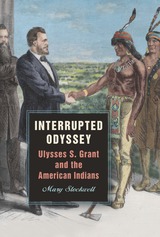 Interrupted Odyssey: Ulysses S. Grant and the American Indians
Mary Stockwell
Southern Illinois University Press, 2018 In this first book devoted to the genesis, failure, and lasting legacy of Ulysses S. Grant’s comprehensive American Indian policy, Mary Stockwell shows Grant as an essential bridge between Andrew Jackson’s pushing Indians out of the American experience and Franklin D. Roosevelt’s welcoming them back in. Situating Grant at the center of Indian policy development after the Civil War, Interrupted Odyssey: Ulysses S. Grant and the American Indians reveals the bravery and foresight of the eighteenth president in saying that Indians must be saved and woven into the fabric of American life.
In the late 1860s, before becoming president, Grant collaborated with Ely Parker, a Seneca Indian who became his first commissioner of Indian affairs, on a plan to rescue the tribes from certain destruction. Grant hoped to save the Indians from extermination by moving them to reservations, where they would be guarded by the U.S. Army, and welcoming them into the nation as American citizens. By so doing, he would restore the executive branch’s traditional authority over Indian policy that had been upended by Jackson.
In Interrupted Odyssey, Stockwell rejects the common claim in previous Grant scholarship that he handed the reservations over to Christian missionaries as part of his original policy. In part because Grant’s plan ended political patronage, Congress overturned his policy by disallowing Army officers from serving in civil posts, abandoning the treaty system, and making the new Board of Indian Commissioners the supervisors of the Indian service. Only after Congress banned Army officers from the Indian service did Grant place missionaries in charge of the reservations, and only after the board falsely accused Parker of fraud before Congress did Grant lose faith in his original policy.
Stockwell explores in depth the ousting of Parker, revealing the deep-seated prejudices that fueled opposition to him, and details Grant’s stunned disappointment when the Modoc murdered his peace commissioners and several tribes—the Comanche, Kiowa, Cheyenne, and Sioux—rose up against his plans for them.
Though his dreams were interrupted through the opposition of Congress, reformers, and the tribes themselves, Grant set his country firmly toward making Indians full participants in the national experience. In setting Grant’s contributions against the wider story of the American Indians, Stockwell’s bold, thoughtful reappraisal reverses the general dismissal of Grant’s approach to the Indians as a complete failure and highlights the courage of his policies during a time of great prejudice.
 Interruptions: Mysticism, Politics, and Theology in the Work of Johann Baptist Metz
J. Matthew Ashley
University of Notre Dame Press, 1998 “This text . . . presents a comprehensive look at the theological development of Metz, and in particular examines closely Metz’s shift from Rahnerian transcendental thought to the political theology that has marked his major contributions, while arguing that Metz has stayed in essential continuity with Rahner. At a second and more important level, the work takes us into a discussion of the relationships between spirituality and theology. This time, Metz is viewed as a man who has struggled throughout his life to find a way to blend prayer and theology and has discovered it finally in his sustained attention to suffering. In his concluding chapter Ashley locates the differences between Rahner and Metz in the distinct spiritualities that influence each. From Metz’s perspective, Rahner’s mysticism is too individualistic. The political or prophetic dimension is lacking. This extremely well-written work is commended to all with an interest in Rahner, Metz, or the interrelations of spirituality and theology.” —Religious Studies Review
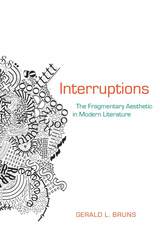 Interruptions: The Fragmentary Aesthetic in Modern Literature
Gerald L. Bruns
University of Alabama Press, 2018 A history of fragmentary—or interrupted—writing in avant-garde poetry and prose by a renowned literary critic. In Interruptions: The Fragmentary Aesthetic in Modern Literature, Gerald L. Bruns explores the effects of parataxis, or fragmentary writing as a device in modern literature. Bruns focuses on texts that refuse to follow the traditional logic of sequential narrative. He explores numerous examples of self-interrupting composition, starting with Friedrich Schlegel's inaugural theory and practice of the fragment as an assertion of the autonomy of words, and their freedom from rule-governed hierarchies. Bruns opens the book with a short history of the fragment as a distinctive feature of literary modernism in works from Gertrude Stein to Paul Celan to present-day authors. The study progresses to the later work of Maurice Blanchot and Samuel Beckett, and argues, controversially, that Blanchot's writings on the fragment during the 1950s and early 1960s helped to inspire Beckett’s turn toward paratactic prose. The study also extends to works of poetry, examining the radically paratactic arrangements of two contemporary British poets, J. H. Prynne and John Wilkinson, focusing chiefly on their most recent, and arguably most abstruse, works. Bruns also offers a close study of the poetry and poetics of Charles Bernstein. Interruptions concludes with two chapters about James Joyce. First, Bruns tackles the language of Finnegans Wake, namely the break-up of words themselves, its reassembly into puns, neologisms, nonsense, and even random strings of letters. Second, Bruns highlights the experience of mirrors in Joyce’s fiction, particularly in Dubliners, Portrait of the Artist as a Young Man, and Ulysses, where mirrored reflections invariably serve as interruptions, discontinuities, or metaphorical displacements and proliferations of self-identity.
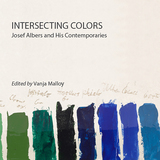 Intersecting Colors: Josef Albers and His Contemporaries
Vanja Malloy, editor
Amherst College Press, 2015 Josef Albers (1888–1976) was an artist, teacher, and seminal thinker on the perception of color. A member of the Bauhaus who fled to the U.S. in 1933, his ideas about how the mind understands color influenced generations of students, inspired countless artists, and anticipated the findings of neuroscience in the latter half of the twentieth century. With contributions from the disciplines of art history, the intellectual and cultural significance of Gestalt psychology, and neuroscience, Intersecting Colors offers a timely reappraisal of the immense impact of Albers’s thinking, writing, teaching, and art on generations of students. It shows the formative influence on his work of non-scientific approaches to color (notably the work of Johann Wolfgang von Goethe) and the emergence of Gestalt psychology in the first decades of the twentieth century. The work also shows how much of Albers’s approach to color—dismissed in its day by a scientific approach to the study and taxonomy of color driven chiefly by industrial and commercial interests—ultimately anticipated what neuroscience now reveals about how we perceive this most fundamental element of our visual experience. Edited by Vanja Malloy, with contributions from Brenda Danilowitz, Sarah Lowengard, Karen Koehler, Jeffrey Saletnik, and Susan R. Barry.
Intersecting Journeys: The Anthropology of Pilgrimage and Tourism
Edited by Ellen Badone and Sharon R. Roseman
University of Illinois Press, 2004 The appeal of sacred sites remains undiminished at the start of the twenty-first century, as unprecedented numbers of visitors travel to Lourdes, Rome, Jerusalem, Santiago de Compostela, and even Star Trek conventions. Ethnographic analysis of the conflicts over resources and meanings associated with such sites, as well as the sense of community they inspire, provides compelling evidence re-emphasizing the links between pilgrimage and tourism. As the papers in this collection demonstrate, studies of these forms of journeying are at the forefront of postmodern debates about movement and centers, global flows, social identities, and the negotiation of meanings.
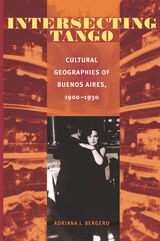 Intersecting Tango: Cultural Geographies of Buenos Aires, 1900-1930
Adriana J. Bergero
University of Pittsburgh Press, 2008 In the early part of the twentieth century, Buenos Aires erupted from its colonial past as a city in its own right, expressing a unique and vibrant cultural identity.
Intersecting Tango engages the city at this key moment, exploring the sweeping changes of 1900-1930 to capture this culture in motion through which Buenos Aires transformed itself into a modern, cosmopolitan city.
Taking the reader through a dazzling array of sites, sources, and events, Bergero conveys the city in all its complexity. Drawing on architecture and gendered spaces, photography, newspaper columns, schoolbooks, “high” and “low” literature, private letters, advertising, fashion, and popular music, she illuminates a range of urban social geographies inhabited by the city's defining classes and groups. In mining this vast material, Bergero traces the profound change in social fabric by which these diverse identities evolved, through the processes of modernization and its many dislocations, into a new national identity capable of embodying modernity.
In her interdisciplinary study of urban development and cultural encounters with modernity, Bergero leads the reader through the city's emergence, collecting her investigations around the many economic, social, and gender issues remarkably conveyed by the tango, the defining icon of Buenos Aires. Multifaceted and original, Intersecting Tango is as rich and captivating as the dance itself.
 Intersectional Activism in Environmental Communication: Changemakers Respond to Ecological Crises
Emma Frances Bloomfield
Michigan State University Press, 2025 Intersectional Activism in Environmental Communication explores the representation of environmental activism around the world. Exploring issues from Indigenous women’s activism in Brazil and India to energy protests in South Korea, to the Dakota Access pipeline construction on Standing Rock Sioux territory, to the contours of the internet, this collection offers critical reflection points for the representation of environmental activism and theorizes the various channels and audiences for embodied and mediated environmental communication. The intersectional approach reflected in this work explores circumstances where powerful interests distract, dissuade, and undermine emergent voices and the ecological values they articulate. This volume addresses how intersectional environmental activism can effectively challenge systems and practices that perpetuate ecological degradation and environmental injustices.
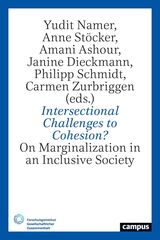 Intersectional Challenges to Cohesion?: On Marginalization in an Inclusive Society
Edited by Yudith Namer, et al.
Campus Verlag, 2024 Interrogates the forces that determine who truly “belongs” in an inclusive society, and who remains on its margins.
How can a society call itself inclusive while systematically excluding those who do not fit the norm? Intersectional Challenges to Cohesion? critically examines how people are marked as “not belonging” based on multiple, intersecting dimensions of identity: race, gender, disability, migration status, and more.
By bringing together diverse academic perspectives, this volume brings to light the lived realities of marginalized individuals at personal and social levels, depicting how systemic exclusion persists despite democratic ideals. Through interdisciplinary research and case studies, the contributors analyze the structures that enforce non-normativity and limit participation and ultimately question the very fabric of social cohesion. Through mapping these intersectional challenges, this book provides crucial insights for scholars and policymakers striving for genuine inclusion.
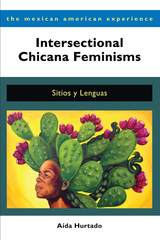 Intersectional Chicana Feminisms: Sitios y Lenguas
Aída Hurtado
University of Arizona Press, 2020 Chicana feminisms are living theory deriving value and purpose by affecting social change. Advocating for and demonstrating the importance of an intersectional, multidisciplinary, activist understanding of Chicanas, Intersectional Chicana Feminisms provides a much-needed overview of the key theories, thinkers, and activists that have contributed to Chicana feminist thought.
Aída Hurtado, a leading Chicana feminist and scholar, traces the origins of Chicanas’ efforts to bring attention to the effects of gender in Chicana and Chicano studies. Highlighting the innovative and pathbreaking methodologies developed within the field of Chicana feminisms—such as testimonio, conocimiento, and autohistoria—this book offers an accessible introduction to Chicana theory, methodology, art, and activism. Hurtado also looks at the newest developments in the field and the future of Chicana feminisms.
The book includes short biographies of key Chicana feminists, additional suggested readings, and exercises with each chapter to extend opportunities for engagement in classroom and workshop settings.
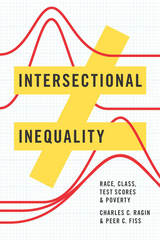 Intersectional Inequality: Race, Class, Test Scores, and Poverty
Charles C. Ragin and Peer C. Fiss
University of Chicago Press, 2016 For over twenty-five years, Charles C. Ragin has developed Qualitative Comparative Analysis and related set-analytic techniques as a means of bridging qualitative and quantitative methods of research. Now, with Peer C. Fiss, Ragin uses these impressive new tools to unravel the varied conditions affecting life chances.
Ragin and Fiss begin by taking up the controversy regarding the relative importance of test scores versus socioeconomic background on life chances, a debate that has raged since the 1994 publication of Richard Herrnstein and Charles Murray’s TheBell Curve. In contrast to prior work, Ragin and Fiss bring an intersectional approach to the evidence, analyzing the different ways that advantages and disadvantages combine in their impact on life chances. Moving beyond controversy and fixed policy positions, the authors propose sophisticated new methods of analysis to underscore the importance of attending to configurations of race, gender, family background, educational achievement, and related conditions when addressing social inequality in America today.
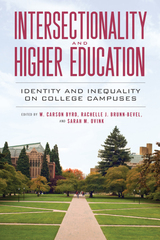 Intersectionality and Higher Education: Identity and Inequality on College Campuses
W. Carson Byrd
Rutgers University Press, 2019 Though colleges and universities are arguably paying more attention to diversity and inclusion than ever before, to what extent do their efforts result in more socially just campuses? Intersectionality and Higher Education examines how race, ethnicity, class, gender, sexuality, sexual orientation, age, disability, nationality, and other identities connect to produce intersected campus experiences. Contributors look at both the individual and institutional perspectives on issues like campus climate, race, class, and gender disparities, LGBTQ student experiences, undergraduate versus graduate students, faculty and staff from varying socioeconomic backgrounds, students with disabilities, undocumented students, and the intersections of two or more of these topics. Taken together, this volume presents an evidence-backed vision of how the twenty-first century higher education landscape should evolve in order to meaningfully support all participants, reduce marginalization, and reach for equity and equality.
Intersectionality as Critical Social Theory
Patricia Hill Collins
Duke University Press, 2019 In Intersectionality as Critical Social Theory Patricia Hill Collins offers a set of analytical tools for those wishing to develop intersectionality's capability to theorize social inequality in ways that would facilitate social change. While intersectionality helps shed light on contemporary social issues, Collins notes that it has yet to reach its full potential as a critical social theory. She contends that for intersectionality to fully realize its power, its practitioners must critically reflect on its assumptions, epistemologies, and methods. She places intersectionality in dialog with several theoretical traditions—from the Frankfurt school to black feminist thought—to sharpen its definition and foreground its singular critical purchase, thereby providing a capacious interrogation into intersectionality's potential to reshape the world.
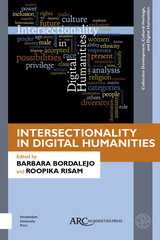 Intersectionality in Digital Humanities
Barbara Bordalejo
Arc Humanities Press, 2019 CURRENTLY UNAVAILABLE
Coined by Kimberlé Crenshaw in the late 1980s, intersectionality makes the case that dimensions of identity, such as gender and race, cannot be understood in isolation from each other because they work together to shape lived experience. As digital humanities has expanded in scope and content, questions of how to negotiate the overlapping influences of race, class, gender, sexuality, nation, and other dimensions that shape data, archives, and methodologies have come to the fore. Taking up these concerns, the authors in this volume explore their effects on the methodological, political, and ethical practices of digital humanities. Essays examine intersectionality from a range of positions: the influence of overlapping identities on scholars within the digital humanities community; how the fields in which they work are subject to competing tensions created by intersecting power structures within digital humanities and academia; and the methodological possibilities and scholarly potential for intersectionality as a framing theory in digital humanities scholarship.
 Intersections: Fantasy and Science Fiction
Edited by George E. Slusser and Eric S. Rabkin
Southern Illinois University Press, 1987
These 17 essays from the seventh annual J. Lloyd Eaton Conference examine the relationship between fantasy and science fiction.
They propose that fantasy and science fiction are not isolated commercial literary forms, but instead are literary forms worthy of the recognition reserved for traditional literature. Discussion of genre identification ranges from the standard forms of literary criticism embodied in Aristotle’s mimesis and poesis to innovative and possibly controversial points of view such as a theory of humor, a philosophy of time, and a detailed analysis of Dr. Seuss’s Cat in the Hat.
The essays provide not only a detailed study of literary elements but also the historical treatment of the material, its commercial use, and its relationship to similar literary forms such as the gothic tale and horror fiction. While few of the essayists agree with one another, they all contribute creative insights to the debate.
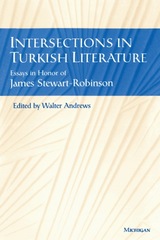 Intersections in Turkish Literature: Essays in Honor of James Stewart-Robinson
Walter G. Andrews, Editor
University of Michigan Press, 2001 The rich but often neglected field of Turkish and Ottoman literature has long suffered from the fact that a number of traditional research boundaries have separated the studies of folk and elite literature, of Ottoman and modern literature, of the village and the city, the religious and the secular.
Intersections in Turkish Literature is a collection of essays on Turkish literature by former students of James Stewart-Robinson. The topics and methods cover a broad range--from a careful thematic analysis of a traditional Turkish folktale, which reveals its resemblance to well-known Western tales; to an analysis of the "saint tales" recounted by present-day Albanian Bektasi adepts; to a study of narrative rhythm in Nazim Hikhmet's rendition of an account of a fifteenth-century popular uprising.
Walter G. Andrews has assembled the writings of a number of scholars who bridge traditional chasms, inviting us to rethink our approaches to the study of Turkish and Ottoman literature. This collection forms a nucleus that clearly demonstrates the great potential now existing for study in this area, the essays displaying a variety of unusual approaches that bring together seemingly disparate materials: the Turkish story "The Pomegranate Seed" and Disney's "Snow White"; a fifteenth-century chronicle and the poetry of a modern socialist poet; Albanian dervishes in Detroit; a modern Turkish novel; Virginia Woolf; a Yale critic; traditional Japanese poetry; and Ottoman lyrics.
Intersections in Turkish Literature will provide an important stimulus to work that reaches beyond the limits of area studies, intersecting with the interests of scholars and students of literary theory, folklore studies, anthropology, French, Japanese, and Persian.
Walter G. Andrews is Affiliate Professor of Near Eastern Languages and Civilization, University of Washington.
Intersections: Issues in Contemporary Art, Volume 12
Joan Kee , ed.
Duke University Press This special issue of positions adds to the increasingly substantial set of discussions on contemporary visual art in Asia. Approaching the topic from an interrogative perspective-one that explores deceptively simple definitions of terms such as "contemporary" and "Asia"-these essays examine specific works from Hong Kong, Japan, Singapore, China and the Philippines and consider the particular context in which they were created. The result is an issue that encourages larger discussions of reflexivity, historicity, and politicization as it relates to artistic expression in Asian contexts. Contributors. Thomas J. Berghuis, Lee Weng Choy, Patrick Flores, Joan Kee, Alice Ming Wai Jim, Sheldon Lu, Gao Minglu, Reiko Tomii
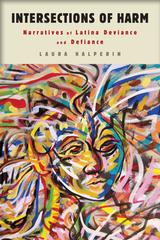 Intersections of Harm: Narratives of Latina Deviance and Defiance
Halperin, Laura
Rutgers University Press In this innovative new study, Laura Halperin examines literary representations of harm inflicted on Latinas’ minds and bodies, and on the places Latinas inhabit, but she also explores how hope can be found amid so much harm. Analyzing contemporary memoirs and novels by Irene Vilar, Loida Maritza Pérez, Ana Castillo, Cristina García, and Julia Alvarez, she argues that the individual harm experienced by Latinas needs to be understood in relation to the collective histories of aggression against their communities. Intersections of Harm is more than just a nuanced examination of the intersections among race, ethnicity, class, gender, and sexuality. It also explores the intersections of deviance and defiance, individual and collective, and mind, body, and place. Halperin proposes that, ironically, the harmful ascriptions of Latina deviance are tied to the hopeful expressions of Latina defiance. While the Latina protagonists’ defiance feeds into the labels of deviance imposed on them, it also fuels the protagonists’ ability to resist such harmful treatment. In this analysis, Halperin broadens the parameters of literary studies of female madness, as she compels us to shift our understanding of where madness lies. She insists that the madness readily attributed to individual Latinas is entwined with the madness of institutional structures of oppression, and she maintains that psychological harm is bound together with physical and geopolitical harm. In her pan-Latina study, Halperin shows how each writer’s work emerges from a unique set of locales and histories, but she also traces a network of connections among them. Bringing together concepts from feminism, postcolonialism, illness studies, and ecocriticism, Intersections of Harm opens up exciting new avenues for Latina/o studies.
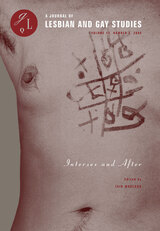 Intersex and After, Volume 15
Iain Morland
Duke University Press In this special issue of GLQ, experts from a variety of disciplines discuss the future of treatment for people with intersex conditions—those born with ambiguous genitalia—and consider what intersexuality means for theories of gender. By examining the ethics of medical treatment and the repercussions of intersex surgery, “Intersex and After” demonstrates how biology, activism, law, morality, and ethics have a shared interest in the relationship between intersexuality and the meaning of sex, gender, and sexuality. In one essay, two prominent intersex activists reflect on their often controversial work on behalf of the Intersex Society of North America to achieve change in medical policy over the last ten years. Other essays explore the impact of the categorization of intersexuality as a “disorder of sex development” and of the treatment guidelines published in 2006 by the Consortium on the Management of Disorders of Sex Development. An essay by the issue’s guest editor takes a comprehensive look at the relationship between intersexuality and the study of gender and sexuality. The issue also includes a portfolio of photographs as well as a roundtable discussion that brings together intersex experts from medicine, law, psychology, and the humanities. Contributors. Sarah M. Creighton, Alice D. Dreger, Ellen K. Feder, Julie A. Greenberg, April Herndon, Iain Morland, Katrina Roen, Vernon A. Rosario, Nikki Sullivan, Del LaGrace Volcano
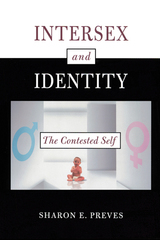 Intersex and Identity: The Contested Self
Sharon E. Preves
Rutgers University Press, 2003 Approximately one in every two thousand infants born in America each year is sexually ambiguous in such a way that doctors cannot immediately determine the child’s sex. Some children’s chromosomal sexuality contradicts their sexual characteristics. Others have the physical traits of both sexes, or of neither. Is surgical intervention or sex assignment of intersexed children necessary for their physical and psychological health, as the medical and mental health communities largely assume? Should parents raise sexually ambiguous children as one gender or another and keep them ignorant of their medical history? Drawing upon life history interviews with adults who were treated for intersexuality as children, Sharon E. Preves explores how such individuals experience and cope with being labeled sexual deviants in a society that demands sexual conformity. Preves frames their stories within a sociological discussion of gender, the history of intersex medicalization, the recent political mobilization of intersexed adults, and the implications of their activism on identity negotiation, medical practice, and cultural norms. By demonstrating how intersexed people manage and create their own identities, often in conflict with their medical diagnosis, Preves argues that medical intervention into intersexuality often creates, rather than mitigates, the stigma these people suffer.
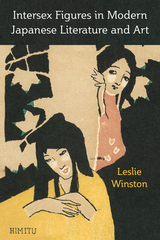 Intersex Figures in Modern Japanese Literature and Art
Leslie Winston
University of Michigan Press, 2025 Intersex Figures in Modern Japanese Literature and Art explores the history of intersex or futanari figures in modern Japanese literature and culture to examine the provocative discourses that defied a sexual regime as the modern nation-state of Japan advanced its national and imperial designs. As sexologists and medical practitioners continued reinforcing categories of “male” and “female,” “normal” and “pathological,” intersex literary figures garnered attention because the perceived subject was expected to be male or female—any variation was unintelligible. Many of the same century-old tropes and societal attitudes of needing to “cure” intersex persist. At the same time the 1991 novel Ringu by Suzuki Kōji testifies to a denial of futanari subjectivity, while the 1998 Japanese horror film (Ringu) and its 2002 American remake (The Ring) erase intersex all together.
Winston interrogates how the trope of the futanari is deployed for pragmatic or aesthetic purposes, thereby complicating the trajectory of the dominant sexological ideology of the time. Winston reads the figurative futanari in the works of Shimizu Shikin, Tanizaki Jun’ichirō, and Takabatake Kashō, and reveals how the artists’ different approaches to the futanari served their agendas and expressed views that challenged the dominant discourse on intersex.
 Intersexual Persons and Theology of the Body: A Limit Case for John Paul II's Theological Anthropology
Beth Zagrobelny Lofgren
Catholic University of America Press Intersexual Persons and Theology of the Body offers an interpretation of John Paul II’s theology of the body that demonstrates how it can encompass intersexual bodies. Intersexuality has been used to challenge binary anthropologies, such as the late pope’s. Beth Zagrobelny Lofgren theorizes that John Paul II’s anthropology answers the “frequency dilemma,” by learning from male and female bodies while respecting the humanity of people with ambiguous bodies.
To argue this, Intersexual Persons and Theology of the Body offers biological, psychological, and theological literature on intersexuality (focusing on the anthropologies of Susannah Cornwall and Megan DeFranza), followed by the late pope’s anthropology (focusing on original solitude, the spousal meaning of the body, and the semiotic meanings of the body). This volume demonstrate that intersexual bodies have a spousal meaning, although obscured, and use original solitude to show that John Paul II attributes to the human body meaning not dependent on sexual difference: the first man learns from his solitary body that he is relational. This relationality is fundamental to the imago Dei and undergirds the imago Dei found in communion. Intersexual bodies share human nature and thus the bodily call to relationship.
Finally, Lofgren argues that John Paul II’s eschatology involves a transformation of humankind that fulfills the semiotic value of the body. The sign gives way to the mystery: the person fully realized as self-gift. Because the mystery does not depend on the sign, this vision includes intersexual bodies. This discussion leads to a brief consideration of celibacy and marriage for persons with intersexual conditions. This is currently the only application of John Paul II’s theology of the body to these complex situations.
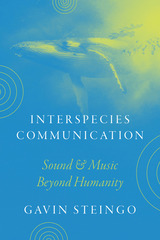 Interspecies Communication: Sound and Music beyond Humanity
Gavin Steingo
University of Chicago Press, 2024 A surprising study reveals a plethora of attempts to communicate with non-humans in the modern era.
In Interspecies Communication, music scholar Gavin Steingo examines significant cases of attempted communication beyond the human—cases in which the dualistic relationship of human to non-human is dramatically challenged. From singing whales to Sun Ra to searching for alien life, Steingo charts the many ways we have attempted to think about, and indeed to reach, beings that are very unlike ourselves.
Steingo focuses on the second half of the twentieth century, when scientists developed new ways of listening to oceans and cosmic space—two realms previously inaccessible to the senses and to empirical investigation. As quintessential frontiers of the postwar period, the outer space of the cosmos and the inner space of oceans were conceptualized as parallel realities, laid bare by newly technologized “ears.” Deeply engaging, Interspecies Communication explores our attempts to cross the border between the human and non-human, to connect with non-humans in the depths of the oceans, the far reaches of the universe, or right under our own noses.
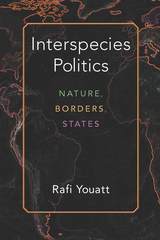 Interspecies Politics: Nature, Borders, States
Rafi Youatt
University of Michigan Press, 2020 This book explores the ways that international politics is a form of interspecies politics, one that involves the interactions, ideas, and practices of multiple species, both human and nonhuman, to generate differences and create commonalities. While we frequently think of having an international politics “of” the environment, a deep and thoroughgoing anthropocentrism guides our idea of what political life can be, which prevents us from thinking about a politics “with” the environment. This anthropocentric assumption about politics drives both ecological degradation and deep forms of interhuman injustice and hierarchy. Interspecies Politics challenges that assumption, arguing that a truly ecological account of interstate life requires us to think about politics as an activity that crosses species lines. It therefore explores a postanthropocentric account of international politics, focusing on a series of cases and interspecies practices in the American borderlands, ranging from the US-Mexico border in southern Texas, to Guantánamo Bay in Cuba, to Isle Royale, near the US-Canadian border. The book draws on international relations, environmental political theory, anthropology, and animal studies, to show how key international dimensions of states—sovereignty, territory, security, rights—are better understood as forms of interspecies assemblage that both generate new forms of multispecies inclusion, and structure forms of violence and hierarchy against human and nonhuman alike.
Interstate
Chard deNiord
University of Pittsburgh Press, 2015 Interstate is a collection of lyrical poems in four sections that concentrate thematically on animals, love and sex, compassion, and loss. A unifying elegiac conceit, even in the more ecstatic and humorous poems, betrays the bittersweet nature of the book's muse. Alternating between free and formal verse, the poems contain a lyrical tension in which their "broken music" evokes metaphysical paradoxes, romantic humor, and the "dark sounds" that effect what Garcia Lorca called "the power everyone feels" in the mystery of duende "but no philosopher can explain."
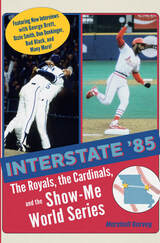 Interstate '85: The Royals, The Cardinals, and the Show-Me World Series
Marshall Garvey
University of Missouri Press, 2025 For 40 years now, the 1985 World Series between the Kansas City Royals and St. Louis Cardinals has been largely overlooked, save for the enduring notoriety of umpire Don Denkinger’s infamous missed call in Game 6 that helped galvanize a walk-off Royals victory that forced a Game 7, in which the Royals won in a blowout. Seizing upon the imagery of the famed Interstate Highway 70 that connects Kansas City and St. Louis, Interstate ’85 goes beyond “The Call” and recasts the 1985 Series as a unique and deeply compelling chapter in baseball history.
In this blend of baseball and cultural history, Garvey defines the “I-70 Showdown Series” not only by the literal highway that links the two teams’ home cities but the individual and collective roads travelled by the players and others who took part in the event, both before the Series began and well after the last cheers faded.
In addition to gripping human stories and vivid descriptions of on-field action long overshadowed by Denkinger’s monumental blunder, Garvey’s work captures the provincial spectacle of the “Show-Me Series” throughout the state of Missouri. Featuring 27 new interviews conducted by the author, including with George Brett, Ozzie Smith, Don Denkinger, Bud Black, Andy Van Slyke, Ricky Horton, and Mark Gubicza, Interstate ’85 is baseball history writing at its deepest and most captivating.
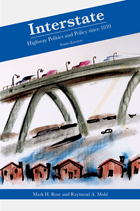 Interstate: Highway Politics and Policy Since 1939
Mark H. Rose
University of Tennessee Press, 2012
This new, expanded edition brings the story of the Interstates into the twenty-first century. It includes an account of the destruction of homes, businesses, and communities as the urban expressways of the highway network destroyed large portions of the nation’s central cities. Mohl and Rose analyze the subsequent urban freeway revolts, when citizen protest groups battled highway builders in San Francisco, Baltimore, Memphis, New Orleans, Washington, DC, and other cities. Their detailed research in the archival records of the Bureau of Public Roads, the Federal Highway Administration, and the U.S. Department of Transportation brings to light significant evidence of federal action to tame the spreading freeway revolts, curb the authority of state highway engineers, and promote the devolution of transportation decision making to the state and regional level. They analyze the passage of congressional legislation in the 1990s, especially the Intermodal Surface Transportation Efficiency Act (ISTEA), that initiated a major shift of Highway Trust Fund dollars to mass transit and light rail, as well as to hiking trails and bike lanes. Mohl and Rose conclude with the surprising popularity of the recent freeway teardown movement, an effort to replace deteriorating, environmentally damaging, and sometimes dangerous elevated expressway segments through the inner cities. Sometimes led by former anti-highway activists of the 1960s and 1970s, teardown movements aim to restore the urban street grid, provide space for new streetcar lines, and promote urban revitalization efforts. This revised edition continues to be marked by accessible writing and solid research by two well-known scholars.
 Interstices: Negotiations at Contemporary Art’s Boundaries
Alexander Alberro
University of Chicago Press, 2025 An exploration of innovative practices flourishing at the margins of Western art.
With this book, Alexander Alberro engages decolonial theory to explore the dynamic exchanges that occur where the ideals and values of different artistic frameworks meet. Resisting notions of a singular art world and global contemporary art, Alberro explores what lies outside of Western art’s hegemonic presence, recognizing the rich multitude of art formations at its periphery, each with its own artistic narratives and conventions. Alberro brings into focus the complex negotiations that are cultivating innovation and transformation at the margins of Western art, showing how this seemingly monolithic framework is both crucial to and insufficient for a comprehensive understanding of contemporary art.
His examples include artists and collectives from around the world, including Iosu Aramburu, Subhankar Banerjee, Yto Barrada, Mabe Bethônico, El Colectivo, Maria Galindo and Mujeres Creando, Bouchra Khalili, Multiplicity, Lucy Orta, Raqs Media Collective, Tracey Rose, Doris Salcedo, Yinka Shonibare, World of Matter, and Yin Xiuzhen. As notions of transculturation and decoloniality continue to drive conversations about contemporary art, Interstices offers a critical explanation of what is at stake, showing how the tensions at the edges of the Western art framework are pushing it toward its discursive limits.
Interstitial Archaeology
Felicia Zamora
University of Wisconsin Press, 2025 Water permeates this stunning collection—ocean, lake, saliva, tears, sweat, blood—and the deeper Felicia Zamora excavates, the sheerer it becomes. Revisiting her childhood as a Latina living in poverty in the United States, Zamora explores racial trauma, estrangement from inherted culture and language, and the instinct to retreat into the body as a space of understanding. Grounded in the specificity of her history, her body, and her life, these poems find the universal threads that constellate hummingbirds to whales, Galapagos tortoises to Matt Groening cartoons, family photographs to joy and heartache, and an insistence on human connectivity.
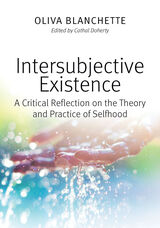 Intersubjective Existence: A Critical Reflection on the Theory and the Practice of Selfhood
Oliva Blanchette
Catholic University of America Press, 2021 Intersubjective Existence, as the author notes, aims, first, to develop a wisdom about human life that takes the form of a theory of selfhood and, second, to reflect on what is called for in the ethical practice of human existence. Secondly, the ethical implications of this theory of selfhood are
explored, specifically looking at conscience, prudential reasoning, justice, friendship, the law, temperance, courage, and concluding with a brief treatment of religion.
Olivia Blanchette charts the path of his inquiry through an analysis of reflective self-consciousness in selves communing with one another. They are constituted in their substance as a union of body and soul, with intelligence and free will that give rise to cultures in communion with other selves. These cultures are over and above what is given to each self in sense consciousness and in sense appetites and which each one contends with in the exercise of selfhood and the rights that go with that in keeping with justice. Concern for right reasoning and justice leads to an analysis of temperance and courage.
The chief arguments take the form of phenomenological reflections on the building blocks of the perennial philosophy. Blanchette recasts Aristotelian-Thomistic metaphysics from the perspective of a phenomenology of the mutual recognition of agents and the historical consciousness to which it gives rise.
Intertextual Encounters in American Fiction, Film, and Popular Culture
Michael Dunne
University of Wisconsin Press, 2001 Intertextual encounters occur whenever an author or the author’s text recognizes, references, alludes to, imitates, parodies, or otherwise elicits an audience member’s familiarity with other texts. F. Scott Fitzgerald and Nathanael West use the fiction of Horatio Alger, Jr., as an intertext in their novels, The Great Gatsby and A Cool Million. Callie Khouri and Ridley Scott use the buddy-road-picture genre as an intertext for their Thelma and Louise. In all these cases, intertextual encounters take place between artists, between texts, between texts and audiences, between artists and audiences. Michael Dunne investigates works from the 1830s to the 1990s and from the canonical American novel to Bugs Bunny and Jerry Seinfeld.
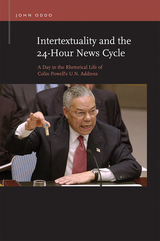 Intertextuality and the 24-Hour News Cycle: A Day in the Rhetorical Life of Colin Powell's U.N. Address
John Oddo
Michigan State University Press, 2014 On a cold Wednesday morning in February 2003 Colin Powell argued before the United Nations Security Council that Iraq harbored weapons of mass destruction. Before the speech, nearly 90 percent of Americans reported that Powell’s speech would help them determine their view about invading Iraq. In the days after the speech, a strong majority of Americans reported that they found Powell’s evidence convincing enough to justify war. But most American adults did not watch Powell’s speech. Instead, they learned about it from journalists—and to a large extent formed their opinions about war with Iraq based on news coverage of his address. In Intertextuality and the 24-Hour News Cycle John Oddo investigates the “rhetorical life” of Colin Powell’s address as it was extended across several media reports. Focusing on one day of pre- and postspeech news coverage, Oddo examines how journalists influenced Powell’s presentation— precontextualizing and recontextualizing his speech, and prepositioning and repositioning audiences to respond to it. The book surveys a variety of news media (television, newspaper, and Internet) and systematically integrates several methodological approaches (critical, rhetorical, discourse-analytic, and multimodal). This revealing text shows the decisive role that journalists played in shaping American attitudes about Powell, his presentation, and the desirability of war in Iraq.
 The Interval of Freedom: Soviet Literature During the Thaw, 1954-1957
George Gibian
University of Minnesota Press, 1960
The Interval of Freedom was first published in 1960. Minnesota Archive Editions uses digital technology to make long-unavailable books once again accessible, and are published unaltered from the original University of Minnesota Press editions.
When Boris Pasternak's Doctor Zhivago was published in Europe and America in 1957 and 1958, the Western world was astonished and elated. But Doctor Zhivago is not the only significant literary work to come out of Soviet Russia recently. During four extraordinary years, 1954 to 1957, from Stalin's death to the aftermath of the Hungarian revolt, Soviet Russian authors were able to express their minds with unusual freedom. In this volume Professor Gibian examines various revelations made in Soviet literature during this interval of comparative freedom.
Nearly a score of contemporary Soviet writers are considered in detail. The authors and their works are grouped according to three major subjects to which Soviet writers have devoted much attention: science, love and sex, and the literary villain or "negative" character. Works of the following writers are discussed in depth: Alexander Bek, Leonid Leonov, Daniel Granin, Venyamin Kaverin, Vladimir Dudintsev, Semen Kirsanov, S. Aleshin, Viktor Nekrasov, Nikolai Pogodin, Galina Nikolaeva, Alexander Korneichuk, Alexander Shtein, Alexander Volodin, Nikolai Gorbunov, Nikolai Zhdanov, and Alexander Yahin. An entire chapter is devoted to Doctor Zhivago. In an introductory chapter, the author provides a survey of literary developments during the interval of freedom. In a final chapter he draws conclusions about the nature of the thinking of Soviet literary intelligentsia, comparing it with Western literary thought. The book is illuminating from social and political as well as literary viewpoints.
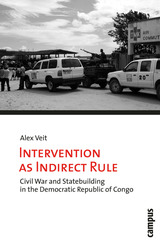 Intervention as Indirect Rule: Civil War and Statebuilding in the Democratic Republic of Congo
Alex Veit
Campus Verlag, 2010 One of the largest peace-keeping missions currently being undertaken by the United Nations is in the Democratic Republic of Congo, where the UN is attempting to deal with the civil wars and other conflicts that have plagued the country since 1996. In Intervention as Indirect Rule, Alex Veit uses a close study of the district of Ituri, a major battlefield and a laboratory for international intervention, to explore the micropolitics of warfare and statebuilding. Combining detailed firsthand empirical data with a historically informed analysis, Veit shows the effect that contemporary humanitarian interventions have on state-society relations. He also pays particular, and much needed, attention to the question of why the very organizations that should be helping with international statebuilding efforts—local authorities and civil society groups—so often instead turn out to be corrupt or hostile. Ultimately Veit argues that international intervention tends inadvertently to replicate—or even amplify—historical structures of political inequality, rather than establishing a liberal form of statehood.
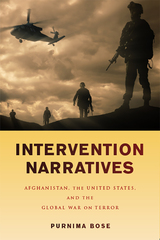 Intervention Narratives: Afghanistan, the United States, and the Global War on Terror
Purnima Bose
Rutgers University Press, 2020 Intervention Narratives examines the contradictory cultural representations of the US intervention in Afghanistan that help to justify an imperial foreign policy. These narratives involve projecting Afghans as brave anti-communist warriors who suffered the consequences of American disengagement with the region following the end of the Cold War, as victimized women who can be empowered through enterprise, as innocent dogs who need to be saved by US soldiers, and as terrorists who deserve punishment for 9/11. Given that much of public political life now involves affect rather than knowledge, feelings rather than facts, familiar recurring tropes of heroism, terrorism, entrepreneurship, and canine love make the war easier to comprehend and elicit sympathy for US military forces. An indictment of US policy, Bose demonstrates that contemporary imperialism operates on an ideologically diverse cultural terrain to enlist support for the war across the political spectrum.
Intervention, Revolution, and Politics in Cuba, 1913-1921
Louis A., Jr. Perez
University of Pittsburgh Press, 1978 Perez views the various economic, political and diplomatic methods used by the United States government to exert hegemony over Cuba from 1913-1921. He also examines the political turmoil and collapse of the traditional Cuban party structure, as candidates were forced to forge alliances with the U.S.
Interventions for Women
Angela Hume
Omnidawn, 2021 Poems that address cultural pressures placed on women and girls.
This is a book for those who were raised to be girls and expected to become women, for those who were told they were too girly and not girly enough, and for those who were ogled, talked over, touched, fed, imagined, and indoctrinated in ways they didn’t want. Angela Hume writes directly about the experience of womanhood, addressing the boundaries and pressures imposed from childhood on. She considers the persistent instructions to smile, be quiet, and act happy, all administered with the promise that this forced behavior would make everything better. The poems address rigid social norms and, ultimately, walk through the uncomfortable realizations about the bigger systems at play and call on us to examine our own complicity in them.
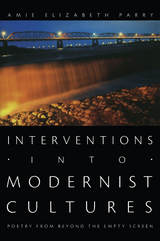 Interventions into Modernist Cultures: Poetry from Beyond the Empty Screen
Amie Elizabeth Parry
Duke University Press, 2007 Interventions into Modernist Cultures is a comparative analysis of the cultural politics of modernist writing in the United States and Taiwan. Amie Elizabeth Parry argues that the two sites of modernism are linked by their representation or suppression of histories of U.S. imperialist expansion, Cold War neocolonial military presence, and economic influence in Asia. Focusing on poetry, a genre often overlooked in postcolonial theory, she contends that the radically fragmented form of modernist poetic texts is particularly well suited to representing U.S. imperialism and neocolonial modernities. Reading various works by U.S. expatriates Ezra Pound and Gertrude Stein, Parry compares the cultural politics of U.S. canonical modernism with alternative representations of temporality, hybridity, erasure, and sexuality in the work of the Taiwanese writers Yü Kwang-chung and Hsia Yü and the Asian American immigrant author Theresa Hak Kyung Cha. Juxtaposing poems by Pound and Yü Kwang-chung, Parry shows how Yü’s fragmented, ambivalent modernist form reveals the effects of neocolonialism while Pound denies and obscures U.S. imperialism in Asia, asserting a form of nondevelopmental universalism through both form and theme. Stein appropriates discourses of American modernity and identity to represent nonnormative desire and sexuality, and Parry contrasts this tendency with representations of sexuality in the contemporary experimental poetry of Hsia Yü. Finally, Parry highlights the different uses of modernist forms by Pound in his Cantos—which incorporate a multiplicity of decontextualized and ahistorical voices—and by Cha in her 1982 novel Dictee, a historicized, multilingual work. Parry’s sophisticated readings provide a useful critical framework for apprehending how “minor modernisms” illuminate the histories erased by certain canonical modernist texts.
(Inter)views: Cross-Disciplinary Perspectives on Rhetoric and Literacy
Gary A. Olson
Southern Illinois University Press, 1991
This book contains interviews with psychologist Mary Field Belenky, linguist and philosopher of language Noam Chomsky, French deconstructionist Jacques Derrida, international literacy scholar Paulo Freire, distinguished anthropologist Clifford Geertz, philosopher Richard Rorty, and cultural critic Gayatri Chakravorty Spivak (all of whose work has influenced the discipline of rhetoric and composition) followed by essay responses from notable scholars in rhetoric and composition.
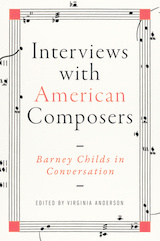 Interviews with American Composers: Barney Childs in Conversation
Barney Childs. Edited by Virginia Anderson
University of Illinois Press, 2022 In 1972-73, Barney Childs embarked on an ambitious attempt to survey the landscape of new American concert music. He recorded freewheeling conversations with fellow composers, most of them under forty, all of them important but most not yet famous. Though unable to publish the interviews in his lifetime, Childs had gathered invaluable dialogues with the likes of Robert Ashley, Olly Wilson, Harold Budd, Christian Wolff, and others. Virginia Anderson edits the first published collection of these conversations. She pairs each interview with a contextual essay by a contemporary expert that shows how the composer's discussion with Childs fits into his life and work. Together, the interviewees cover a broad range of ideas and concerns around topics like education, notation, developments in electronic music, changing demands on performers, and tonal music. Innovative and revealing, Interviews with American Composers is an artistic and historical snapshot of American music at an important crossroads.
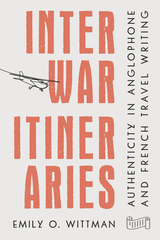 Interwar Itineraries: Authenticity in Anglophone and French Travel Writing
Emily O. Wittman
Amherst College Press, 2022 How people traveled, and how people wrote about travel, changed in the interwar years. Novel technologies eased travel conditions, breeding new iterations of the colonizing gaze. The sense that another war was coming lent urgency and anxiety to the search for new places and “authentic” experiences. In Interwar Itineraries: Authenticity in Anglophone and French Travel Writing, Emily O. Wittman identifies a diverse group of writers from two languages who embarked on such quests. For these writers, authenticity was achieved through rugged adventure abroad to economically poorer destinations. Using translation theory and new approaches in travel studies and global modernisms, Wittman links and complicates the symbolic and rhetorical strategies of writers including André Gide, Ernest Hemingway, Michel Leiris, Isak Dinesen, Beryl Markham, among others, that offer insight into the high ethical stakes of travel and allow us to see in new ways how models of the authentic self are built and maintained through asymmetries of encounter.
“This book offers a valuable account of literary activity in a genre still inadequately covered in literary-critical history. Emily Witt- man organizes her material through pairings and contextualizing that are instructive and illuminating and often exciting . . . This is comparative literature at its best.” —Vincent Sherry, Washington University
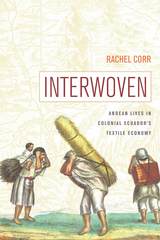 Interwoven: Andean Lives in Colonial Ecuador’s Textile Economy
Rachel Corr
University of Arizona Press, 2018 In the 1600s, Marcos Cunamasi, an indigenous man in Pelileo, Ecuador, hid his child to protect him from officials who would put the boy to work in the textile mill. Cunamasi was forced to turn him over. Because his young son couldn’t keep up with spinning his quota of wool per day, Cunamasi helped so the child wouldn’t be whipped. After working a year, Cunamasi was paid a shirt and a hat.
Interwoven is the untold story of indigenous people’s historical experience in colonial Ecuador’s textile economy. It focuses on the lives of Native Andean families in Pelileo, a town dominated by one of Quito’s largest and longest-lasting textile mills. Quito’s textile industry developed as a secondary market to supply cloth to mining centers in the Andes; thus, the experience of indigenous people in Pelileo is linked to the history of mining in Bolivia and Peru.
Although much has been written about colonial Quito’s textile economy, Rachel Corr provides a unique perspective by putting indigenous voices at the center of that history. Telling the stories of Andean families of Pelileo, she traces their varied responses to historical pressures over three hundred years; the responses range from everyday acts to the historical transformation of culture through ethnogenesis. These stories of ordinary Andean men and women provide insight into the lived experience of the people who formed the backbone of Quito’s textile industry.
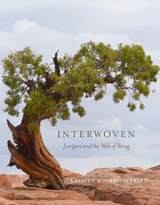 Interwoven: Junipers and the Web of Being
Kristen Rogers-Iversen
University of Utah Press, 2017 Copublished with the Utah State Historical Society. Affiliated with the Utah Division of State History, Utah Department of Heritage & Arts.
Throughout prehistory and history, junipers have influenced ecosystems, cultures, mythologies, economics, politics, and environmental controversies. In terms of their effects on human lives the juniper may be the most significant tree in the interior West. Interwoven explores these interconnecting aspects of junipers. Ghost beads, biotic communities, gin, tree masticators, Puebloan diapers, charcoal, folklore, historic explorers, spiral grain, tree life cycles, spirituality, packrat middens, climate changes, wildfire, ranching, wilderness, and land management policies are among the many different threads the book follows. These and other topics shed light on a fascinating organism, but the book is more than a compilation of facts. At once a scientific, experiential, historical, and metaphorical walk among junipers and their interrelationships, Interwoven may change readers’ experiences with these trees and the natural world.
Finalist for the Utah State Historical Society Best Book Award.
Finalist for the 2019 ASLE Book Award for excellence in ecocriticism and environmental creative writing.
Named a “notable book” by the prize committee of the 2018 Sigurd F. Olson Nature Writing Award.
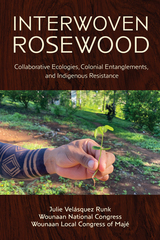 Interwoven Rosewood: Collaborative Ecologies, Colonial Entanglements, and Indigenous Resistance
Julie Velásquez Runk, the Wounaan National Congress, and the Wounaan Local Congress of Majé
University of Arizona Press, 2026 Interweaving Rosewood is a collaborative exploration of the global rosewood trade and its entanglements with Indigenous lifeways, colonial histories, and environmental crises. Co-authored by Julie Velásquez Runk and members of the Wounaan National Congress and its Local Congress of the Majé community, this book traces the story of cocobolo rosewood from Wounaan lands in Panama to international markets, revealing how centuries of settler colonialism and extractive capitalism continue to shape landscapes, livelihoods, and relationships. At its heart, the book is a meditation on well-being and belonging—how people live in relation to land, each other, and the more-than-human world.
Drawing on more than a decade of community-based research and six collaborative book workshops, the authors weave together first-person narratives, ecological analysis, historical context, and Indigenous knowledge. The result is a richly textured account that challenges dominant narratives of environmental degradation by centering Wounaan experiences of joy, resistance, and conviviality. The book’s structure reflects its method: interwoven chapters authored or spoken by Wounaan colleagues, grounded in consent protocols and shaped by ancestral storytelling traditions.
Accessibly written, Interweaving Rosewood is ideal for courses in environmental conservation, Indigenous studies, anthropology, Latin American studies, and political ecology. With its interdisciplinary reach and classroom-ready discussion questions, the book invites readers to reflect on the global forces behind environmental catastrophe—and the enduring power of Indigenous ways of knowing, being, and becoming.
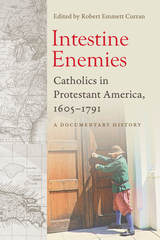 Intestine Enemies
Robert Emmett Curran
Catholic University of America Press, 2017 Intestine Enemies: Catholics in Protestant America, 1605-1791is a documentary survey of the experience of Roman Catholics in the British Atlantic world from Maryland to Barbados and Nova Scotia to Jamaica over the course of the two centuries that spanned colonization to independence. It covers the first faltering efforts of the British Catholic community to establish colonies in the late sixteenth and early seventeenth centuries; to their presence in the proprietary and royal colonies of the seventeenth century where policies of formal or practical toleration allowed Catholics some freedom for civic or religious participation; to their marginalization throughout the British Empire by the political revolution of 1688; to their transformation from aliens to citizens through their disproportionate contribution to the wars in the latter half of that century as a consequence of which half of the colonies of Britain’s American Empire gained their independence. The volume organizes representative documents from a wide array of public and private records – broadsides, newspapers, and legislative acts to correspondence, diaries, and reports – into topical chapters bridged by contextualized introductions. It affords students and readers in general the opportunity to have first-hand access to history. It serves also as a complement to Papist Devils: Catholics in British America, 1574-1783, a narrative history of the same topic.
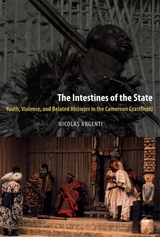 The Intestines of the State: Youth, Violence, and Belated Histories in the Cameroon Grassfields
Nicolas Argenti
University of Chicago Press, 2007 The young people of the Cameroon Grassfields have been subject to a long history of violence and political marginalization. For centuries the main victims of the slave trade, they became prime targets for forced labor campaigns under a series of colonial rulers. Today’s youth remain at the bottom of the fiercely hierarchical and polarized societies of the Grassfields, and it is their response to centuries of exploitation that Nicolas Argenti takes up in this absorbing and original book.
Beginning his study with a political analysis of youth in the Grassfields from the eighteenth century to the present, Argenti pays special attention to the repeated violent revolts staged by young victims of political oppression. He then combines this history with extensive ethnographic fieldwork in the Oku chiefdom, discovering that the specter of past violence lives on in the masked dance performances that have earned intense devotion from today’s youth. Argenti contends that by evoking the imagery of past cataclysmic events, these masquerades allow young Oku men and women to address the inequities they face in their relations with elders and state authorities today.
 Intimacies
Leo Bersani and Adam Phillips
University of Chicago Press, 2008 Two gifted and highly prolific intellectuals, Leo Bersani and Adam Phillips, here present a fascinating dialogue about the problems and possibilities of human intimacy. Their conversation takes as its point of departure psychoanalysis and its central importance to the modern imagination—though equally important is their shared sense that by misleading us about the importance of self-knowledge and the danger of narcissism, psychoanalysis has failed to realize its most exciting and innovative relational potential.
In pursuit of new forms of intimacy they take up a range of concerns across a variety of contexts. To test the hypothesis that the essence of the analytic exchange is intimate talk without sex, they compare Patrice Leconte’s film about an accountant mistaken for a psychoanalyst, Intimate Strangers, with Henry James’s classic novella The Beast in the Jungle. A discussion of the radical practice of barebacking—unprotected anal sex between gay men—delineates an intimacy that rejects the personal. Even serial killer Jeffrey Dahmer and the Bush administration’s war on terror enter the scene as the conversation turns to the way aggression thrills and gratifies the ego. Finally, in a reading of Socrates’ theory of love from Plato’s Phaedrus, Bersani and Phillips call for a new form of intimacy which they term “impersonal narcissism”: a divestiture of the ego and a recognition of one’s non-psychological potential self in others. This revolutionary way of relating to the world, they contend, could lead to a new human freedom by mitigating the horrifying violence we blithely accept as part of human nature.
Charmingly persuasive and daringly provocative, Intimacies is a rare opportunity to listen in on two brilliant thinkers as they explore new ways of thinking about the human psyche.
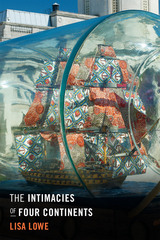 The Intimacies of Four Continents
Lisa Lowe
Duke University Press, 2015 In this uniquely interdisciplinary work, Lisa Lowe examines the relationships between Europe, Africa, Asia, and the Americas in the late eighteenth- and early nineteenth- centuries, exploring the links between colonialism, slavery, imperial trades and Western liberalism. Reading across archives, canons, and continents, Lowe connects the liberal narrative of freedom overcoming slavery to the expansion of Anglo-American empire, observing that abstract promises of freedom often obscure their embeddedness within colonial conditions. Race and social difference, Lowe contends, are enduring remainders of colonial processes through which “the human” is universalized and “freed” by liberal forms, while the peoples who create the conditions of possibility for that freedom are assimilated or forgotten. Analyzing the archive of liberalism alongside the colonial state archives from which it has been separated, Lowe offers new methods for interpreting the past, examining events well documented in archives, and those matters absent, whether actively suppressed or merely deemed insignificant. Lowe invents a mode of reading intimately, which defies accepted national boundaries and disrupts given chronologies, complicating our conceptions of history, politics, economics, and culture, and ultimately, knowledge itself.
 Intimacy
Edited by Lauren Berlant
University of Chicago Press, 2000 Last year's impeachment of President Bill Clinton demonstrated the paradox, but did not begin to explain it.
How is it that "private matters" are analyzed endlessly in public forums on a daily basis? Why is it assumed that "getting a life" means having a private relationship? Intended to unravel some of the tangled relations that fall under the broad category of "intimacy," this provocative collection of sixteen essays articulates the ways in which intimate lives are connected with the institutions, ideologies, and desires that organize people's worlds.
Locating its domain in the familiar spaces of friendship, love, sex, family, and feeling "at home," Intimacy also examines the estrangement, betrayal, loneliness, and even violence that may accompany the demise of relationships, both personal and political. These include intimacies among strangers, such as happens in times of national scandal or habits of everyday life. The contributors to this volume traverse many disciplines and cultures, tracking the processes by which intimate lives absorb and repel the dominant rhetoric, law, ethics, and ideologies of public spheres. Drawing on examples from contemporary culture, history, art, literature, and music, this book illuminates the ways in which intimacy has become linked with stories of citizenship, capitalism, aesthetic forms, and the writing of history. As it challenges conventional notions of private life, Intimacy is sure to spark controversy about its institutions as well.
Some of these essays in this book were previously published in an award-winning issue of the journal "Critical Inquiry."
Contributors include Lauren Berlant, Svetlana Boym, Steven Feld, Deborah R. Grayson, Michael Hanchard, Dagmar Herzog, Annamarie Jagose, Laura Kipnis, Laura Letinsky, Biddy Martin, Maureen McLane, Mary Poovey, Elizabeth A. Povinelli, Eve Kosovsky Sedgwick, Joel Snyder, Candace Vogler, Michael Warner, and others.
Intimacy
Catherine Imbriglio
University Press of Colorado, 2013 Winner of the 2013 Colorado Prize for Poetry
Intimacy is a series of experimental poems that play with, resist, and acknowledge complicity with received concepts of intimacy that circulate in this media-centric age. Undertaking an expansive understanding of the word “intimacy”, each poem contains a word or set of words that modifies the noun, uncovering the attending, associative and often contradictory obligations that arise in our relations with one another.
 Intimacy: A Novel
Stanley Crawford
University of Alabama Press, 2016 Intimacy is the story of an unnamed narrator ruminating on suicide. He reflects on the origins and significance of his material possessions, and on the seemingly inconsequential moments in his life, while he prepares to carry out his plans.
In this melancholy novel about a man on the brink of suicide, Stanley Crawford allows readers to question what it really means to be close to a person. Intimacy follows an unnamed narrator planning his own death. His preparations become a trigger and occasion for him to revisit key moments in his life and his material possessions, which are the solid artifacts from his life’s journey.
As sparrows in flight might form a single arrow, the life of the narrator comes into focus as a collage of fleeting events and images. Readers gain insights into tiny moments that slowly build into a picture of a man who seems to have very little, aside from material possessions, to lose.
The narrative pulls the reader along a trail of digressions—about running shoes, about the symbolism of rings—that lead down a proverbial rabbit hole until we realize the narrator’s intentions. Despite our lack of concrete knowledge about the narrator’s life, he allows us to share his thought processes: how every thought leads to the next, how memories seep upward when he picks up a particular T-shirt, or when he glimpses his car keys. And alongside our growing understanding of the narrator comes a recognition of our own thought processes: how we, like him, relate to our bodies; how we, too, cannot break away from the constant motion of our thoughts.
Intimacy is a brief, intense novel charged with the heightened sense of closeness that comes from watching a man’s last hours. It illuminates how brief snapshots of memory can trace the outline of an entire life.
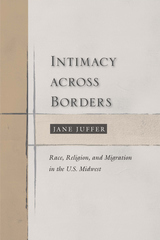 Intimacy Across Borders: Race, Religion, and Migration in the U.S. Midwest
Jane Juffer
Temple University Press, 2013 Examining how encounters produced by migration lead to intimacies-ranging from sexual, spiritual, and neighborly to hateful and violent, Jane Juffer considers the significant changes that have occurred in small towns following an influx of Latinos to the Midwest.
Intimacy across Borders situates the story of the Dutch Reformed Church in Iowa and South Africa within a larger analysis of race, religion, and globalization. Drawing on personal narrative, ethnography, and sociopolitical critique, Juffer shows how migration to rural areas can disrupt even the most thoroughly entrenched religious beliefs and transform the schools, churches, and businesses that form the heart of small-town America. Conversely, such face-to-face encounters can also generate hatred, as illustrated in the increasing number of hate crimes against Latinos and the passage of numerous anti-immigrant ordinances. Juffer demonstrates how Latino migration to new areas of the U.S. threatens certain groups because it creates the potential for new kinds of families—mixed race, mixed legal status, and transnational—that challenge the conservative definition of community based on the racially homogeneous, coupled, citizen family.
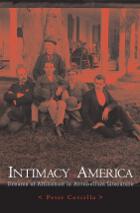 Intimacy in America: Dreams of Affiliation in Antebellum Literature
Peter Coviello
University of Minnesota Press, 2005 Nineteenth-century America was a sprawling new nation unmoored from precedent and the mainstays of European nationalism. In their search for nationality, Americans sought coherence in a feeling of belonging shared among diverse and scattered strangers. Reading seminal works by Thomas Jefferson, Edgar Allan Poe, Herman Melville, Harriet Beecher Stowe, and Walt Whitman, Peter Coviello traces these writers' enthusiasms and their ambivalences about the dream of an intimate nationality, revealing how race and sexuality were used as vehicles for an assumed national coherence. As Coviello shows, race - and especially whiteness - functioned less as a form of identity than as a model of attachment and identification, a language of affiliation. Whiteness created an imaginary fraternity that symbolized citizenship, the ownership of property, and an affinity between strangers, which became entangled in the nation's evolving codes of sexuality. Bringing race theory and "white studies" into dialogue with questions of intimacy and affect, Coviello provides a practical rapprochement between historicist and psychoanalytic methodologies. Intimacy in America gives us a new perspective on the national meanings of race and sex in American literature, as well as on the still-current dream of American-ness as an impassioned relation to far-flung, anonymous others.
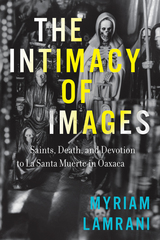 The Intimacy of Images: Saints, Death, and Devotion to La Santa Muerte in Oaxaca
Myriam Lamrani
University of Texas Press, 2024 La Santa Muerte becomes a lens for understanding how Oaxacans relate to saints, loved ones, and other “special dead.” In Oaxaca, images of saints and loved ones, as well as of victims of political or criminal violence, are seemingly everywhere. While Oaxacans relate to all sorts of “special dead,” they are particularly devoted to La Santa Muerte (Saint Death), a female reaper-like figure whose popularity has risen in tandem with violence throughout Mexico. The Intimacy of Images recontextualizes Oaxacans’ relationships with their “special dead” through the lens of La Santa Muerte, examining how devotees closely interact with what Lamrani terms “intimate images”: not only devotional effigies but also photographs, films, tattoos, and murals, and even dreams and visions. Though Mexicans have a well-known cultural familiarity with death, Lamrani argues that devotion to La Santa Muerte builds upon this intimacy even as it also participates in the production of terror and reflects political and criminal violence. Ultimately, Lamrani finds that these human-image interactions represent more than Catholic devotion; they reveal the secrets of Oaxacan political, religious, and social life, embody changing relationships to mortality and violence, and even offer insight into the practice of anthropology itself.
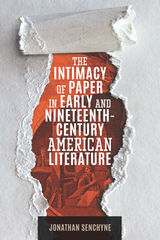 The Intimacy of Paper in Early and Nineteenth-Century American Literature
Jonathan Senchyne
University of Massachusetts Press, 2020 The true scale of paper production in America from 1690 through the end of the nineteenth century was staggering, with a range of parties participating in different ways, from farmers growing flax to textile workers weaving cloth and from housewives saving rags to peddlers collecting them. Making a bold case for the importance of printing and paper technology in the study of early American literature, Jonathan Senchyne presents archival evidence of the effects of this very visible process on American writers, such as Anne Bradstreet, Herman Melville, Lydia Sigourney, William Wells Brown, and other lesser-known figures.
The Intimacy of Paper in Early and Nineteenth-Century American Literature reveals that book history and literary studies are mutually constitutive and proposes a new literary periodization based on materiality and paper production. In unpacking this history and connecting it to cultural and literary representations, Senchyne also explores how the textuality of paper has been used to make social and political claims about gender, labor, and race.
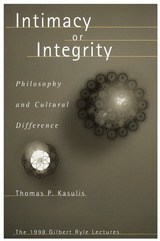 Intimacy or Integrity: Philosophy and Cultural Difference
Thomas P. Kasulis
University of Hawaii Press, 2002 How can I know something? How can I convince someone of the rightness of my position? How does reality function? What is artistic creativity? What is the role of the state? It is well known that people from various cultures give dissimilar answers to such philosophical questions. After three decades in the cross-cultural study of ideas and values, Thomas Kasulis found that culture influences not only the answers to these questions, but often how one arrives at the answers. In generalizing cultural difference, Kasulis identifies two kinds of orientation: intimacy and integrity. Both determine how we think about relations among people and among things, and each is reasonable, effective, and consistent. Yet the two are so incompatible in their basic assumptions that they cannot successfully engage each other.
Cultural difference extends beyond nations. Cultural identities crystallize in relation to religion, occupation, race, gender, class. Rather than attempt to transcend cultural difference, Kasulis urges a deeper awareness of its roots by moving beyond mere cultural relativism toward a cultural bi-orientationality that will allow us to adapt ourselves to different cultural contexts as the situation demands.
Wonderfully clear and unburdened by jargon, Intimacy or Integrity is accessible to readers from a variety of perspectives and backgrounds. By analyzing the synergy between thought and culture, it increases our understanding of cultural difference and guides us in developing strategies for dealing with orientations different from our own.
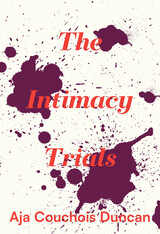 The Intimacy Trials
Aja Couchois Duncan
University of Chicago Press A post-apocalyptic Native poetry collection that creates possibility for repair and reconciliation by holding the simultaneity of a violent past and a hopeful future.
Aja Couchois Duncan’s third book of poetry, The Intimacy Trials, explores cycles of violence, loss, and love that arc across history. Composed of intersecting narratives, this collection follows a post-apocalyptic collective of survivors living in a state of gratitude, shame, and awe amid desecrated ecosystems. The present tense of The Intimacy Trials carries the magnitude of a historic past tense filled with land theft, genocide, settler colonialism, and the vicissitudes of romantic love. Couchois Duncan’s lyrical, concomitant stories produce a space that holds in balance the complexities of life—joy, despair, intimacy, and irreconcilable grief.
In language that is prophetic, lush, and unequivocal, The Intimacy Trials is a loving accountability letter to our past, present, and future selves, holding both our yearning for connection and the remembrance of what has driven us apart.
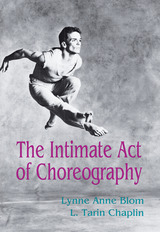 The Intimate Act Of Choreography
Lynne Anne Blom
University of Pittsburgh Press, 1982
A comprehensive book that covers all aspects of choreography from the most fundamental techniques to highly sophisticated artistic concerns. The Intimate Act of Choreography presents the what and how of choreography in a workable format that begins with basics- - time, space, force -- and moves on to the more complex issues faced by the intermediate and advanced choreographer -- form, style, abstraction, compositional structures, and choreographic devices.
The format of the book evolved from the idea that improvisation is a good way to learn choreography. This approach is in harmony with widely accepted dance philosophies that value the unique quality of each individual’s creativity. After discussing a concept, the authors provide improvisations, and choreographic studies that give the student a physical experience of that concept. The language is stimulating an innovative, rich in visual images that will challenge the choreographer to explore new directions in movement.
The book is for serious dance students and professionals who are interested in both the practical and theoretical aspects of the art, dancers who are just starting to choreograph, and teachers who are seeking fresh ideas and new approaches to use with young choreographers. (A Teacher’s Addendum offers suggestions on how to use the material in the classroom.) It is a guide, a text, and an extensive resource of every choreographic concept central to the art form.
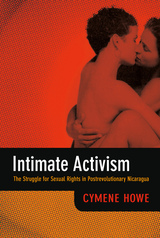 Intimate Activism: The Struggle for Sexual Rights in Postrevolutionary Nicaragua
Cymene Howe
Duke University Press, 2013 Intimate Activism tells the story of Nicaraguan sexual-rights activists who helped to overturn the most repressive antisodomy law in the Americas. The law was passed shortly after the Sandinistas lost power in 1990 and, to the surprise of many, was repealed in 2007. In this vivid ethnography, Cymene Howe analyzes how local activists balanced global discourses regarding human rights and identity politics with the contingencies of daily life in Nicaragua. Though they were initially spurred by the antisodomy measure, activists sought to change not only the law but also culture. Howe emphasizes the different levels of intervention where activism occurs, from mass-media outlets and public protests to meetings of clandestine consciousness-raising groups. She follows the travails of queer characters in a hugely successful telenovela, traces the ideological tensions within the struggle for sexual rights, and conveys the voices of those engaged in "becoming" lesbianas and homosexuales in contemporary Nicaragua.
Intimate: An American Family Photo Album
Paisley Rekdal
Tupelo Press, 2012 Literary Nonfiction. Memoir. Asian American Studies. Native American Studies. INTIMATE is a hybrid memoir and "photo album" that blends personal essay, historical documentary, and poetry to examine the tense relationship between self, society, and familial legacy in contemporary America. Typographically innovative, INTIMATE creates parallel streams, narrating the stories of Rekdal's Norwegian-American father and his mixed-race marriage, the photographer Edward S. Curtis, and Curtis's murdered Apsaroke guide, Alexander Upshaw. The result is panoramic, a completely original literary encounter with intimacy, identity, family relations, and race.
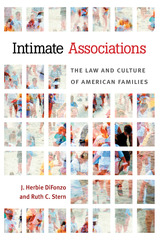 Intimate Associations: The Law and Culture of American Families
J. Herbie DiFonzo and Ruth C. Stern
University of Michigan Press, 2013 The rise in divorce, cohabitation, single parenthood, and same-sex partnerships, along with an increase in surrogacy, adoption, and assisted reproductive technologies, has led to many diverse configurations of families, or intimate associations. J. Herbie DiFonzo and Ruth C. Stern chart these trends over the past several decades and investigate their social, legal, and economic implications. Drawing upon a wealth of social science data, they show that, by a number of measures, children of married parents fare better than children in a household formed by cohabiting adults. This is not to condemn nontraditional families, but to point out that society and the law do not yet adequately provide for their needs. The authors applaud the ways in which courts and legislatures are beginning to replace rigid concepts of marriage and parenthood with the more flexible concept of “functional” family roles. In the conclusion, they call for a legal system that can adapt to the continually changing reality of family life.
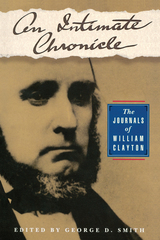 An Intimate Chronicle: The Journals of William Clayton
George D. Smith
Signature Books, 1995 William Clayton is best remembered today for his hymns, especially “Come, Come Ye Saints.” But as one of the earliest Latter-day Saint scribes, he made intellectual as well as artistic contributions to his church, and his records have been silently incorporated into official Mormon scripture and history. Of equal significance are his personal impressions of day-to-day activities, which describe a social and religious world largely unfamiliar to modern readers. In ministering to the sick, for instance, Clayton anointed with perfumed oil and rum. He performed baptisms to heal the sick. Church services, held irregularly, were referred to as “going to meeting” and seemed to be elective. He testifies of people speaking in tongues and of others “almost speaking in tongues.” When introduced to plural marriage, he was reluctant but eventually became one of its most enthusiastic proponents, marrying ten women and fathering forty-two children. Since polygamy was initially secret, Clayton spent much of his time putting out the fires of innuendo and discontent. He caught his first plural wife rendezvousing with her former fiancé; later, when she became pregnant, her mother–his unaware mother-in-law–was so overwrought that she attempted suicide. Joseph Smith reassured him: “Just keep her at home and brook it and if they raise trouble about it and bring you before me I will give you an awful scourging and probably cut you off from the church and then I will set you ahead as good as ever.” Clayton was also the object of Emma Smith’s attentions, allegedly part of a jealous wife’s plan to make a cuckold of her errant husband.
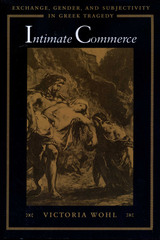 Intimate Commerce: Exchange, Gender, and Subjectivity in Greek Tragedy
By Victoria Wohl
University of Texas Press, 1997 Exchanges of women between men occur regularly in Greek tragedy—and almost always with catastrophic results. Instead of cementing bonds between men, such exchanges rend them. They allow women, who should be silent objects, to become monstrous subjects, while men often end up as lifeless corpses. But why do the tragedies always represent the transferal of women as disastrous? Victoria Wohl offers an illuminating analysis of the exchange of women in Sophocles' Trachiniae, Aeschylus' Agamemnon, and Euripides' Alcestis. She shows how the attempts of women in these plays to become active subjects rather than passive objects of exchange inevitably fail. While these failures seem to validate male hegemony, the women's actions, however futile, blur the distinction between male subject and female object, calling into question the very nature of the tragic self. What the tragedies thus present, Wohl asserts, is not only an affirmation of Athens' reigning ideologies (including its gender hierarchy) but also the possibility of resistance to them and the imagination of alternatives.
Intimate Communities: Representation and Social Transformation in Women's College Fiction, 1895–1910
Sherrie A. Inness
University of Wisconsin Press, 1995 The many popular representations of student life at women’s colleges produced in the United States during the Progressive Era are examined. The college woman was described and defined in a period when women’s higher education was still socially suspect.
While other scholars have argued that the Progressive Era was the “golden age” for women’s single-sex education, pointing to the many positive depictions of the women’s college student, Inness suggests that these representations actually helped to perpetuate the status quo and did little to advance women’s social rights.
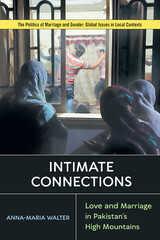 Intimate Connections: Love and Marriage in Pakistan’s High Mountains
Anna-Maria Walter
Rutgers University Press, 2022 Intimate Connections dissects ideas, feelings, and practices around love, marriage, and respectability in the remote high mountains of Gilgit-Baltistan in northern Pakistan. It offers insightful perspectives from the emotional lives of Shia women and their active engagement with their husbands. These gender relations are shaped by countless factors, including embodied values of modesty and honor, vernacular fairy tales and Bollywood movies, Islamic revivalism and development initiatives. In particular, the advent of media and communication technologies has left a mark on (pre)marital relations in both South Asia and the wider Muslim world. Juxtaposing different understandings of ‘love’ reveals rich and manifold worlds of courtship, elopements, family dynamics, and more or less affectionate matches that are nowadays often initiated through SMS. Deep ethnographic accounts trace the relationships between young couples to show how Muslim women in a globalized world dynamically frame and negotiate circumstances in their lives.
 Intimate Creativity: Partners In Love And Art
Irving Sarnoff
University of Wisconsin Press, 2002 Integrating the psychology of love and creativity, this pioneering book explores both how a couple’s involvement as lovers influences their creative collaboration and how working together affects their relationship. Representing a variety of genres—painting, sculpture, photography, and installation art—the celebrated couples profiled here include, among others, Christo and Jeanne-Claude, Elizabeth Diller and Ricardo Scofidio, and Kristin Jones and Andrew Ginzel.
Intrigued by this process of "intimate creativity," psychologists Irving and Suzanne Sarnoff (themselves partners in love and work) decided to conduct in-depth interviews with partners in visual art because they defy the supremely individualistic tradition of their field. Whatever their age or sexual orientation, these artist-couples combine their talents to form a collective identity as a professional team. Passionately intense about their shared commitment, they communicate endlessly to resolve conflicts and reach consensus. Providing mutual validation and support, they increase their productivity and the quality of their work; they minimize their fear and frustration and enhance their pleasure in being together.
The authors also draw on historical and contemporary literature about similar couples, ranging from Jean Arp and Sophie Taeuber to Gilbert and George to Claes Oldenburg and Coosje van Bruggen. Stimulating and engaging, this book highlights the features of a unique collaborative process, considers the connection between creativity and sexuality, and suggests possibilities for any couple to expand their intimacy.
 The Intimate Critique: Autobiographical Literary Criticism
Diane P. Freedman, Olivia Frey, and Frances Murphy Zauhar, eds.
Duke University Press, 1993 For a long time now, readers and scholars have strained against the limits of traditional literary criticism, whose precepts—above all, "objectivity"—seem to have so little to do with the highly personal and deeply felt experience of literature. The Intimate Critique marks a movement away from this tradition. With their rich spectrum of personal and passionate voices, these essays challenge and ultimately breach the boundaries between criticism and narrative, experience and expression, literature and life. Grounded in feminism and connected to the race, class, and gender paradigms in cultural studies, the twenty-six contributors to this volume—including Jane Tompkins, Henry Louis Gates, Jr., Shirley Nelson Garner, and Shirley Goek-Lin Lim—respond in new, refreshing ways to literary subjects ranging from Homer to Freud, Middlemarch to The Woman Warrior, Shiva Naipaul to Frederick Douglass. Revealing the beliefs and formative life experiences that inform their essays, these writers characteristically recount the process by which their opinions took shape--a process as conducive to self-discovery as it is to critical insight. The result—which has been referred to as "personal writing," "experimental critical writing," or "intellectual autobiography"—maps a dramatic change in the direction of literary criticism. Contributors. Julia Balen, Dana Beckelman, Ellen Brown, Sandra M. Brown, Rosanne Kanhai-Brunton, Suzanne Bunkers, Peter Carlton, Brenda Daly, Victoria Ekanger, Diane P. Freedman, Olivia Frey, Shirley Nelson Garner, Henry Louis Gates, Jr., Melody Graulich, Gail Griffin, Dolan Hubbard, Kendall, Susan Koppelman, Shirley Geok-Lin Lim, Linda Robertson, Carol Taylor, Jane Tompkins, Cheryl Torsney, Trace Yamamoto, Frances Murphy Zauhar
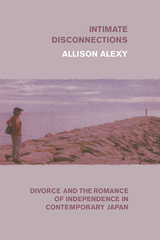 Intimate Disconnections: Divorce and the Romance of Independence in Contemporary Japan
Allison Alexy
University of Chicago Press, 2020 In many ways, divorce is a quintessentially personal decision—the choice to leave a marriage that causes harm or feels unfulfilling to the two people involved. But anyone who has gone through a divorce knows the additional public dimensions of breaking up, from intense shame and societal criticism to friends’ and relatives’ unsolicited advice. In Intimate Disconnections, Allison Alexy tells the fascinating story of the changing norms surrounding divorce in Japan in the early 2000s, when sudden demographic and social changes made it a newly visible and viable option. Not only will one of three Japanese marriages today end in divorce, but divorces are suddenly much more likely to be initiated by women who cite new standards for intimacy as their motivation. As people across Japan now consider divorcing their spouses, or work to avoid separation, they face complicated questions about the risks and possibilities marriage brings: How can couples be intimate without becoming suffocatingly close? How should they build loving relationships when older models are no longer feasible? What do you do, both legally and socially, when you just can’t take it anymore?
Relating the intensely personal stories from people experiencing different stages of divorce, Alexy provides a rich ethnography of Japan while also speaking more broadly to contemporary visions of love and marriage during an era in which neoliberal values are prompting wide-ranging transformations in homes across the globe.
 Intimate Distance: Andean Music in Japan
Michelle Bigenho
Duke University Press, 2012 What does it mean to play "someone else’s music"? Intimate Distance delves into this question through a focus on Bolivian musicians who tour Japan playing Andean music and Japanese audiences, who often go beyond fandom to take up these musical forms as hobbyists and even as professional musicians. Michelle Bigenho conducted part of her ethnographic research while performing with Bolivian musicians as they toured Japan. Drawing on interviews with Bolivian musicians as well as Japanese fans and performers of these traditions, Bigenho explores how transcultural intimacy is produced at the site of Andean music and its performances. Bolivians and Japanese involved in these musical practices often express narratives of intimacy and racial belonging that reference shared but unspecified indigenous ancestors. Along with revealing the story of Bolivian music's route to Japan and interpreting the transnational staging of indigenous worlds, Bigenho examines these stories of closeness, thereby unsettling the East-West binary that often structures many discussions of cultural difference and exotic fantasy.
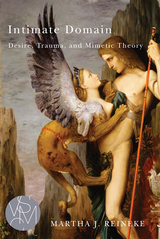 Intimate Domain: Desire, Trauma, and Mimetic Theory
Martha J. Reineke
Michigan State University Press, 2014 For René Girard, human life revolves around mimetic desire, which regularly manifests itself in acquisitive rivalry when we find ourselves wanting an object because another wants it also. Noting that mimetic desire is driven by our sense of inadequacy or insufficiency, Girard arrives at a profound insight: our desire is not fundamentally directed toward the other’s object but toward the other’s being. We perceive the other to possess a fullness of being we lack. Mimetic desire devolves into violence when our quest after the being of the other remains unfulfilled. So pervasive is mimetic desire that Girard describes it as an ontological illness. In Intimate Domain, Reineke argues that it is necessary to augment Girard’s mimetic theory if we are to give a full account of the sickness he describes. Attending to familial dynamics Girard has overlooked and reclaiming aspects of his early theorizing on sensory experience, Reineke utilizes psychoanalytic theory to place Girard’s mimetic theory on firmer ground. Drawing on three exemplary narratives—Proust’s In Search of Lost Time, Sophocles’s Antigone, and Julia Kristeva’s The Old Man and the Wolves—the author explores familial relationships. Together, these narratives demonstrate that a corporeal hermeneutics founded in psychoanalytic theory can usefully augment Girard’s insights, thereby ensuring that mimetic theory remains a definitive resource for all who seek to understand humanity’s ontological illness and identify a potential cure.
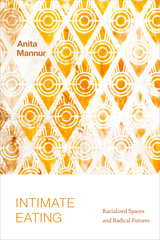 Intimate Eating: Racialized Spaces and Radical Futures
Anita Mannur
Duke University Press, 2022 In Intimate Eating Anita Mannur examines how notions of the culinary can create new forms of kinship, intimacy, and social and political belonging. Drawing on critical ethnic studies and queer studies, Mannur traces the ways in which people of color, queer people, and other marginalized subjects create and sustain this belonging through the formation of “intimate eating publics.” These spaces—whether established in online communities or through eating along in a restaurant—blur the line between public and private. In analyses of Julie Powell’s Julie and Julia, Nani Power’s Ginger and Ganesh, Ritesh Batra’s film The Lunchbox, Michael Rakowitz’s performance art installation Enemy Kitchen, and The Great British Bake Off, Mannur focuses on how racialized South Asian and Arab brown bodies become visible in various intimate eating publics. In this way, the culinary becomes central to discourses of race and other social categories of difference. By illuminating how cooking, eating, and distributing food shapes and sustains social worlds, Mannur reconfigures how we think about networks of intimacy beyond the family, heteronormativity, and nation.
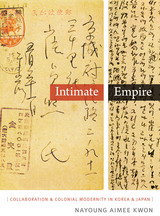 Intimate Empire: Collaboration and Colonial Modernity in Korea and Japan
Nayoung Aimee Kwon
Duke University Press, 2015 In Intimate Empire Nayoung Aimee Kwon examines intimate cultural encounters between Korea and Japan during the colonial era and their postcolonial disavowal. After the Japanese empire’s collapse in 1945, new nation-centered histories in Korea and Japan actively erased these once ubiquitous cultural interactions that neither side wanted to remember. Kwon reconsiders these imperial encounters and their contested legacies through the rise and fall of Japanese-language literature and other cultural exchanges between Korean and Japanese writers and artists in the Japanese empire. The contrast between the prominence of these and other forums of colonial-era cultural collaboration between the colonizers and the colonized, and their denial in divided national narrations during the postcolonial aftermath, offers insights into the paradoxical nature of colonial collaboration, which Kwon characterizes as embodying desire and intimacy with violence and coercion. Through the case study of the formation and repression of imperial subjects between Korea and Japan, Kwon considers the imbrications of colonialism and modernity and the entwined legacies of colonial and Cold War histories in the Asia-Pacific more broadly.
Intimate Enemies: Demonizing the Bolshevik Opposition, 1918-1928
Igal Halfin
University of Pittsburgh Press, 2007 Intimate Enemies is a brilliant study of the transformation of Bolshevik Party ideology, language, and power relations during the crucial period leading up to Stalin's seizure of power. Combining extensive research in recently opened Soviet archives with an insightful rereading of intra-Party struggles, Igal Halfin uncovers this evolution in the language of Bolshevism. This language defined the methods for judging true party loyalty-in what Halfin describes as an examination of the 'hermeneutics of the soul,' and became the basis for prosecuting the Party's enemies, particularly the “intimate enemies” within the Party itself. Halfin argues that Bolshevism-which claimed sole access to truth and morality-ultimately demonized its enemies, and became in effect a theology that facilitated a monumental power shift.
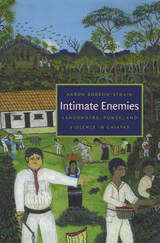 Intimate Enemies: Landowners, Power, and Violence in Chiapas
Aaron Bobrow-Strain
Duke University Press, 2007 Intimate Enemies is the first book to explore conflicts in Chiapas from the perspective of the landed elites, crucial but almost entirely unexamined actors in the state’s violent history. Scholarly discussion of agrarian politics has typically cast landed elites as “bad guys” with predetermined interests and obvious motives. Aaron Bobrow-Strain takes the landowners of Chiapas seriously, asking why coffee planters and cattle ranchers with a long and storied history of violent responses to agrarian conflict reacted to land invasions triggered by the Zapatista Rebellion of 1994 with quiescence and resignation rather than thugs and guns. In the process, he offers a unique ethnographic and historical glimpse into conflicts that have been understood almost exclusively through studies of indigenous people and movements. Weaving together ethnography, archival research, and cultural history, Bobrow-Strain argues that prior to the upheavals of 1994 landowners were already squeezed between increasingly organized indigenous activism and declining political and economic support from the Mexican state. He demonstrates that indigenous mobilizations that began in 1994 challenged not just the economy of estate agriculture but also landowners’ understandings of progress, masculinity, ethnicity, and indigenous docility. By scrutinizing the elites’ responses to land invasions in relation to the cultural politics of race, class, and gender, Bobrow-Strain provides timely insights into policy debates surrounding the recent global resurgence of peasant land reform movements. At the same time, he rethinks key theoretical frameworks that have long guided the study of agrarian politics by engaging political economy and critical human geography’s insights into the production of space. Describing how a carefully defended world of racial privilege, political dominance, and landed monopoly came unglued, Intimate Enemies is a remarkable account of how power works in the countryside.
 Intimate Friends: Women Who Loved Women, 1778-1928
Martha Vicinus
University of Chicago Press, 2004 Intimate Friends offers a fascinating look at the erotic friendships of educated English and American women over a 150-year period, culminating in the 1928 publication of The Well of Loneliness, Radclyffe Hall's scandalous novel of lesbian love. Martha Vicinus explores all-female communities, husband-wife couples, liaisons between younger and older women, female rakes, and mother-daughter affection. Women, she reveals, drew upon a rich religious vocabulary to describe elusive and complex erotic feelings.
Vicinus also considers the nineteenth-century roots of such contemporary issues as homosexual self-hatred, female masculinity, and sadomasochistic desire. Drawing upon diaries, letters, and other archival sources, she brings to life a variety of well known and historically less recognized women, ranging from the predatory Ann Lister, who documented her sexual activities in code; to Mary Benson, the wife of the Archbishop of Canterbury; to the coterie of wealthy Anglo-American lesbians living in Paris.
In vivid and colorful prose, Intimate Friends offers a remarkable picture of women navigating the uncharted territory of same-sex desire.
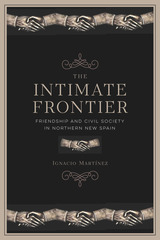 The Intimate Frontier: Friendship and Civil Society in Northern New Spain
Ignacio Martínez
University of Arizona Press, 2019 For millennia friendships have framed the most intimate and public contours of our everyday lives. In this book, Ignacio Martínez tells the multilayered story of how the ideals, logic, rhetoric, and emotions of friendship helped structure an early yet remarkably nuanced, fragile, and sporadic form of civil society (societas civilis) at the furthest edges of the Spanish Empire.
Spaniards living in the isolated borderlands region of colonial Sonora were keen to develop an ideologically relevant and socially acceptable form of friendship with Indigenous people that could act as a functional substitute for civil law and governance, thereby regulating Native behavior. But as frontier society grew in complexity and sophistication, Indigenous and mixed-raced people also used the language of friendship and the performance of emotion for their respective purposes, in the process becoming skilled negotiators to meet their own best interests.
In northern New Spain, friendships were sincere and authentic when they had to be and cunningly malleable when the circumstances demanded it. The tenuous origins of civil society thus developed within this highly contentious social laboratory in which friendships (authentic and feigned) set the social and ideological parameters for conflict and cooperation. Far from the coffee houses of Restoration London or the lecture halls of the Republic of Letters, the civil society illuminated by Martínez stumbled forward amid the ambiguities and contradictions of colonialism and the obstacles posed by the isolation and violence of the Sonoran Desert.
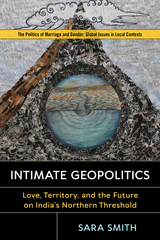 Intimate Geopolitics: Love, Territory, and the Future on India’s Northern Threshold
Sara Smith
Rutgers University Press, 2020 Winner of the 2021 Julian Minghi Distinguished Book Award from the American Association of Geographers
2021 Foreword Indies Finalist - Politics and Social Sciences
Intimate Geopolitics begins with a love story set in the Himalayan region of Ladakh, in India’s Jammu and Kashmir State, but this is also a story about territory, and the ways that love, marriage, and young people are caught up in contemporary global processes. In Ladakh, children grow up to adopt a religious identity in part to be counted in the census, and to vote in elections. Religion, population, and voting blocs are implicitly tied to territorial sovereignty and marriage across religious boundaries becomes a geopolitical problem in an area that seeks to define insiders and outsiders in relation to borders and national identity. This book populates territory, a conventionally abstract rendering of space, with the stories of those who live through territorial struggle at marriage and birth ceremonies, in the kitchen and in the bazaar, in heartbreak and in joy. Intimate Geopolitics argues for the incorporation of the role of time–temporality–into our understanding of territory.
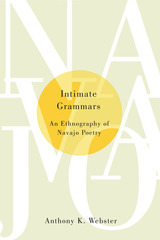 Intimate Grammars: An Ethnography of Navajo Poetry
Anthony K. Webster
University of Arizona Press, 2015 On April 24, 2013, Luci Tapahonso became the first poet laureate of the Navajo Nation, possibly the first Native American community to create such a post. The establishment of this position testifies to the importance of Navajo poets and poetry to the Navajo Nation. It also indicates the Navajo equivalence to the poetic traditions connected with the U.S. poet laureate and the poet laureate of the United Kingdom, author Anthony K. Webster asserts, as well as its separateness from those traditions.
Intimate Grammars takes an ethnographic and ethnopoetic approach to language and culture in contemporary time, in which poetry and poets are increasingly important and visible in the Navajo Nation. Webster uses interviews and linguistic analysis to understand the kinds of social work that Navajo poets engage in through their poetry.
Based on more than a decade of ethnographic and linguistic research, Webster’s book explores a variety of topics: the emotional value assigned to various languages spoken on the Navajo Nation through poetry (Navajo English, Navlish, Navajo, and English), why Navajo poets write about the “ugliness” of the Navajo Nation, and the way contemporary Navajo poetry connects young Navajos to the Navajo language. Webster also discusses how contemporary Navajo poetry challenges the creeping standardization of written Navajo and how boarding school experiences influence how Navajo poets write poetry and how Navajo readers appreciate contemporary Navajo poetry.
Through the work of poets such as Luci Tapahonso, Laura Tohe, Rex Lee Jim, Gloria Emerson, Blackhorse Mitchell, Esther Belin, Sherwin Bitsui, and many others, Webster provides new ways of thinking about contemporary Navajo poets and poetry. Intimate Grammars offers an exciting new ethnography of speaking, ethnopoetics, and discourse-centered examinations of language and culture.
Intimate Indigeneities: Race, Sex, and History in the Small Spaces of Andean Life
Andrew Canessa
Duke University Press, 2012 Drawing on extended ethnographic research conducted over the course of more than two decades, Andrew Canessa explores the multiple identities of a community of people in the Bolivian highlands through their own lived experiences and voices. He examines how gender, race, and ethnic identities manifest themselves in everyday interactions in the Aymara village. Canessa shows that indigeneity is highly contingent; thoroughly imbricated with gendered, racial, and linguistic identities; and informed by a historical consciousness. Addressing how whiteness and indianness are reproduced as hegemonic structures in the village, how masculinities develop as men go to the mines and army, and how memories of a violent past are used to construct a present sense of community, Canessa raises important questions about indigenous politics and the very nature of indigenous identity.
 Intimate Industries: Restructuring (Im)Material Labor in Asia
Rhacel Parreñas, Hung Cam Thai and Rachel Silvey, special issue editors
Duke University Press This issue addresses how laborers within intimate industries—those who do interpersonal work that tends to the sexual, bodily, health, hygiene, or care needs of individuals—are shaping Asia’s growing role in the global economy. The contributors investigate how intimate industries support relational connections for consumers while disrupting laborers’ relationships, as in the case of migrants who perform intimate labor away from their families and communities of origin. The articles collected here include examinations of such trade-offs and their complex meanings and implications for the workers. The authors explore these social processes through the lens of industries that organize, enable, or delimit the trade in domestic labor, marriage migration, companionship and romance, sex work, pornographic performance, surrogate mothering and ova donation, and cosmetics sales. This issue puts people, as embodied subjects, back into narratives of economic change and offers a perspective on globalization from below. Contributors: Danièle Bélanger, Hae Yeon Choo, Nicole Constable, Daisy Deomampo, Akhil Gupta, Chaitanya Lakkimsetti, Pei-Chia Lan, Purnima Mankekar, Eileen Otis, Juno Salazar Parreñas, Rhacel Parreñas, Sharmila Rudrappa, Celine Parreñas Shimizu, Rachel Silvey, Hung Cam Thai, Leslie Wang
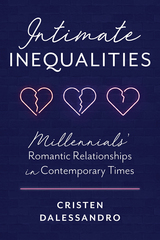 Intimate Inequalities: Millennials' Romantic Relationships in Contemporary Times
Cristen Dalessandro
Rutgers University Press, 2021 When it comes to the topic of romantic and sexual intimacy, social observers are often quick to throw criticisms at millennials. However, we know little about millennials’ own hopes, fears, struggles, and triumphs in their relationships from the perspectives of millennials themselves. Intimate Inequalities uses millennials’ own stories to explore how they navigate gender, race, social class, sexuality, and age identities and expectations in their relationships. Situating millennials’ lives within contemporary social and cultural conditions in the United States, Intimate Inequalities takes an intersectional approach to examining how millennials challenge—or rather, uphold—social inequalities in their lives as they come into their own as full adults. Intimate Inequalities provides an in-depth look into the intimate lives of one group of millennials living in the United States, demystifying what actually goes on behind closed doors, and arguing that millennials’ private lives can reveal much about their ability to navigate inequalities in their lives more broadly.
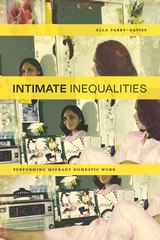 Intimate Inequalities: Performing Migrant Domestic Work
Ella Parry-Davies
Northwestern University Press, 2025 Mobilizing performance to amplify migrant domestic workers’ creative expertise
Intimate inequalities exist where the embodied and the everyday rub up against transnational structures of power. Ella Parry-Davies conducted collaborative research with migrant domestic workers from the Philippines living in the UK and Lebanon, where migration is regulated by employer sponsorship systems, to explore how they negotiate the intimacy of the family home and the attendant inequalities of laboring within it. Intimate Inequalities: Performing Migrant Domestic Work brings these conditions into focus while articulating a methodological inquiry into the dynamics of collaborative performance research. Parry-Davies examines site-specific soundwalks, recorded and coedited with domestic workers, which steer the book between church choirs in Beirut and activist gatherings in London, and from urban performances in Lebanon’s 2019 revolution to mutual aid organizing amid COVID-19 in the UK. Breaking with prevalent depictions of migrant domestic workers as voiceless and victimized, Intimate Inequalities mobilizes performance as both an analytic lens and a practical methodology, amplifying its subjects’ expertise while reckoning with the intimate yet unequal dynamics of research itself.
 The Intimate Life of Computers: Digitizing Domesticity in the 1980s
Reem Hilu
University of Minnesota Press, 2024 A feminist perspective on the early history of personal computing, revealing how computers were integrated into the most intimate aspects of family life
The Intimate Life of Computers shows how the widespread introduction of home computers in the 1980s was purposefully geared toward helping sustain heteronormative middle-class families by shaping relationships between users. Moving beyond the story of male-dominated computer culture, this book emphasizes the neglected history of the influence of women’s culture and feminist critique on the development of personal computing despite women’s underrepresentation in the industry. Proposing the notion of “companionate computing,” Reem Hilu reimagines the spread of computers into American homes as the history of an interpersonal, romantic, and familial medium. She details the integration of computing into family relationships—from helping couples have better sex and offering thoughtful simulations of masculine seduction to animating cute robot companions and giving voice to dolls that could talk to lonely children—underscoring how these computer applications directly responded to the companionate needs of their users as a way to ease growing pressures on home life. The Intimate Life of Computers is a vital contribution to feminist media history, highlighting how the emergence of personal computing dovetailed with changing gender roles and other social and cultural shifts. Eschewing the emphasis on technologies and institutions typically foregrounded in personal-computer histories, Hilu uncovers the surprising ways that domesticity and family life guided the earlier stages of our all-pervasive digital culture.
|
|
